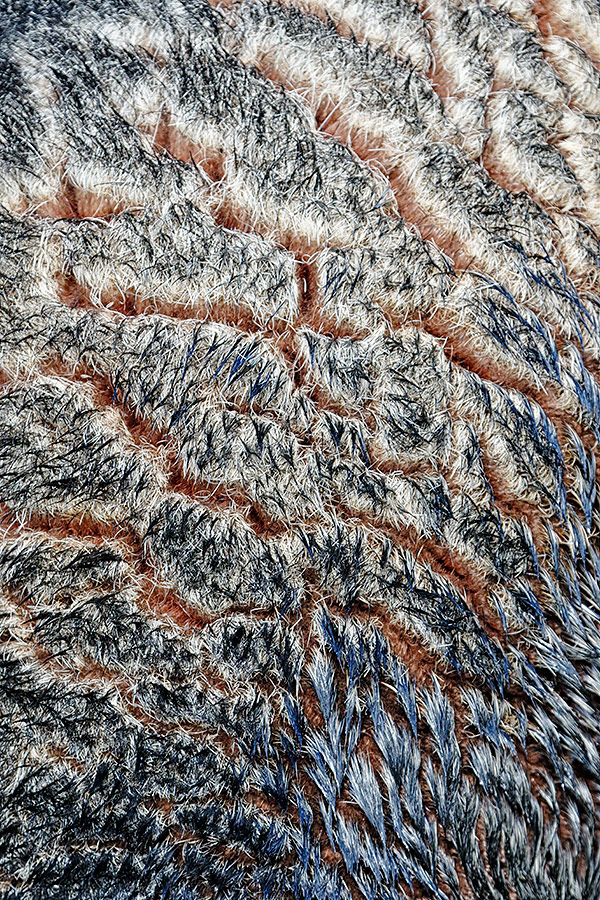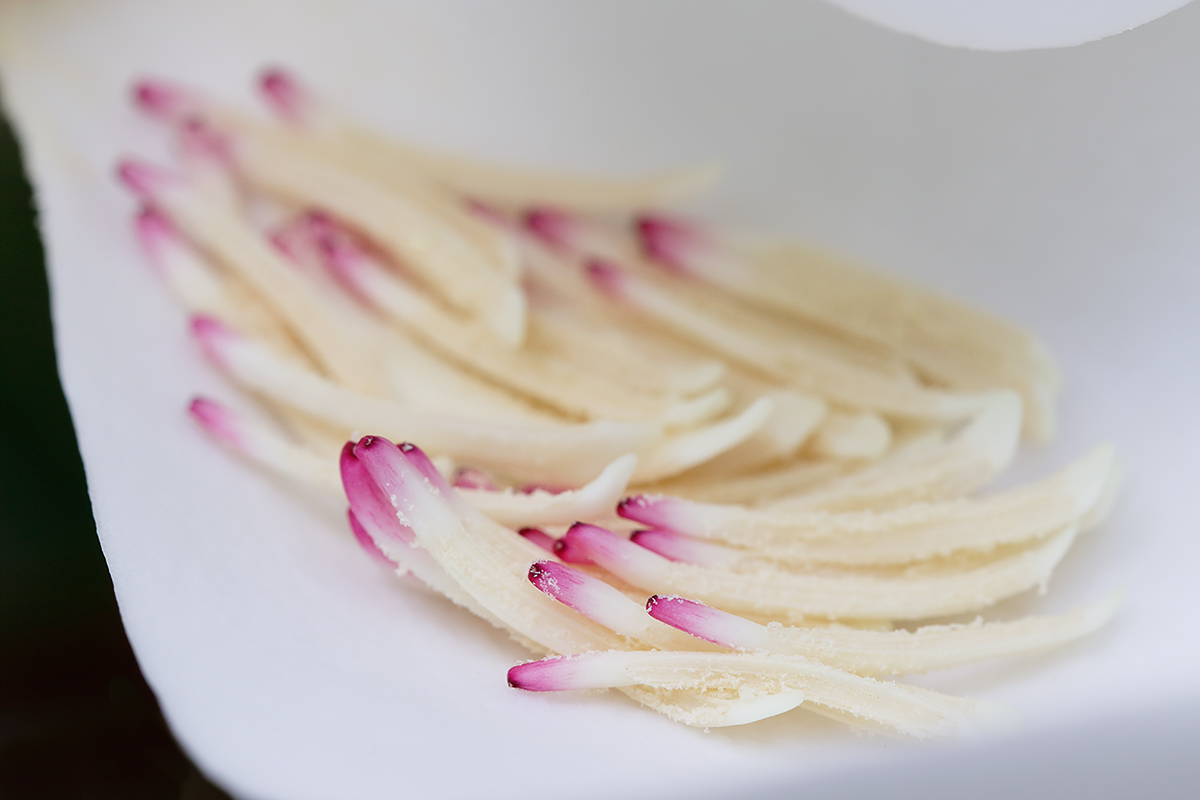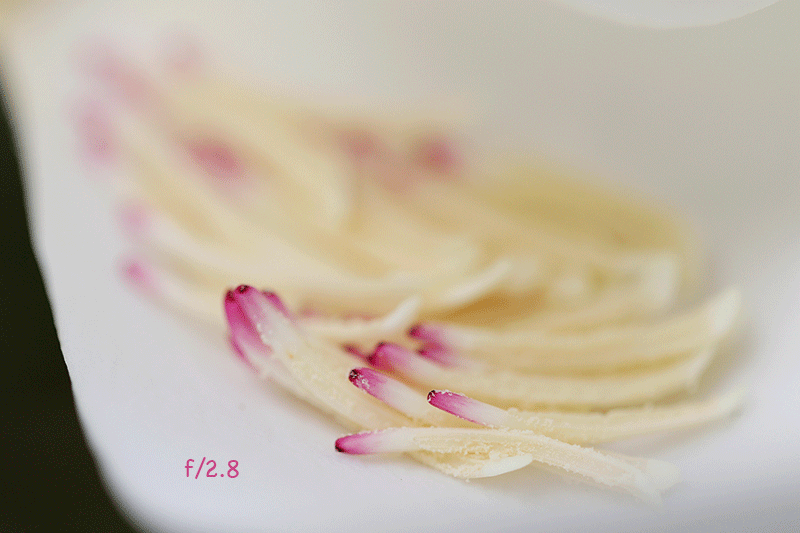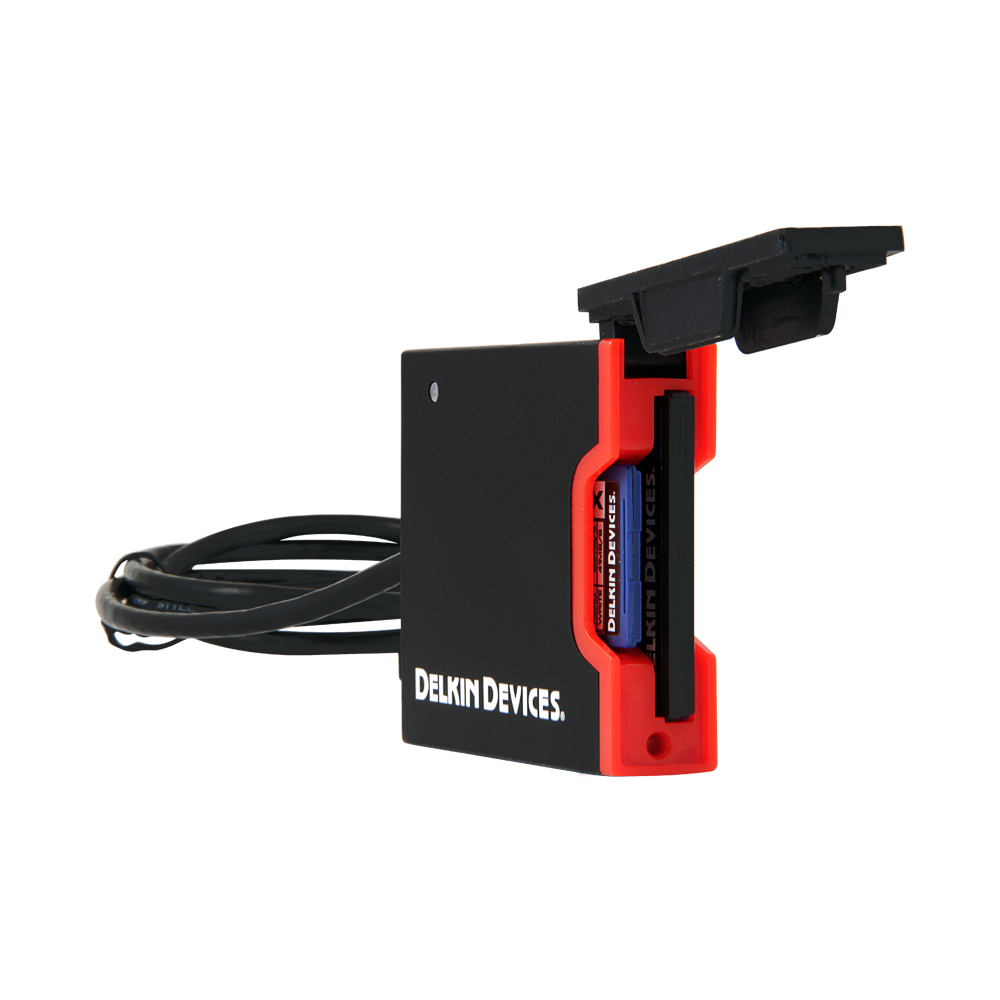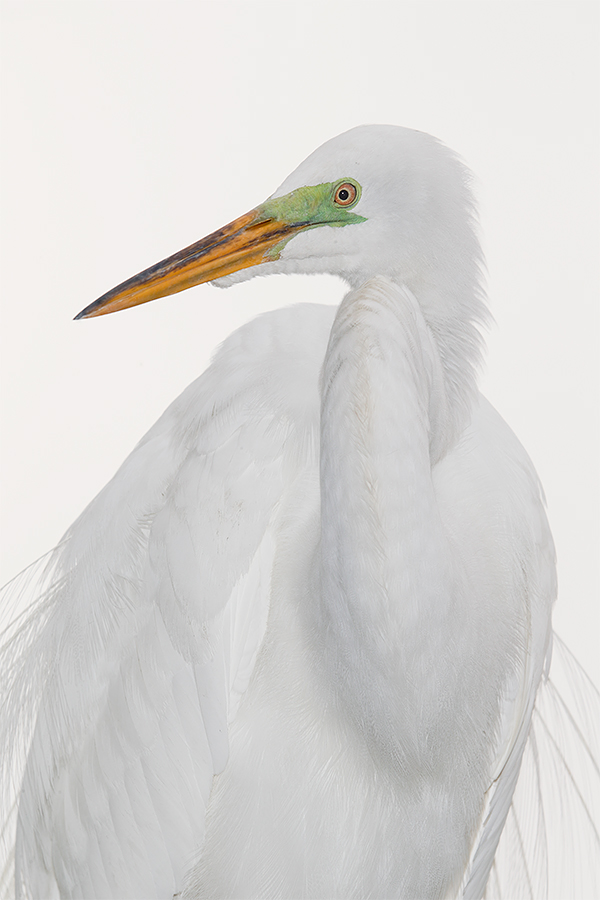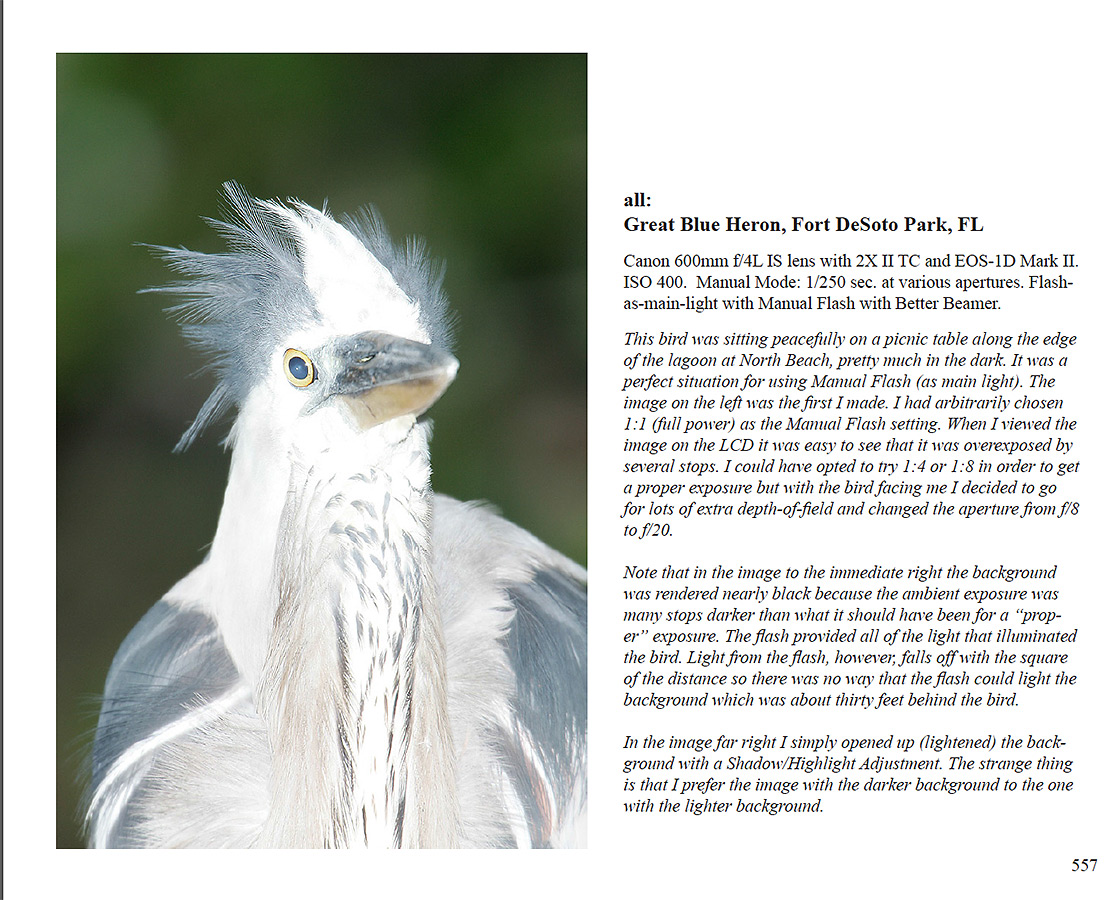May 24th, 2015 What’s Up?
Today was a lazy day. I spent a few hours getting together some new used photo gear listings. Coming soon: my friend Todd Gustafson is selling a complete Nikon kit (600, 300 2.8, 200-400 II, D4, 4 TCEs, and lots more) as he is switching to Canon. If you are on the dark side and would like to see an advance listing please shoot me an e-mail with the words Toddi’s Nikon Gear cut and pasted into the Subject line.
When I exited my ice bath the temperature was 59.5 degrees F but I thought that it was much colder because I was shivering for the whole 44 minutes. Not sure why.
If you missed “A Comparison: The Canon EF 70-200mm f/2.8L IS II with TCs vs the EF 100-400mm f/4.5-5.6L IS II,” be sure to see item one here.
This blog post, the 136th in a row, took about an hour to prepare. It was published automatically just after midnight on Sunday.
Used Photography Gear for Sale
There has been lots of action on the Used Photography Gear page here. Stuff has been flying off the virtual shelves here almost every day; the following items have sold within the past week:
Canon EF 300mm f/2.8L IS II USM lens sold for $4999 by Jacques Bouvier on May 20, 2015.
Canon EF 70-200mm f/2.8L IS II sold by Carl Zanoni for $1649 on May 19, 2015.
Canon EF 100-400mm f/4.5-5.6L IS USM sold by Owen Peller for $799 on 5/19/15.
Canon EOS-1D Mark IV sold by Gerald Barrack for $1599 in May, 2015.
Canon EOS 7D DSLR Digital Camera Body (with battery grip) sold for $579 by Barbara Garmon on May 23, 2015.
In addition, a sale is pending on Barbara Garmon’s old 100-400.
Selling Your Used Photo Gear Through BIRDS AS ART
Selling your used (or like-new) photo gear through the BAA Blog or via a BAA Online Bulletin is a great idea. We charge only a 5% commission. One of the more popular used gear for sale sites charges a minimum of 20%. Plus assorted fees! Yikes. The minimum item price here is $500 (or less for a $25 fee). If you are interested please e-mail with the words Items for Sale Info Request cut and pasted into the Subject line :). Stuff that is priced fairly–I offer free pricing advice, usually sells in no time flat. In the past few months, we have sold just about everything in sight. Do know that prices on some items like the EOS-1D Mark IV, the old Canon 500mm, the EOS-7D, and the original 400mm IS DO lens have been dropping steadily.
Brand New Listings: these should sell instantly!
Canon 400mm f/4 IS DO USM Lens
Stephan R. Leimberg is offering a used Canon 400mm f/4 IS DO USM Lens in excellent condition for $3699–another BAA lowest-price-ever for this item. The sale includes the rear lens cap, the leather front hood, the original case, and insured shipping via UPS Ground. Please contact Steve via e-mail or phone at 904-491-0474 (eastern time). Please e-mail for photos. Your item will not ship until your check clears unless other arrangements are made.
I used this lens for several years with great success, especially for birds in flight and when working from various type of water craft. Gannets in Love was created with the 400 DO. You can that one and 13 other killer images that I made with my 400 DO here. The title of that blog post is “The Canon 400mm f/4 IS DO Lens: Fourteen Images that Prove that the Internet Experts are Idiots.”
Canon 500mm f/4L IS II USM Lens
Clemens Vanderwerf is offering a Canon 500mm/f4L IS II USM lens in near-mint excellent plus condition for $7,999.The lens was only used once during a trip to South Georgia in October 2012. The sale includes the LensCoat that has been on it since day one, an off-brand replacement foot, the fabric front cover, the rear lens cap, the lens strap, the warranty certificate, the lens booklet, the original box with everything that came in it, and insured UPS ground shipping to the lower 48 states. Your item will not ship until your check clears unless other arrangements are made.
This lens is super sharp and light. There is not a single scratch, ding, or chip anywhere on the paint.
Please contact Clemens via e-mail or phone at 954 608 8704 (eastern time).
I owned this lens and loved it and with the reach advantage of the 7D Mark II I am thinking hard about selling my 600 II and getting the new five….
Canon 300mm f/2.8L IS II USM Lens
Kevin Hice is offering a used Canon 300mm f/2.8L IS II USM lens in excellent plus condition for a lowest-price-ever $4750. The sale includes the LensCoat that has been on it since day one, the lens trunk 300B (with a few insignificant scuffs), the fabric front cover, the rear lens cap, the lens strap, the CD, the original box with everything that came in it, and insured shipping via UPS Ground. Your item will not ship until your check clears unless other arrangements are made.
This lens is super sharp and great in low light. No scratches or chips on the paint even on the tripod foot.
Please contact Kevin via e-mail or phone at 701 460 6112 (central time).
I own and use the amazing lens often. It is great for hand holding and for flight, with or without either the 1.4X III or the 2X III TC. In all cases it is amazingly sharp in competent hands. Outdoor Photographer editor Rob Sheppard was stunned by the sharpness of my allo-preening Macaroni Penguins image that was created with the 300 II and the 2X III TC.
Featured Item
Canon EF 180mm f/3.5L USM Macro Lens
Price reduced $100 on 2/20/2015!
Multiple IPT veteran Carl Zanoni is also offering a used Canon EF 180mm f/3.5 USM macro lens in like new condition for $1075. The sale includes the E-72 II 72mm (front) lens cap, the (rear) lens dust cap E, the ET-78 II lens hood, Tripod Mount Ring B (tripod collar), the LZ1324 lens case, the original box, and insured shipping via UPS Ground to US addresses. Your item will not ship until your check clears unless other arrangements are made.
Please contact Carl by e-mail or by phone at 860 306 9651 (eastern time).
I have owned and used the 180 macro for more than 10 years. It is the primo telephoto macro lens. It is sharp with and without a 1.4X TC. It offers a narrow field of view that goes a long way to eliminating back distracting background element. It is great for flowers and all sorts of bugs, butterflies, and dragonflies as well as for frogs and toads.
What Is It?
If this is an aerial photograph, where in the world do you think it was taken?
If this is a bird, what family do you think it is part of?
If this is an animal, what species do you think it is?
Or is it none of the above?
If none of the above, then what is it?
Facebook
Be sure to like and follow BAA on Facebook by clicking on the logo link upper right. Tanks a stack!
Support the BAA Blog. Support the BAA Bulletins: Shop B&H here!
We want and need to keep providing you with the latest free information, photography and Photoshop lessons, and all manner of related information. Show your appreciation by making your purchases immediately after clicking on any of our B&H or Amazon Affiliate links in this blog post. Remember, B&H ain’t just photography!
…..
Amazon.com
Those who prefer to support BAA by shopping with Amazon may use this link:
Amazon Canada
Many kind folks from north of the border, eh, have e-mailed stating that they would love to help us out by using one of our affiliate links but that living in Canada and doing so presents numerous problems. Now, they can help us out by using our Amazon Canada affiliate link by starting their searches by clicking here. Many thanks to those who have written.
Typos
In all blog posts and Bulletins, feel free to e-mail or to leave a comment regarding any typos or errors. Just be right :).
May 23rd, 2015 Stuff
Got more done on my 2014 tax return on Friday; to me, doing my business taxes is like doing a jigsaw puzzle…. Put in one piece at a time and if you keep at it you will finish. Due to a snafu my ice bath was a balmy 65 degrees when I exited. This blog post, the 135th in a row, took about 2 1/2 hours to prepare. It was published automatically just after midnight on Saturday.
BIRDS AS ART BULLETIN #475
BIRDS AS ART BULLETIN #475 is online and can be accessed here. Item 1, A Comparison: The Canon EF 70-200mm f/2.8L IS II with TCs versus the EF 100-400mm f/4.5-5.6L IS II, should be of special interest to blog folks. When you visit, be sure to take a crack at the exposure question.
- A Comparison: The Canon EF 70-200mm f/2.8L IS II with TCs vs the EF 100-400mm f/4.5-5.6L IS II
- DPP 4 Educational Screen Capture
- The DPP 4 eGuide
- The 7D Mark II User’s Guide
- Used Photography Gear for Sale
- South Georgia October 2015
- BIRDS AS ART Instructional Photo-Tour (IPT) Info
- Your Help Needed and Appreciated/Affiliate Stuff
Used Photography Gear for Sale
There has been lots of action on the Used Photography Gear page here. The following items sold within the past week:
Canon EF 300mm f/2.8L IS II USM lens sold for $4999 by Jacques Bouvier on May 20, 2015.
Canon EF 70-200mm f/2.8L IS II sold by Carl Zanoni for $1649 on May 19, 2015.
Canon EF 100-400mm f/4.5-5.6L IS USM sold by Owen Peller for $799 on 5/19/15.
Canon EOS-1D Mark IV sold by Gerald Barrack for $1599 in May, 2015.
Canon EOS 7D DSLR Digital Camera Body (with battery grip) sold for $579 by Barbara Garmon on May 23, 2015.
In addition, a sale is pending on Barbara Garmon’s old 100-400.
Selling Your Used Photo Gear Through BIRDS AS ART
Selling your used (or like-new) photo gear through the BAA Blog or via a BAA Online Bulletin is a great idea. We charge only a 5% commission. One of the more popular used gear for sale sites charges a minimum of 20%. Plus assorted fees! Yikes. The minimum item price here is $500 (or less for a $25 fee). If you are interested please e-mail with the words Items for Sale Info Request cut and pasted into the Subject line :). Stuff that is priced fairly–I offer free pricing advice, usually sells in no time flat. In the past few months, we have sold just about everything in sight. Do know that prices on some items like the EOS-1D Mark IV, the old Canon 500mm, the EOS-7D, and the original 400mm IS DO lens have been dropping steadily.
Brand New Listing: this one should sell instantly!
Canon 300mm f/2.8L IS II USM Lens
Kevin Hice is offering a used Canon 300mm f/2.8L IS II USM lens in excellent plus condition for a lowest-price-ever $4750. The sale includes the LensCoat that has been on it since day one, the lens trunk 300B (with a few insignificant scuffs), the fabric front cover, the rear lens cap, the lens strap, the CD, the original box with everything that came in it, and insured shipping via UPS Ground. Your item will not ship until your check clears unless other arrangements are made.
This lens is super sharp and great in low light. No scratches or chips on the paint even on the tripod foot.
Please contact Kevin via e-mail or phone at 701 460 6112 (central time).
I own and use the amazing lens often. It is great for hand holding and for flight, with or without either the 1.4X III or the 2X III TC. In all cases it is amazingly sharp in competent hands. Outdoor Photographer editor Rob Sheppard was stunned by the sharpness of my allo-preening Macaroni Penguins image that was created with the 300 II and the 2X III TC.
Featured Item
Canon EF 180mm f/3.5L USM Macro Lens
Price reduced $100 on 2/20/2015!
Multiple IPT veteran Carl Zanoni is also offering a used Canon EF 180mm f/3.5 USM macro lens in like new condition for $1075. The sale includes the E-72 II 72mm (front) lens cap, the (rear) lens dust cap E, the ET-78 II lens hood, Tripod Mount Ring B (tripod collar), the LZ1324 lens case, the original box, and insured shipping via UPS Ground to US addresses. Your item will not ship until your check clears unless other arrangements are made.
Please contact Carl by e-mail or by phone at 860 306 9651 (eastern time).
I have owned and used the 180 macro for more than 10 years. It is the primo telephoto macro lens. It is sharp with and without a 1.4X TC. It offers a narrow field of view that goes a long way to eliminating back distracting background element. It is great for flowers and all sorts of bugs, butterflies, and dragonflies as well as for frogs and toads.
The Motivation and the Creation
Denise Ippolito spotted some really low down magnolia flowers. In the past, she had taught me to appreciate dying, dead, or decaying flowers. In today’s featured image I photographed a small, somewhat neatly arranged pile of stalks that had fallen from the decaying carpel. The stalks, if that is the right term for them, were lying in the curved petal of the dead flower. The pinks and purples set against the whitish grey of the petals is an attractive combination for many.
It took quite a while to get the image framed as I wanted it. As the leaf-covered ground was less than firm and there was a pretty good breeze I was constantly adjusting things to achieve halfway decent framing. As I wanted to stay at ISO 400 I utilized my Av mode/Live View/2-second timer flower technique. Once I started creating some images that looked OK on the back of the camera I decided that I would run the aperture table by creating images at full stop intervals from f/2.8 to f/22. You can see the results and learn a stack in the animated GIF below.
The Animated Depth-of-Field GIF
Let the animated GIF above run through a full cycle or two, from f/2.8 through f/22 as follows: f/2.8, f/4, f/5.6, f/8, f/11, f/16, and f/22. The slight variations in framing were a result of the soft ground and the wind. The seven images in the animated GIF were created from the extracted JPEGs. Differences in exposure and in color balance were due to the sun coming in and out; this affected things even though the flowers were basically in the shade.
As the apertures get smaller and smaller as the GIF plays the differences in depth-of-field between the individual frames seem quite small. Until you go from f/22 back to f/2.8 where the relatively huge difference becomes dramatic. At first I liked the image created at f/4 best but I wound up optimizing the one made at f/.8.
The lesson here is that at close range with relatively high magnification the increases in depth-of-field as you go from one f/stop to the next are very small, but that the difference between f/2.8 and f/22 (six f/stops) is quite significant.
According to Depth-of-field Master.com, depth of field with the 7D II and the 100 macro at ten inches is 7/100 inch at f/8. That drops to 3/100 inch at f/2.8 and increases to only 21/100 inch (just a smidgeon more than 1/5 of a single inch) at f/22.
Important Realization…
Do understand that though there is a big difference in the look of the images at f/2.8 and f/22 that the bulk of that has to do with bringing up background detail rather than actual depth of field. As each stalk was about 1/2 inch (.5) long a total d-o-f of .2 inches does not cover a very large zone of sharp focus.
Your Favorite Aperture?
All things (exposure, sharpness, and color temperature) considered, which aperture do think yielded the nicest image? Do let us know why.
Facebook
Be sure to like and follow BAA on Facebook by clicking on the logo link upper right. Tanks a stack!
Support the BAA Blog. Support the BAA Bulletins: Shop B&H here!
We want and need to keep providing you with the latest free information, photography and Photoshop lessons, and all manner of related information. Show your appreciation by making your purchases immediately after clicking on any of our B&H or Amazon Affiliate links in this blog post. Remember, B&H ain’t just photography!
…..
Amazon.com
Those who prefer to support BAA by shopping with Amazon may use this link:
Amazon Canada
Many kind folks from north of the border, eh, have e-mailed stating that they would love to help us out by using one of our affiliate links but that living in Canada and doing so presents numerous problems. Now, they can help us out by using our Amazon Canada affiliate link by starting their searches by clicking here. Many thanks to those who have written.
Typos
In all blog posts and Bulletins, feel free to e-mail or to leave a comment regarding any typos or errors. Just be right :).
May 22nd, 2015 Stuff
Got lots done on my 2014 tax return on Thursday. Not sure what else I got accomplished but I was busy. Shivered after my 59 degree on the way out ice bath and then another evening of NHL and NBA playoffs. This blog post, the 134th in a row, took about 1 1/2 hours to prepare. It should be published automatically just after midnight on Friday.
Used Photography Gear Stuff
There has been lots of action on the Used Photography Gear page here. The following items sold within the past week:
Canon EF 300mm f/2.8L IS II USM lens sold for $4999 by Jacques Bouvier on May 20, 2015.
Canon EF 70-200mm f/2.8L IS II sold by Carl Zanoni for $1649 on May 19, 2015.
Canon EF 100-400mm f/4.5-5.6L IS USM sold by Owen Peller for $799 on 5/19/14.
In addition, a sale is pending on Barbara Garmon’s 7D.
Selling Your Used Photo Gear Through BIRDS AS ART
Selling your used (or like-new) photo gear through the BAA Blog or via a BAA Online Bulletin is a great idea. We charge only a 5% commission. One of the more popular used gear for sale sites charges a minimum of 20%. Plus assorted fees! Yikes. The minimum item price here is $500 (or less for a $25 fee). If you are interested please e-mail with the words Items for Sale Info Request cut and pasted into the Subject line :). Stuff that is priced fairly–I offer free pricing advice, usually sells in no time flat. In the past few months, we have sold just about everything in sight. Do know that prices on some items like the EOS-1D Mark IV, the old Canon 500mm, the EOS-7D, and the original 400mm IS DO lens have been dropping steadily.
Used Gear Cautions
Though I am not in a position to post images of gear for sale here or elsewhere, prospective buyers are encouraged to request for photos of the gear that they are interested in purchasing via e-mail. Doing so will help to avoid any misunderstandings as to the condition of the gear. Sellers are advised to take care to photograph their used gear with care against clean backgrounds so that the stuff is represented accurately and in the best light; please pardon the pun :).
|
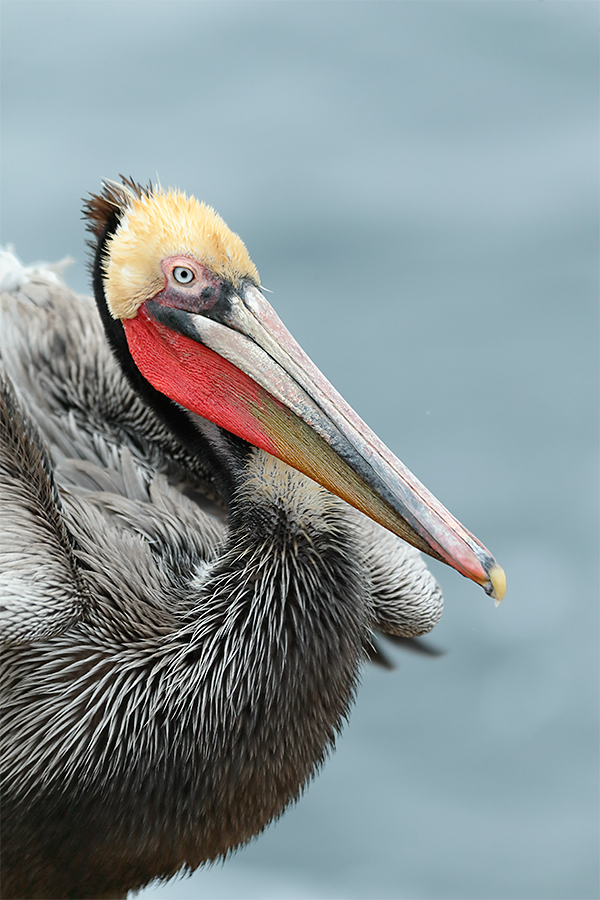
|
|
This image was created on the San Diego IPT with the tripod-mounted Canon EF 200-400mm f/4L IS USM lens with Internal 1.4x Extender (with the internal TC in place at 560mm) and the Canon EOS-1D X . ISO 800. Evaluative metering +1 stop: 1/800 sec. at f/5.6 was about a one stop underexposure.
Upper Zone AF/Rear Focus AF selected a single AF point two AF points above the center AF point as framed that was active at the moment of exposure. Click here to see the latest version of the Rear Focus Tutorial.
Brown Pelican ruffling; vertical front-end portrait in pre-dawn light
|
In Love With Pelicans
The Pacific race of Brown Pelican with their bright red and olive green bill pouches has been one of my very favorite avian subjects for close to three decades now.
The Image Optimization
Though I did zero clean-up on this image I spent more than 30 minutes optimizing it. The bulk of the lightening was done during the RAW conversion in DPP with the Brightness and Shadow sliders. A color temperature of 6000K looked best. I used Arash Hazeghi’s luminance and chrominance values for the 1D X at ISO 1600; they worked superbly as expected. All as detailed in our DPP 4 Guide.
During 25 minutes in Photoshop I selectively applied my NIK 50-50 Color Efex Pro recipe to the bird only painting it away at varying opacities after applying a Regular Layer Mask. Next was a slight Linear Burn on the bright feathers of the upper back near the left frame edge. Then I selected the face and bill using the Quick Selection Tool (as I did when selecting the whole bird above) and applied a Contrast Mask. As I often do, I lightened that layer by pulling up the curve. I finished up the image by lightening it with a Curves adjustment after first pinning the brightest tones by putting two points on the upper right section of the curve. All of the above is of course detailed in Digital Basics.
The 1D X Advantage
When it comes to accurate color, clean, high quality image files, and control of high ISO noise the Canon EOS-1D X (and the 5D Mark III as well) have it all over the 7D Mark II. Period.
|
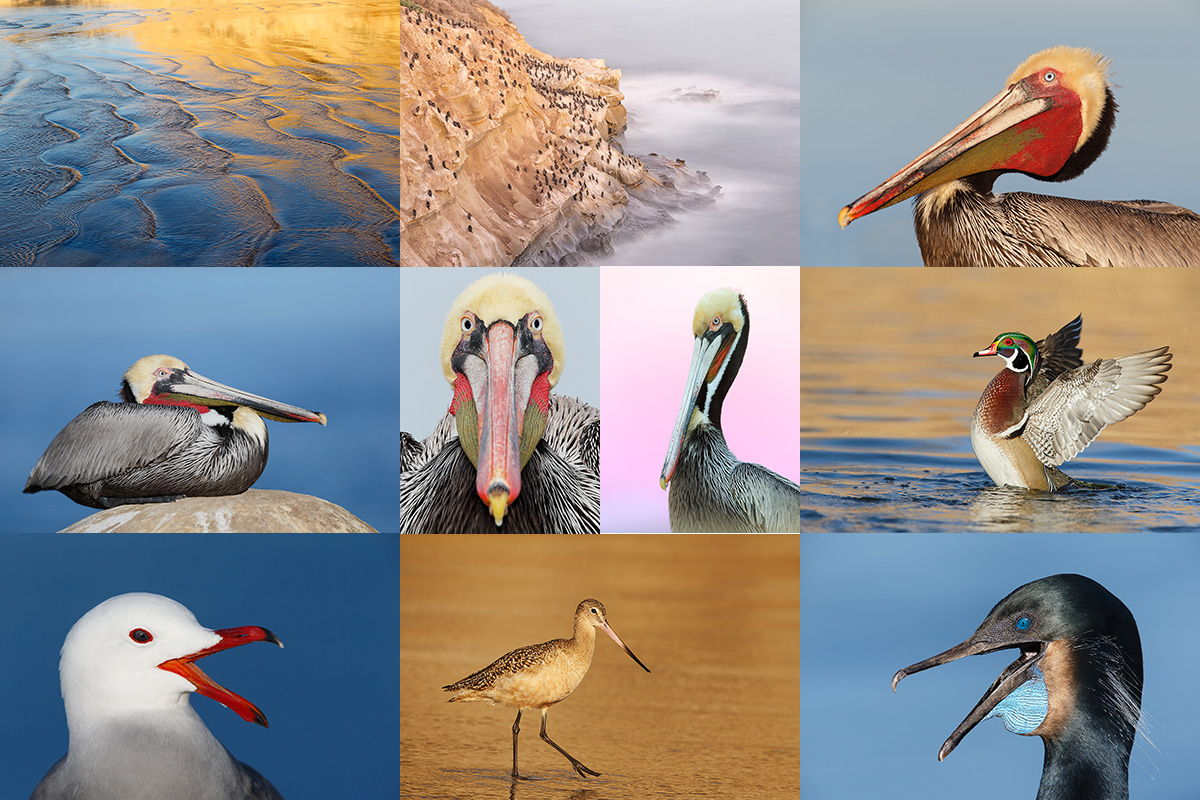
|
|
San Diego offers a wealth of very attractive natural history subjects. With annual visits spanning more than three decades I have lot of experience there….
|
2015 San Diego 4 1/2-DAY BIRDS AS ART Instructional Photo-Tour (IPT) JAN 8 thru the morning of JAN 12, 2016: $1899 (Limit: 10)
Meet and Greet at 7:00pm on the day before the IPT begins
Two great leaders: Arthur Morris and Denise Ippolito
Join us in San Diego to photograph the spectacular breeding plumage Brown Pelicans with their fire-engine red and olive green bill pouches; Brandt’s and Double-crested Cormorants in breeding plumage with their amazing crests; breeding plumage Wood and Ring-necked Duck; other species possible including Lesser Scaup, Redhead, and Surf Scoter; a variety of gulls including Western, California, and the gorgeous Heerman’s, all in full breeding plumage; shorebirds including Marbled Godwit, Willet, Sanderling and Black-bellied Plover; many others possible including Least, Western, and Spotted Sandpiper, Whimbrel, Black and Ruddy Turnstone, Semipalmated Plover, and Surfbird; Harbor Seals (depending on the current regulations) and California Sea Lions likely; and Bird of Paradise flowers. And as you can see by studying the two IPT cards there are some nice landscape opportunities as well.
Did I mention that there are wealth of great birds and natural history subjects in San Diego in winter?
This IPT will include five 3 1/2 hour morning photo sessions, four 2 1/2 hour afternoon photo sessions, five lunches, after-lunch image review and Photoshop sessions, and a thank you dinner. To ensure early starts, breakfasts will be your responsibility.
A $499 non-refundable deposit is required to hold your slot for this IPT. You can send a check (made out to “Arthur Morris) to us at BIRDS AS ART, PO Box 7245, Indian Lake Estates, FL, 33855. Or call Jim or Jennifer at the office with a credit card at 863-692-0906. Your balance, payable only by check, will be due on 11/1//2015. If we do not receive your check for the balance on or before the due date we will try to fill your spot from the waiting list. Please print, complete, and sign the form that is linked to here and shoot it to us along with your deposit check. If you register by phone, please print, complete and sign the form as noted above and either mail it to us or e-mail the scan. If you have any questions, please feel free to contact me via e-mail.
|

|
|
Though the pelicans will be the stars of the show on this IPT there will be many other handsome and captivating subjects in wonderful settings.
|
Facebook
Be sure to like and follow BAA on Facebook by clicking on the logo link upper right. Tanks a stack!
Support the BAA Blog. Support the BAA Bulletins: Shop B&H here!
We want and need to keep providing you with the latest free information, photography and Photoshop lessons, and all manner of related information. Show your appreciation by making your purchases immediately after clicking on any of our B&H or Amazon Affiliate links in this blog post. Remember, B&H ain’t just photography!
…..
Amazon.com
Those who prefer to support BAA by shopping with Amazon may use this link:
Amazon Canada
Many kind folks from north of the border, eh, have e-mailed stating that they would love to help us out by using one of our affiliate links but that living in Canada and doing so presents numerous problems. Now, they can help us out by using our Amazon Canada affiliate link by starting their searches by clicking here. Many thanks to those who have written.
Typos
In all blog posts and Bulletins, feel free to e-mail or to leave a comment regarding any typos or errors. Just be right :).
May 21st, 2015 Stuff
I made some serious progress on my 2014 taxes today. After my long unplanned nap on Tuesday night I wound up staying up until after 2:00am watching the Chicago Blackhawks amazing triple overtime victory over the Anaheim Ducks. I e-mail older daughter Jennifer at 2:15am just before heading to bed. I was stunned to receive an immediate reply. She had stayed up to watch the whole thing. Like father, like daughter.
I finished Wednesday off with another cold ice bath–60 degree water when I got out after my 44 minutes. This blog post, the 133rd in a row, took about 2 hours to prepare. It should be published automatically just after midnight on Thursday.
|
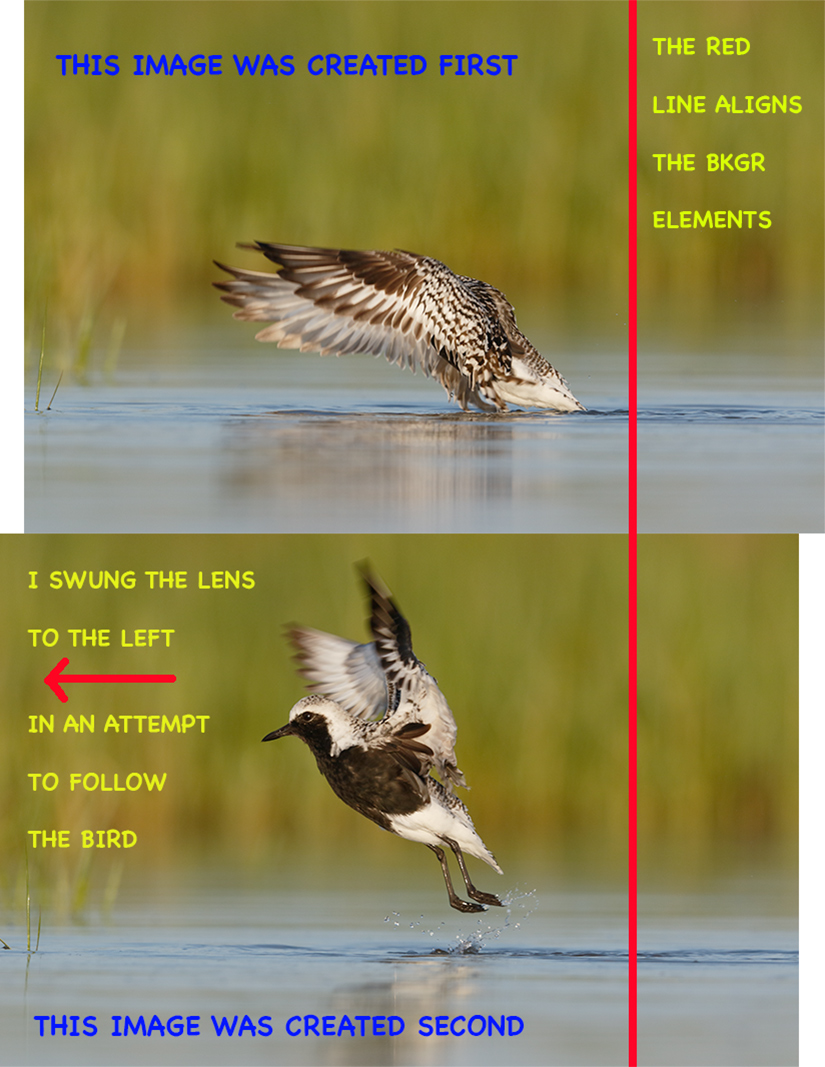
|
|
Both images were created with the tripod-mounted Canon EF 600mm f/4L IS II USM lens, Canon Extender EF 1.4X III, and the Canon EOS 7D Mark II. ISO 400. Evaluative metering +1/3 stop: 1/1600 sec. at f/6.3 in Manual mode.
One AF point below the center AF point/AI Servo Surround/Rear Focus AF as originally framed was active at the moment of exposure. Click here to see the latest version of the Rear Focus Tutorial. Click on the image to see a larger version.
The which came first answer
|
Which Came First?
In the “Happiness Is. Bathing Beauty Tips & Which Came First?” blog post here, I asked,
Which image was created first in this two-frame sequence?
Image #1, the upper image in the composite above, was created first, the lower image, Image #2, was the second in this two-frame sequence. I matched the background elements and drew the red line to show the match. Since the bird in Image #1 was farther right against the background and Image #2 was farther left, Image #1 had to be created first.
Did I move the lens when creating this two-frame sequence?
Some folks hinted at the fact that Image #2 had been cropped and indeed it had been, from thr right and from below. Studying the composite above indicates that as the bird flapped, jumped and flew to our left I swung the lens to my left in an effort to better frame the image and keep an active AF point on the subject. So yes, I did move the lens between the two exposures. Not a lot, but definitely swung to my left.
Exposure Fine Point Question
For the most part I was photographing Marbled Godwits and Short-billed Dowitchers in the sweet early morning light. With those two species I went with Evaluative metering +2/3 stop; that worked out to be 1/1250 sec. at 6.3. Why did I go 1/3 stop darker with the breeding plumage black-bellieds?
The Exposure Fine Point Answer
The WHITEs on Black-bellied Plover are brighter than the highlights on the more muted species mentioned above, thus I went with a shutter speed that was 1/3 stop faster.
Ignorant Artie’s Lightroom Comments
In the “Lightroom. My Take. Denise’s Take. Your Take? More on Photo Mechanic and My Digital Workflow” blog post here, my main gripe was that Lightroom as I had seen and heard, was extremely slow to render images when folks are editing their work, that is,when they are picking their keepers.
Several Lightroom users commented that I was right. Others disagreed. At one point I spoke to digital photography expert Ellen Anon who said, “Jeez oh man! Lightroom is as slow as molasses.” On the Fort DeSoto Spring IPT one of the participants stated that for him Lightroom was lightning fast. I grabbed his Macbook Pro, hit the right arrow key, and learned that he was indeed correct. I had been ignorant of the fact that on a good laptop with Lightroom set up correctly, Lightroom did indeed provide fast viewing.
Please note: ignorant does not always have to mean “stupid.” It can mean “unaware.”
I opted not to join the fray as 83 folks left comments. So what’s the good news? Lots of folks got to voice their opinions and lots of folks shared their Lightroom tips and techniques. All in all the comments section there turned into a valuable resource for Lightroom users. I do not think that anyone provided and answer to one question that I posed: “As far as image processing is concerned, what can Lightroom do that Photoshop cannot?” Do understand that I never doubted for one second that Lightroom offers great cataloguing and keywording features.
Several of the folks who saw me using Photo Mechanic on recent IPTs were quite impressed and several switched, ordering through BAA to enjoy our discount. I continue to enjoy the speed and simplicity of my Photo Mechanic/DPP 4/Photoshop CC workflow. I will be sharing a helpful Photo Mechanic Ingest tip with you here soon.
|

|
|
You can purchase a copy of Photo Mechanic in the BIRDS AS ART Online Store here. Be sure to e-mail Jim or to call as below for discount info.
|
Photo Mechanic
Learn lots more about how I use PM here. Purchase Photo Mechanic from BIRDS AS ART and your license code will be sent to you via e-mail within 1-7 business days (usually within 1-3 business days). Your copy of Photo Mechanic will be delivered to you via electronic download from the manufacturer’s website.
Best News
Folks who subscribe to the blog can call Jim or Jennifer at 863-692-0906 weekdays before 2pm to receive a small PM discount. Or, if they wish to purchase Photo Mechanic in the BIRDS AS ART Online Store here, they can e-mail Jim for a discount code.
Integrating Photo Mechanic and Digital Photo Professional 4 (PM & DPP 4)
An e-Mail Conversation with Bill Hill
BH: One more thing if you have time. In your workflow, you “ingest” the files in Mechanic and then do you open the file in DPP4 for edit and transfer to Photoshop?
AM: Bill, you gotta read what I wrote here. Actually, I will save you some time; here is the important stuff:
Photo Mechanic Editing (Picking Your Keepers) Tips
I set the default so that the images are arranged by Capture Time when I open a folder. Before you sit down to your first PM editing session be sure to go to Preferences > Preview and then–under “Automatically advance to the next photo when:”– uncheck the “tag is changed” box. That way when you tag a keeper it does not automatically advance to the next frame. You need to do that only once. (Some folks prefer to leave that box checked but that messes up my increasingly feeble brain.”
I view my images in Photo Mechanic by simply selecting the first image in the folder and then hitting the spacebar to enlarge the image. After that, I hit the right arrow key to advance to the next slide. I hit letter “T” to tag my keepers. You can hit “T” again if you change your mind; this untags the image. When I am done editing the folder I set Filter view by to Untagged. Then I hit Command A (select all) and Command delete to delete all the rejected images. Done deal.
Here’s the best part: the folder in DPP will update automatically when you delete the rejects in PM. Then I go to DPP—both programs are open all the time–and do my RAW conversions for selected files.
To summarize, I Ingest and pick my keepers using Photo Mechanic, convert my RAW files in DPP 4 (hit Command + Right Arrow to open the image edit screen), and then bring the converted TIFF into Photoshop (Shift + Command + P). Fast and smooth. Again, the folder structures and the contents of each folder will be identical without your having to lift a finger. No libraries. No importing. No exporting. In other words, a piece of cake. With the icing.
For more than a decade I have been saying “If you are on a PC and are not using BreezeBrowser and Downloader Pro to download and edit your images you are nuts.” To that I can now add, “If you are on a Mac and not using Photo Mechanic to Ingest and edit your images (pick your keepers) you are nuts. Note: PM works on both PC and Mac platforms.
Learn why I switched to DPP 4 and how I use it to convert all of my Canon RAW files in the DPP 4 RAW Conversion Guide (by Arash Hazeghi and Arthur Morris) here.
|
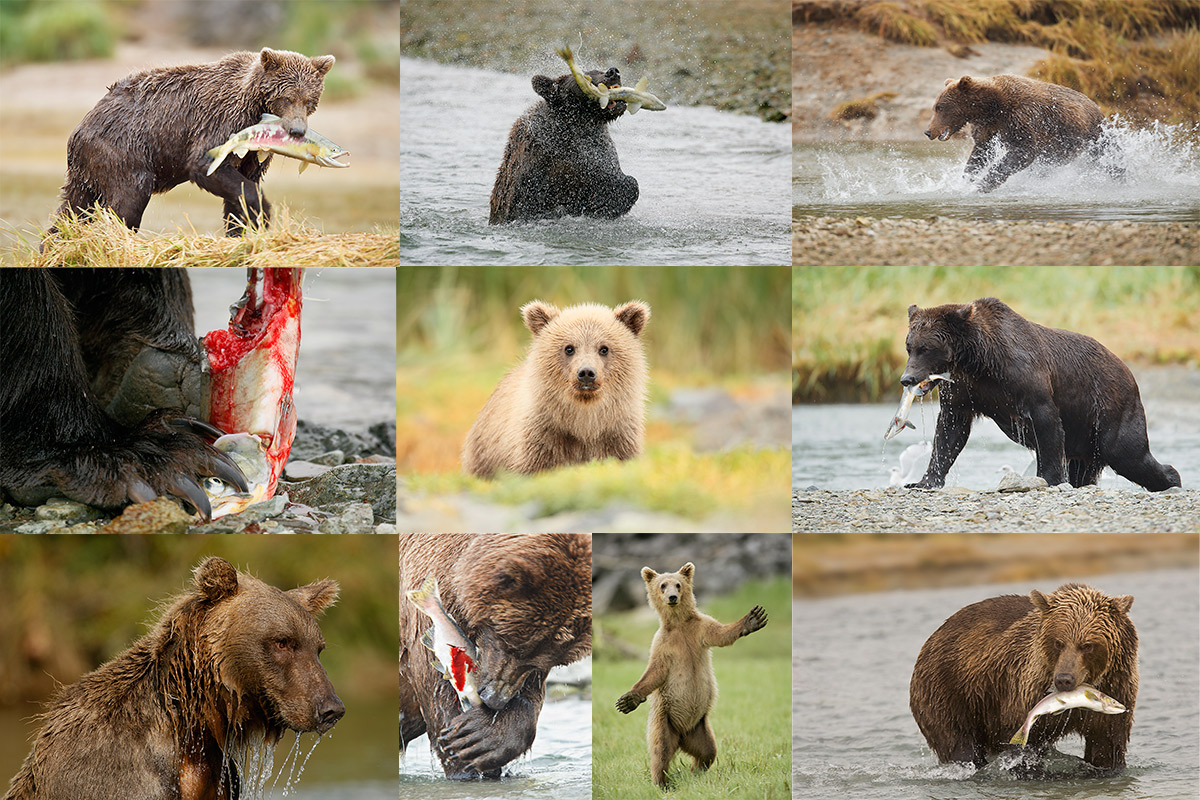
|
|
All of the images in the bear boat card above were created in Katmai National Park during the month of September.
|
Due to a recent cancellation there are once again three slots open.
Bear Boat/Bears Catching Salmon IPT: September 1-8, 2015 from Kodiak, AK/6 FULL & 2 1/2 DAYS: $6699. Happy campers only! Maximum 8/Openings: 3, with two good friends threatening to sign up. Plus the leader: Arthur Morris.
Join me in Katmai National Park, AK for seven days of photographing Coastal Brown Bears (grizzlies) catching salmon, fattening up for the long winter. Other subjects will include Mew and Glaucous-winged Gulls in flight and dip-feeding on salmon roe. Did I mention that we live on a boat and that the food is great? Most of our photography will be done in a variety of famed locations: Geographic Harbor, Kinak Bay, and Kukak Bay. We once had 39 bears fishing the creek at Kukak….
It is mandatory that you be in Kodiak no later than the late afternoon of August 31, 2015 September to avoid missing the float planes to the boat on the morning of September 1. With air travel in AK being what it is, with the chance of fog or other bad weather–being on Kodiak on August 30 is an even better plan). I will be on Kodiak on August 30 to avoid any potential disaster. That said in my nearly a dozen bear boat trips I was delayed only once but since I was day early as noted above there was no harm, no foul.
We will take one or more float planes to the boat mid-morning on September 1. We will photograph bears fishing that afternoon and every day for the next six days (weather permitting of course). We should have bears catching salmon every day. In addition, we will get some nice stuff on Mew Gull and Glaucous-winged Gulls dining on roe and the remains of predated salmon. We may–depending on where the concentrations of bears are–get to photograph Harbor seals and some hauled out Steller’s Sea Lions (an endangered species). Halibut fishing (license required) is optional. On September 8, our last morning on the boat, those who would like to enjoy one last photo session will do so. The group returns to Kodiak via float plane midday. Most folks will fly to Anchorage and then continue on red-eye flights to their home cities.
The eight days will consist of six full days (Sept 2, 3, 4, 5, 6, & 7) of photography featuring lots of Coastal Brown Bears catching salmon as above plus a variety of other natural history subjects plus some nice scenic photography that I forgot to mention above. Plus the first afternoon and the last morning.
What’s included? 8 DAYS/7 NIGHTS on the boat as above. All meals on the boat. (The food is quite excellent.) National Park fees. One night’s double occupancy lodging on Kodiak; arrive: Sept 1/depart: Sept 2. The thank-you-in-advance dinner on Sept 1. In-the-field photo tips, instruction, and guidance. An insight into the mind of a top professional; I will constantly let you know what I am thinking, what I am doing, and why I am doing it. Small group image review, image sharing, and Photoshop instruction on the boat.
What’s not included: Your round trip airfare to and from Kodiak, AK (almost surely through Anchorage). All necessary lodging other than the cost of your double occupancy room on the night of August 31 should you opt to arrive early–we can arrange that in advance for you. We will let you know the cost of a single supplement for the one night if so desired. The cost of the round-trip float plane to the boat on September 2 and back to Kodiak on September 9. The cost of a round trip this year was $500. The suggested crew tip of $210.
Is this an expensive trip? Yes, of course. But with 6 full and two half days, a wealth of great subjects, and the fact that you will be walking with the bears just yards away (or less….) it will be one of the great natural history experiences of your life. Most folks who take part in a Bear Boat IPT wind up coming back for more.
A $2,000 per person non-refundable deposit by check only made out to “Arthur Morris” is required to hold your spot. Please click here to read our cancellation policy. Then please print, read, and sign the necessary paperwork here and send it to us.
Your deposit is due immediately. That will leave a balance of $4699. The next payment of $2699 will be due on February 15, 2015. The final payment of $2000 is due on May 1, 2015.
I hope that you can join us for this wondrously exciting trip.
Facebook
Be sure to like and follow BAA on Facebook by clicking on the logo link upper right. Tanks a stack!
Support the BAA Blog. Support the BAA Bulletins: Shop B&H here!
We want and need to keep providing you with the latest free information, photography and Photoshop lessons, and all manner of related information. Show your appreciation by making your purchases immediately after clicking on any of our B&H or Amazon Affiliate links in this blog post. Remember, B&H ain’t just photography!
…..
Amazon.com
Those who prefer to support BAA by shopping with Amazon may use this link:
Amazon Canada
Many kind folks from north of the border, eh, have e-mailed stating that they would love to help us out by using one of our affiliate links but that living in Canada and doing so presents numerous problems. Now, they can help us out by using our Amazon Canada affiliate link by starting their searches by clicking here. Many thanks to those who have written.
Typos
In all blog posts and Bulletins, feel free to e-mail or to leave a comment regarding any typos or errors. Just be right :).
May 20th, 2015 Stuff
I began working on a new eBook that I am doing with Denise Ippolito, finished the day off with a cold ice bath–59 degree water when I got out after my 44 minutes, and promptly fell asleep on the couch for three hours.
Bosque #1 is filling nicely. We have tons of room on Bosque #2. See the complete details below. This blog post, the 132nd in a row, took about 2 hours to prepare. It should be published automatically at 1:00am on Wednesday. Tomorrow I start the real work on my 2014 taxes.
Used Photography Gear for Sale News
Two lenses sold during the past week: Carl Zanoni’s 70-200mm f/2.8L IS II and Owen Peller’s “old” EF 100-400mm f/4.5-5.6L. If you would like to learn about selling your used photo gear through BAA, please shoot me an e-mail with the words “Items for Sale Info Request” cut and pasted into the Subject line. You can check out all of the current listings here.
New Price Drops
Canon EF 100-400mm f/4.5-5.6L IS USM
Price reduced an amazing $150 on 5/19/2015!
Barbara Garmon is offering a used Canon EF 100-400mm f/4.5-5.6L IS USM lens in like-new condition for $749.00. The lens is cosmetically and operationally perfect. The sale includes the original box, the front and rear lens caps, the original box, the ET-83C lens hood, the LZ1324 lens case, and insured shipping to US addresses. You can call Barbara on her cell at 641-777-2578 (eastern time zone) or reach her via e-mail.
I owned and used this great lens for well more than a decade and created hundreds of published images with it. Denise Ippolito owned and loved hers for many years.
Used Canon EF 100-400 f 4.5-5.6 L IS Lens
Price reduced a total of $200 on 5/19/2015!
Multiple IPT veteran Jack Panzeca is offering a used Canon EF 100-400 f 4.5-5.6 L IS lens in very good + condition for $799 including insured shipping via UPS Ground to US addresses only. The tripod collar has one small scratch. The sale includes the original tough fabric case, the original box, the front and rear caps, the lens hood, and the strap. Your gear will be shipped only after your check clears.
Please contact Jack via e-mail or by phone at 817 819 1756. Central Time Zone.
The 100-400 is a versatile intermediate telephoto zoom lens with 1,000+ uses. It makes a great starter lens especially for folks who do general nature and wildlife in addition to birds. I’ve sold 100s of images made with a 1-4 and denise loved hers for many years forsaking it only recently for the Canon EF 70-200mm f/2.8L IS II USM lens. Jack’s 100-400 is priced to sell. artie
Please Remember to use our Affiliate Links 🙂
To show your appreciation for my continuing efforts here, we ask, as always, that you use our the B&H and Amazon affiliate links on the right side of the blog for all of your purchases. B&H is recommended for you major photography gear purchases, Amazon for your household, entertainment, and general purpose stuff. Please check the availability of all photographic accessories in the BIRDS AS ART Online Store, especially the Mongoose M3.6 tripod heads, Gitzo tripods, Wimberley heads and plates, LensCoats and accessories, and the like. We sell only what I have used, have tested, and can depend on. We will not sell you junk. We know what you need to make creating great images easy and fun. And we are always glad to answer your gear questions via e-mail. I just learned that my account was suspended during my absence; it should be up and running by Monday at the latest.
I would of course appreciate your using our B&H affiliate links for all of your major gear, video, and electronic purchases. For the photographic stuff mentioned in the paragraph above we, meaning BAA, would of course greatly appreciate your business. Here is a huge thank you to the many who have been using our links on a regular basis and visiting the BAA Online store as well.
|
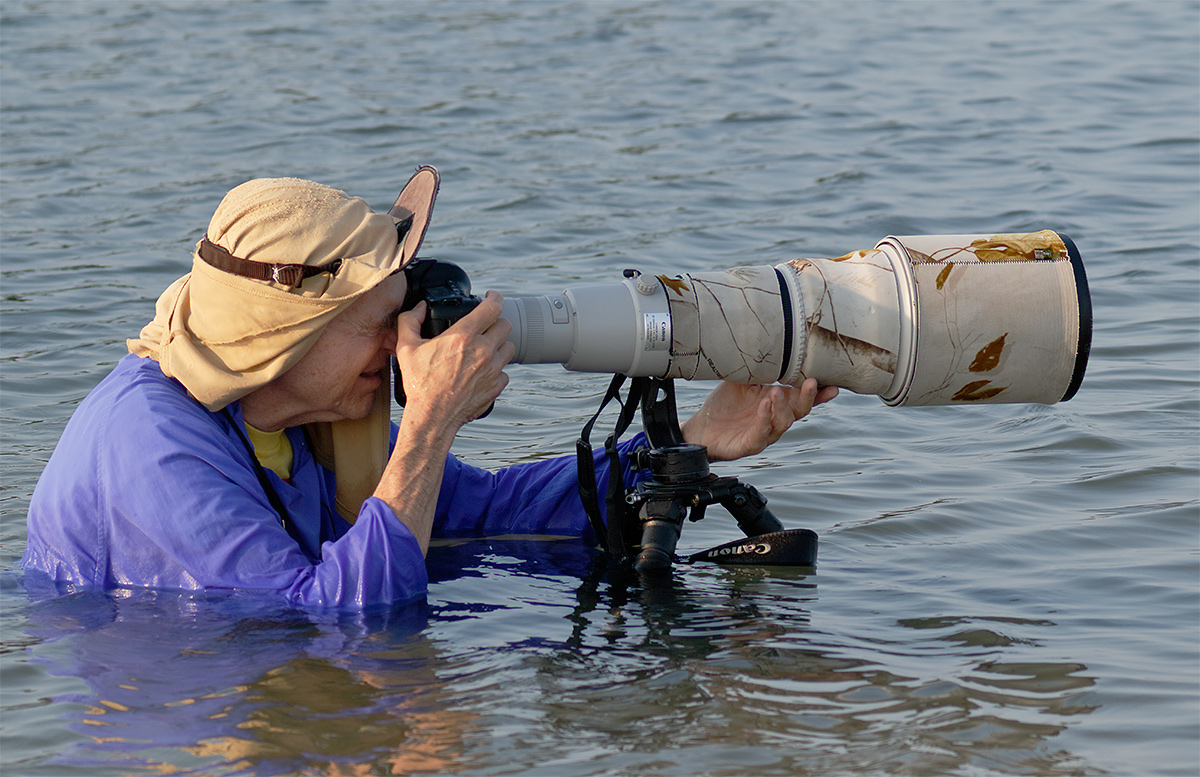
|
|
This image was created on the Fort DeSoto Spring IPT by Dwayne Marrott with the tripod-mounted Canon EF 100-400mm f/4.5-5.6L IS II USM lens, the Canon Extender EF 1.4X III (at 140mm), and the Canon EOS 7D Mark II. ISO 400. Evaluative metering at zero: 1/800 sec. at f/6.3.
Center AF point (Manual selection)/AI Servo AF as framed was active at the moment of exposure. Click on the image to see a larger version.
Image #1: artie in shorebird heaven. Image courtesy of and copyright 2015: Dwayne Marrott
|
Artie in shorebird heaven…
As mentioned here previously, I love sitting in a foot or more of water behind a long lens with a TC in place picking off shorebirds on still early mornings. I had hoped that someone in the IPT group had made an image of me doing what I love. The easy going very nice Dwayne Marrott who was with me on both the Canon Morro Bay Destination Workshop and the DeSoto Spring IPT turned out to be the man! Thanks a stack Dwayne.
How I saltwater fried a Canon EOS-1D X
I sat for more than 90 minutes without a problem; kneeling is impossible for me as it wrecks my left knee and induces lower back spasms. When I was about ready to get up I glanced to my left and saw Chris Billman who had also been with me on the Canon workshop. I grabbed my lowered tripod and walked over to chat with Chris. I put the lowered tripod down for a handshake. In retrospect, either lengthening the tripod legs or tightening the vertical pan on the Mongoose M3.6 would have saved the camera. In reality the rig tilted back just a bit and as Chris had been working in water a bit deeper than I had been, the bottom third of the camera body got dunked.
I took out the battery and air-dried it a bit, re-inserted it, and pressed the shutter button. The camera began rapid firing and did not stop until I removed the battery… Salt water and photo gear are not a good mix. I sent it to the Canon Jamesburg and quickly learned that it was “beyond economic repair.” I am in the process of filing my first-ever insurance claim.
Lesson learned: be careful out there….
Image Question
What is the single most important reason that Dwayne should have removed the 1.4X teleconverter? (Hint: I expanded canvas right…)
|
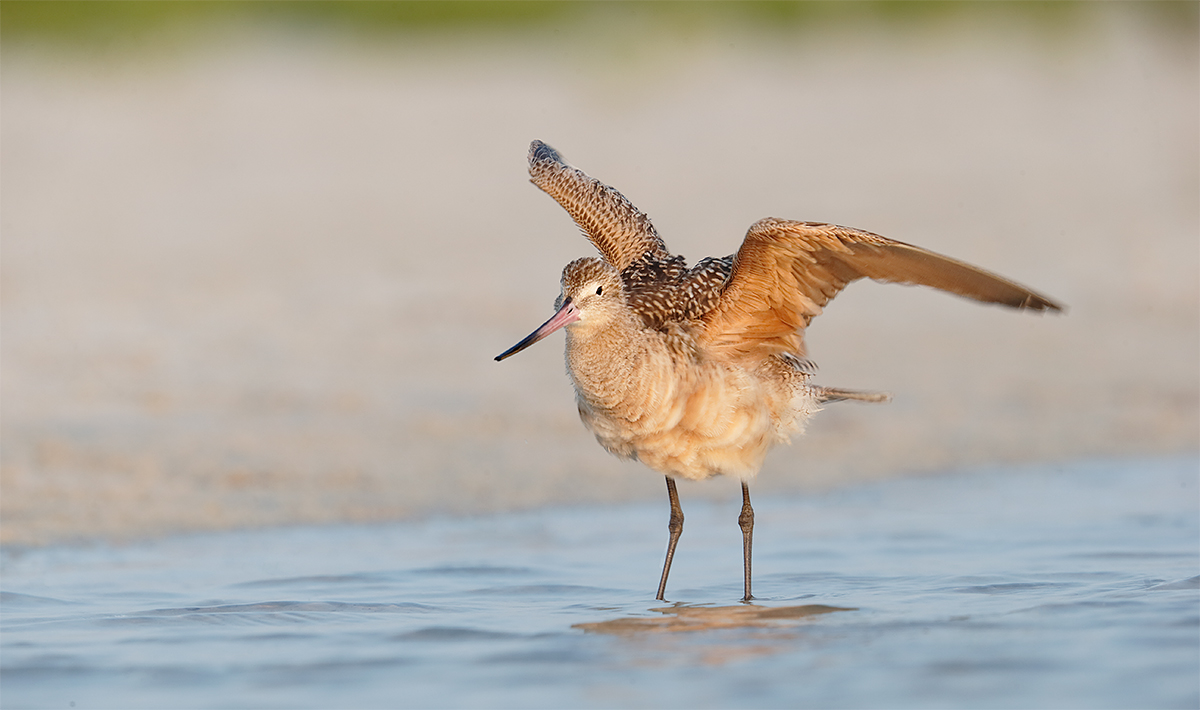
|
|
This image was created on the second morning of the Fort DeSoto IPT while sitting in the water as above with the tripod-mounted Canon EF 600mm f/4L IS II USM lens, the Canon Extender EF 2X III, and the Canon EOS-1D X. ISO 800. Evaluative metering +2/3 stop in Manual mode: 1/400 sec. at f/9.
Center AF point (by necessity)/AI Servo Expand/Rear Focus AF and release. Click here to see the latest version of the Rear Focus Tutorial. Click on the image to see a larger version.
Image #2: Marbled Godwit ruffling
|
279 Keepers!
After the first edit, I kept 279 images from that great morning session. You can see more images from that am session here.
Do understand that most IPTs are carefully planned with a tide table in hand. Or at least on the laptop in Chrome: SaltwaterTides.com :). I will surely be doing a Spring DeSoto IPT next year; dates and cost TBA. If you are interested in being put on the interested list, please shoot me an e-mail. Same for the January 2016 San Diego IPT.
|
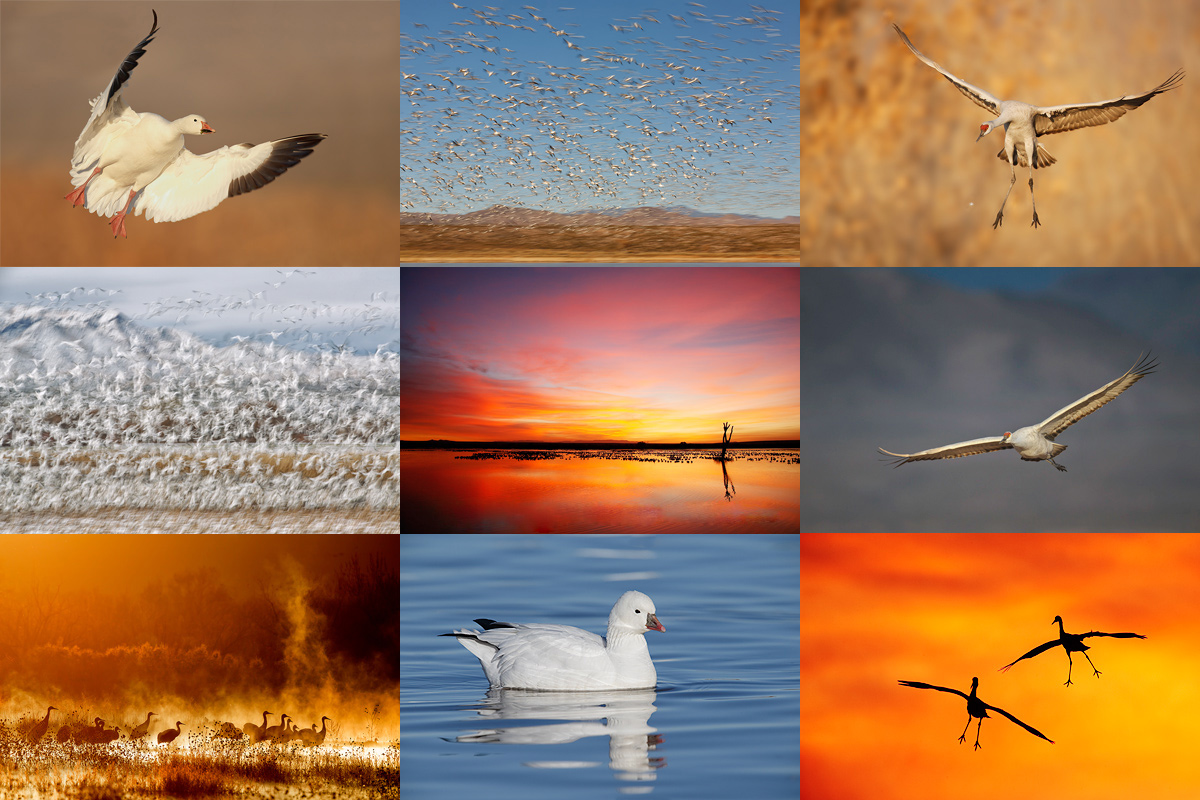
|
|
In 2015, we are offering a 3-DAY IPT before Thanksgiving and a 4-DAY IPT after the holiday. You can attend either and spend Thanksgiving Day with your family. Sign up for both and we will be glad to apply a $100 discount to your balance. We know that there are lots of less costly workshops being offered these days. Many of them are downright cheap. Please remember that you get exactly what you pay for. With us you will have two full time pros there for you every minute we are in the field. Together they have more than 28 seasons of experience at the refuge. If you want the finest in photographic instruction and want to be assured of being in the right spot at exactly the right time every day, do join us.
|
Bosque del Apache 2015 BIRDS AS ART/A Creative Adventure Instructional Photo-Tour (IPT). 3-FULL DAY IPT: NOV 22-24, 2015. $1149. Two great leaders: Denise Ippolito and Arthur Morris. Meet and greet and introductory slide program after dinner on your own at 7:00pm on SAT NOV 21.
Tens of thousands of Snow Geese, 10,000 Sandhill Cranes, ducks, amazing sunrises, sunsets, and blast-offs. Live, eat, and breathe photography with two of the world’s premier photographic educators at one of their very favorite photography locations on the planet. Top-notch in-the-field and Photoshop instruction. This will make 21 consecutive Novembers at Bosque for artie. This will be denise’s 7th workshop at the refuge. Nobody knows the place better than artie does. Join us to learn to think like a pro, to recognize situations and to anticipate them based on the weather, especially the sky conditions, the light, and the wind direction. Every time we make a move we will let you know why. When you head home being able to apply what you’ve learned on your home turf will prove to be invaluable.
This workshop includes 3 morning and 3 afternoon photography sessions, an inspirational introductory slide program after dinner on your own on Saturday, 11/21, all lunches, and after-lunch digital workflow, Photoshop, and image critiquing sessions.
There is never a strict itinerary on a Bosque IPT as each day is tailored to the local conditions at the time and to the weather. We are totally flexible in order to maximize both the photographic and learning opportunities. We are up early each day leaving the hotel by 5:30 am to be in position for sunrise. We usually photograph until about 10:30am. Then it is back to Socorro for lunch and then a classroom session with the group most days. We head back to the refuge at about 3:30pm each day and photograph until sunset. We will be photographing lots of Snow Geese and lots of Sandhill Cranes with the emphasis on expanding both your technical skills and your creativity.
A $449 non-refundable deposit is required to hold your slot for this IPT. Your balance, payable only by check, will be due on 7/25/2015. If you cancel and the trip fills, we will be glad to apply a credit applicable to a future IPT for the full amount less a $100 processing fee. If we do not receive your check for the balance on or before the due date we will try to fill your spot from the waiting list. Whether or not your spot is filled, you will lose your deposit. If not, you can secure your spot by paying your balance.
Please print, complete, and sign the form that is linked to here and shoot it to us along with your deposit check (made out to “Arthur Morris.”) You can also leave your deposit with a credit card by calling the office at 863-692-0906. If you register by phone, please print, complete and sign the form as noted above and either mail it to us or e-mail the scan. If you have any questions, please feel free to contact me via e-mail.
|
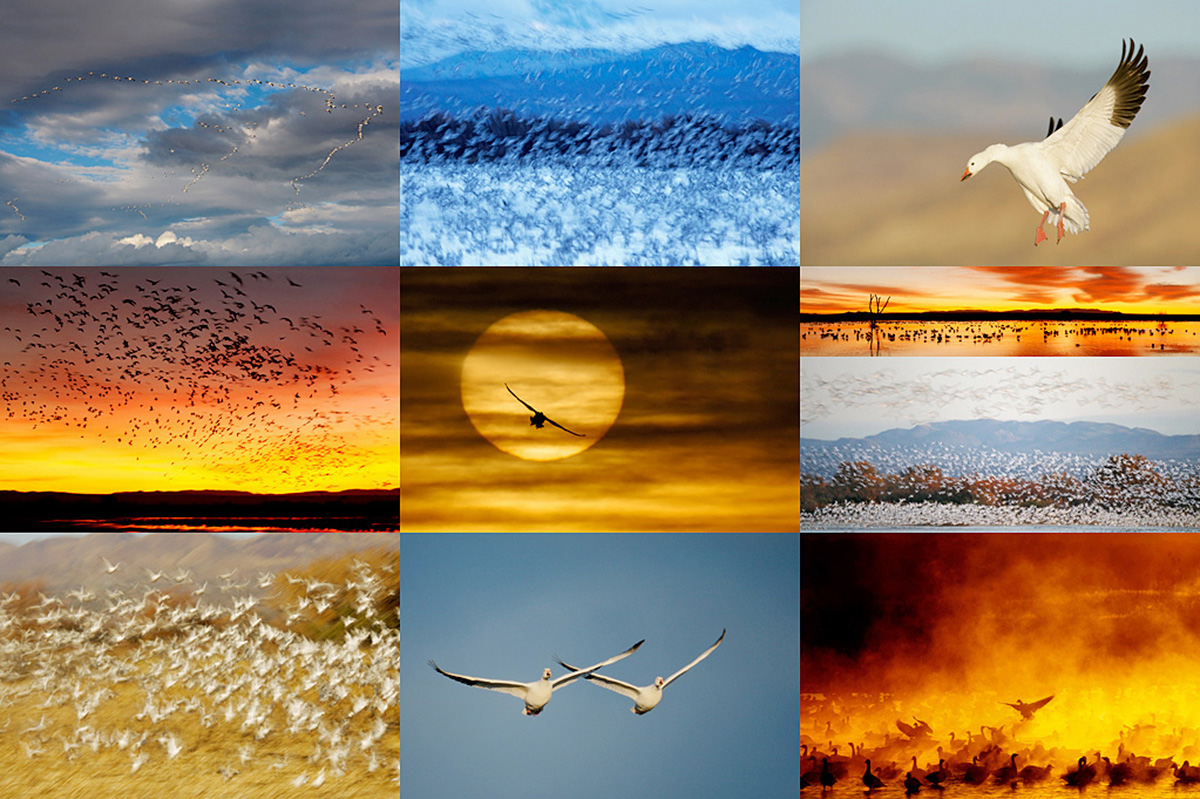
|
|
In 2015, we are offering a 3-DAY IPT before Thanksgiving and a 4-DAY IPT after the holiday. You can attend either and spend Thanksgiving Day with your family. Sign up for both and we will be glad to apply a $100 discount to your balance.
We know that there are lots of less costly workshops being offered these days. Please remember that you get exactly what you pay for. If you want the finest in photographic instruction and want to be assured of being in the right spot at exactly the right time, do join us.
|
Bosque del Apache 2015 BIRDS AS ART/A Creative Adventure Instructional Photo-Tour (IPT). 4-DAY IPT: (three full and two 1/2 DAYS) NOV 28-DEC 2, 2015. $1499. Two great leaders: Denise Ippolito and Arthur Morris. Meet and greet at 3pm on SAT NOV 28 followed by an afternoon photo session at the crane pools and the introductory slide program after dinner on your own.
Tens of thousands of Snow Geese, 10,000 Sandhill Cranes, ducks, amazing sunrises, sunsets, and blast-offs. Live, eat, and breathe photography with two of the world’s premier photographic educators at one of their very favorite photography locations on the planet. Top-notch in-the-field and Photoshop instruction. This will make 21 consecutive Novembers at Bosque for artie. This will be denise’s 7th workshop at the refuge. Nobody knows the place better than artie does. Join us to learn to think like a pro, to recognize situations and to anticipate them based on the weather, especially the sky conditions, the light, and the wind direction. Every time we make a move we will let you know why. When you head home being able to apply what you’ve learned on your home turf will prove to be invaluable.
This workshop includes 4 afternoon (11/28through 12/1), 4 morning (11/29 to 12/2) photography sessions, an inspirational introductory slide program after dinner on your own on Saturday, 11/28, all lunches, and after-lunch digital workflow, Photoshop, and image critiquing sessions.
There is never a strict itinerary on a Bosque IPT as each day is tailored to the local conditions at the time and to the weather. We are totally flexible in order to maximize both the photographic and learning opportunities. We are up early each day leaving the hotel by 5:30 am to be in position for sunrise. We usually photograph until about 10:30am. Then it is back to Socorro for lunch and then a classroom session with the group most days. We head back to the refuge at about 3:30pm each day and photograph until sunset. We will be photographing lots of Snow Geese and lots of Sandhill Cranes with the emphasis on expanding both your technical skills and your creativity.
A $599 non-refundable deposit is required to hold your slot for this IPT. Your balance, payable only by check, will be due on 7/25/2015. If you cancel and the trip fills, we will be glad to apply a credit applicable to a future IPT for the full amount less a $100 processing fee. If we do not receive your check for the balance on or before the due date we will try to fill your spot from the waiting list. Whether or not your spot is filled, you will lose your deposit. If not, you can secure your spot by paying your balance.
Please print, complete, and sign the form that is linked to here and shoot it to us along with your deposit check (made out to “Arthur Morris.”) You can also leave your deposit with a credit card by calling the office at 863-692-0906. If you register by phone, please print, complete and sign the form as noted above and either mail it to us or e-mail the scan. If you have any questions, please feel free to contact me via e-mail.
Facebook
Be sure to like and follow BAA on Facebook by clicking on the logo link upper right. Tanks a stack!
Support the BAA Blog. Support the BAA Bulletins: Shop B&H here!
We want and need to keep providing you with the latest free information, photography and Photoshop lessons, and all manner of related information. Show your appreciation by making your purchases immediately after clicking on any of our B&H or Amazon Affiliate links in this blog post. Remember, B&H ain’t just photography!
…..
Amazon.com
Those who prefer to support BAA by shopping with Amazon may use this link:
Amazon Canada
Many kind folks from north of the border, eh, have e-mailed stating that they would love to help us out by using one of our affiliate links but that living in Canada and doing so presents numerous problems. Now, they can help us out by using our Amazon Canada affiliate link by starting their searches by clicking here. Many thanks to those who have written.
Typos
In all blog posts and Bulletins, feel free to e-mail or to leave a comment regarding any typos or errors. Just be right :).
May 19th, 2015 Stuff
I left Charleston at 5:00am and after catnapping briefly south of Orlando and running several errands in Lake Wales was in the house at 2:50pm. Jim kindly had lunch waiting for me. I spent the rest of the day answering e-mails and doing some writing.
This blog post, the 131st in a row, took about 1 1/2 hours to prepare. It should be published automatically at 3:00am on Monday morning.
|
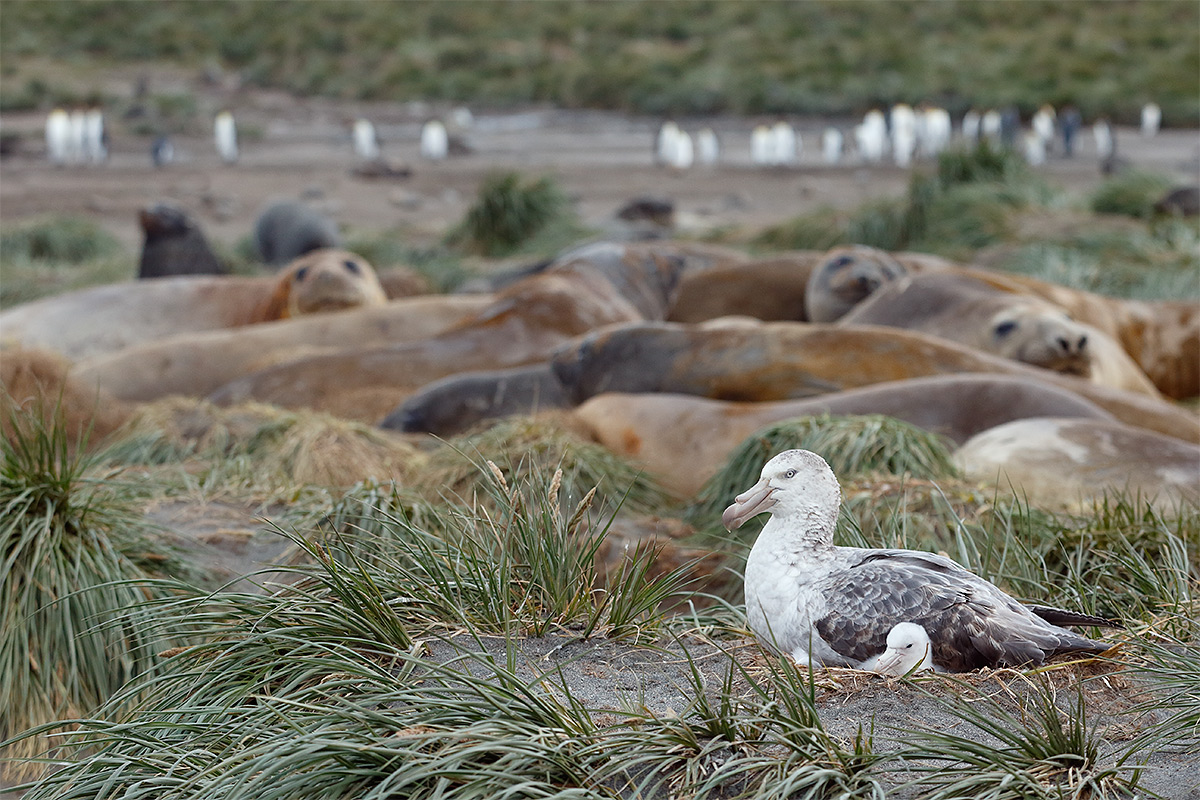
|
|
This image was created at Salisbury Plain, South Georgia with the tripod-mounted Canon EF 70-200mm f/2.8L IS II USM lens, the Canon Extender EF 1.4X III (at 135mm), and the Canon EOS-1D X . ISO 1600. Evaluative metering at zero: 1/250 sec. at f/5.6.
Center AF point/AI Servo Expand/Rear Focus AF on the adult’s eye and re-compose. Click here to see the latest version of the Rear Focus Tutorial. Click on the image to see a larger version.
Image #1: Northern Giant Petrel with chick on nest/wide habitat shot
|
Surprise Miracle on Salisbury Plain
Northern Giant Petrel nests in many locations on South Georgia. Many of those are off limits to visitors. In places you severely are restricted from approaching a nest. Because of severe weather delays due to high winds on our crossing from The Falklands we missed our scheduled landing at Salisbury Plain, one of several hard-to-believe King Penguin nesting sites in South Georgia. Our expedition leader was able to make a deal with another so that we were able to land at about 4:00am. And we needed to be off the beach by 8:00am.
Advance crew member landing parties land before any of the trip participants to make sure that things are do-able and safe and to stake out a path through the furs seals. As I made my way up the beach I was astounded to see a completely unperturbed Northern Giant Petrel sitting on both its nest and a small white chick. Talk about striking it rich. As our path was within scant yards of the nest all the photographers needed to do was walk slowly and stay a bit on the quiet side. And that is exactly what we did.
?????
I optimized a much tighter image of the adult with the chick and was sure that I had posted it to the blog or in a Bulletin. A search of both turned up nada. If you know the whereabouts of that image, please post the link.
Small In-the-Frame Habitat Shot
To create Image #1 I zoomed well out and carefully framed the Elephant Seals and King Penguins in the background taking care not to cut any animals or birds in half with the frame edge while maintaining clean lower an upper frame-edges.
|
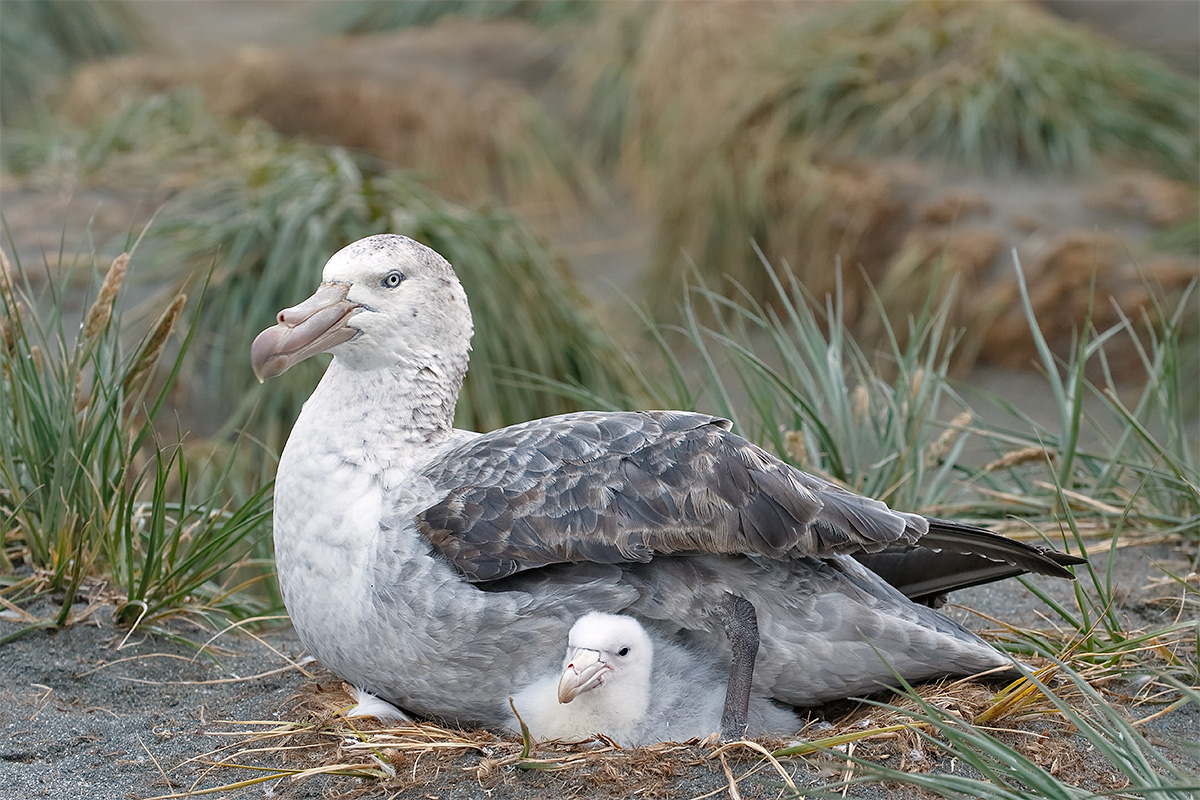
|
|
This image was created at Salisbury Plain, South Georgia with the tripod-mounted Canon EF 70-200mm f/2.8L IS II USM lens, the Canon Extender EF 1.4X III (at 240mm), and the Canon EOS-1D X . ISO 1600. Evaluative metering +1 /3 stop: 1/125 sec. at f/8.
One row down and four AF points to the left of the center AF point/AI Servo Expand/Rear Focus AF as framed was active at the moment of exposure. The selected AF point fell on the the adult’s neck well below the eye and just forward of the feathers of the upper back. Click here to see the latest version of the Rear Focus Tutorial. Click on the image to see a larger version.
Image #2: Northern Giant Petrel with chick/tight
|
No Time Like the Present…
I decided to post the large-in-the-frame version here as well. It brings up lots of good questions:
#1: Which image do you like best, the habitat shot or the tight shot? Why?
#2: Why was f/8 needed for the tight image?
#3: Are the two exposure the same?
#4: Why +1/3 stop for Image #2 but zero for the first image?
#5: Which image was created first, #1 or #2? (You need to know me to get this one right….)
#6: What do I like least about Image #2?
#7: Why did I choose the exact same line of sight for both images?
|

|
|
All of the images on the card were made on South Georgia. This remote wilderness island offers both spectacular scenery and hordes of tame wildlife and birds. From top left clockwise to the center: Southern Elephant Seal, courting King Penguin pair, King Penguin abstract, Grey-headed Albatross, King Penguin rookery on Salisbury Plain, Macaroni Penguin head portrait, King Penguin molting Okum Boy, Macaroni Penguin pair, King Penguin preening, Southern Elephant Seal yawning, the view of Gold Harbour from a Light-mantled Sooty Albatross nest.
Click on the image to see an extra large version.
|
The Southern Ocean
South Georgia Expedition Voyage
I’ve been blessed. I’ve now made four trips to the Southern Ocean, three expeditions that visited the Falklands, South Georgia, and the Antarctic Peninsula, and one to the Falklands and South Georgia. Each was a truly amazing experience. South Georgia has been the star of the show each time: rugged snow covered peaks, tame and abundant wildlife including Southern Elephant Seal and Southern Fur Seal, and penguins: more King Penguins than you could ever have dreamed of. Gentoos. And my favorite, the golden-yellow spaghetti-topped Macaronis. With four trips to South Georgi under my belt, I have a pretty good idea about how to make great images at each of the iconic landings. In addition, we should have some pretty good flight photography sessions from the stern of the ship. I would love the chance to share my knowledge with you.
Going Light
On my recent trip, I found myself going with shorter lenses and lighter gear than on any previous Southern Ocean Expedition. In part that was due to the crop factor of the 7D Mark II, in part because going light makes life (and landings!) much easier. I made many landings with just the 7D II and the 70-200mm f/2.8L IS. I refined the way that I got my gear safely from ship to shore. Lots more on that here soon.
Cheesemans’ Well Deserved Kudos
I know from personal experience that if you are a photographer who is going to invest in Southern Ocean voyage, you will want to put your money on Cheesemans’. No other tour company goes as far out of their way to ensure making every possible safe landing. And no other tour company will have you spending more time on land. Michael Viljeon from South Africa was aboard the Ortelius on a Southern Oceans voyage that preceded the Cheesemans’ trip that we were both on. As we headed back to Ushuaia, he said, “The folks that ran that first trip were pathetic. Too rough. No landing today. Surf too high today. No landing. Wind wrong direction. No landing. Cheesemans’ routinely and safely gets folks on land in conditions where the leaders of other tour companies do not even bother getting out of their bunks.”
Here, from the” Way to Go CES! (Cheeseman’s Ecology Safaris)” blog post here, is one of my favorite Cheesemans’ stories:
The landing at Bailey Head, Antarctica, was especially rewarding to me as I had been sitting in a zodiac 100 yards off shore on my 2007 trip when the zodiac in front of mine swamped and the captain of the ship called off the landing…. Early that day it looked as if my weather Karma might not be working. Ted’s “Good morning shipmates” was followed by the news that we would not be able to land at Bailey Head that morning as the swell was too big. The beach there is sloped tremendously and the sea strives to pull the zodiacs back into the ocean before folks have gotten off with their gear. Tom Murphy had said to me several days before, “We will get you on the beach at Bailey Head.” Ted concluded his morning greetings by saying, “We are sending out a scout team to see if landing is possible.”
After breakfast I was thrilled to hear Ted’s voice again on the PA, “We will be landing at 8am.” Afterwards folks noted that it was the calmest landing ever at this amazingly beautiful spot. My good weather Karma (courtesy of late-wife Elaine) had come through one last time. Along with St. Andrews Bay, it was one of my two favorite super-great once-in-a-lifetime days of the trip. And we even got to enjoy three additional hours at Hannah Point, Antarctica before calling it a wrap and heading for the feared Drake Passage. All thanks to Cheesemans’ Ecology Safaris.
Why Sign Up Through BIRDS AS ART?
If you have been thinking and dreaming of finally visiting South Georgia, this is the trip for you. Quit dreaming and act now. Though I will not be an official leader on this trip, those who have traveled with me know that I cannot help but teach. I will make pre-trip gear recommendations. I will hold informal pre-landing briefings. In the same vein, everyone will receive a free copy of our Antarctica Site Guide once they are paid in full (July 2, 2015). I will be available on the ship to review your images,, answer questions, and conduct informal over-the shoulder Photoshop sessions. And best of all, everyone who signs up under the auspices of BAA are invited to tag along with me on the landings where I will be glad to offer invaluable in-the-field advice. And the same goes for the ship-board birds in flight and marine mammal photography opportunities.
Do join us. To learn how to be part of the BAA group please e-mail me with the words Antarctica/Extended Expedition BAA Info Please cut and pasted into the Subject line.
Important Notes
#1: If you fail to e-mail me as noted directly above, and register directly with CES you MUST let them know that you would like to be part of the BIRDS AS ART group.
#2: Joining the BIRDS AS ART group as above will not cost you one penny.
The Cheesemans’ Ecology Safaris South Georgia Expedition Voyage
An in-depth Adventure aboard the Ortelius: October 29 to November 17, 2015
From the CES website:
We are very excited to be able to bring this special in-depth expedition to you. This is a product of years of experience leading voyages to South Georgia and a passion for everything found here. Our itinerary is specifically designed to take advantage of the vibrant early season on South Georgia when snow blankets the mountains and early summer brings special wildlife treats seldom experienced. We will explore vast colonies of King Penguins, elephant seals in their peak of breeding activity, and colonies of Wandering, Gray-headed, Light-mantled, and Black-browed albatross. This cruise allows us many days to explore this truly unique island, the crown jewel of the Antarctic. The landscape filled with expanses of glaciers pouring into the sea provides rare beauty and photogenic impressiveness that words cannot convey. We will enjoy about nine days in the midst of the most beautiful and wildlife-rich island on the planet! Exceptional leadership expertise will enrich your experience throughout the voyage. Our priority on this special expedition is to give you the maximum time possible in the field so you can explore at your own pace during a special time on South Georgia. Come explore South Georgia with us!
I can personally attest to the accuracy of everything above. 🙂
|
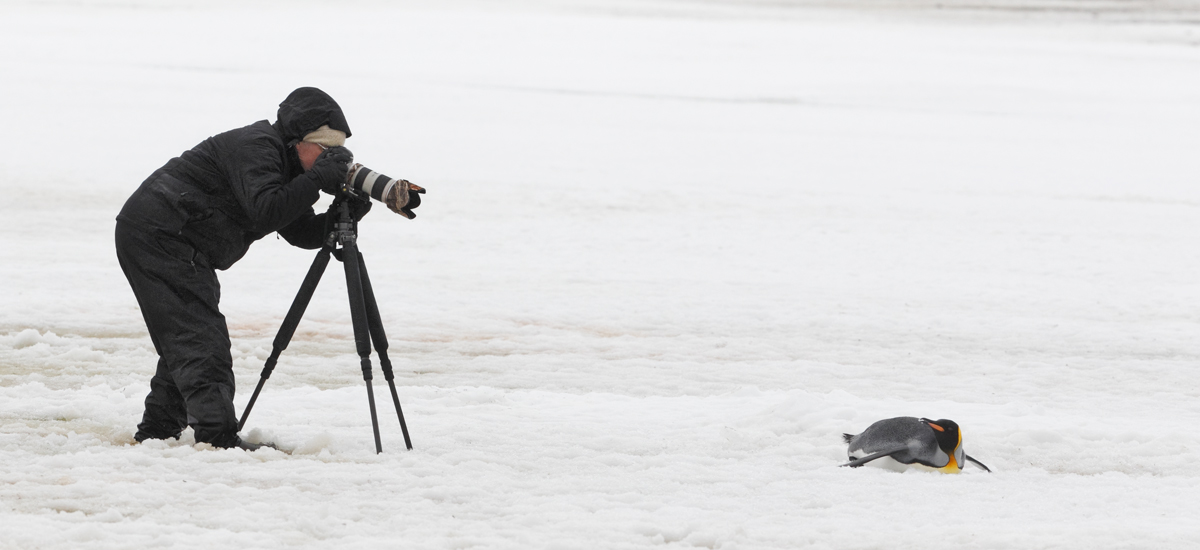
|
|
This could be you! Pat Lillich and King Penguin in snow. There is a much greater chance of snow in October than in December/January and for photography, fresh snow rocks!
|
More CES Kudos
From multiple IPT veteran Alan Lillich who (along with wife Pat) was in the BAA group on a 2012 CES voyage with me:
Start with some of the world’s best alpine landscapes, add an overwhelming abundance of tolerant wildlife, and finish with tour operators who put you there and give you the freedom to explore. It doesn’t get any better.
The Pull is Too Strong…
The pull is too strong. I need to go back. And I am. Do join me for an unparalleled wildlife and scenic photography experience. Please e-mail for additional information.
Questions?
I’d be glad to answer all of your Southern Ocean/Falklands/South Georgia/Antarctica questions. Please leave a comment if you’d like to learn more.
May 18th, 2015 Stuff
Denise and Pam and I spent the morning at the famed and beautiful Magnolia Gardens. After three hours sleep on Saturday evening I could not–inexplicably–get to sleep for a nap on Sunday afternoon. We are heading out at 7:15pm to photograph the beautiful Arthur Ravenal Jr. Bridge at sunset.
As things are a bit slow here in May, I will likely be making the drive back to ILE tomorrow morning. The place is really smoking in early April. For information on Denise’s spring Charleston A Creative Adventure Workshop, click here.
This blog post, the 130th in a row,took about an hour to prepare. It was published automatically at 3:00am on Monday morning.
|
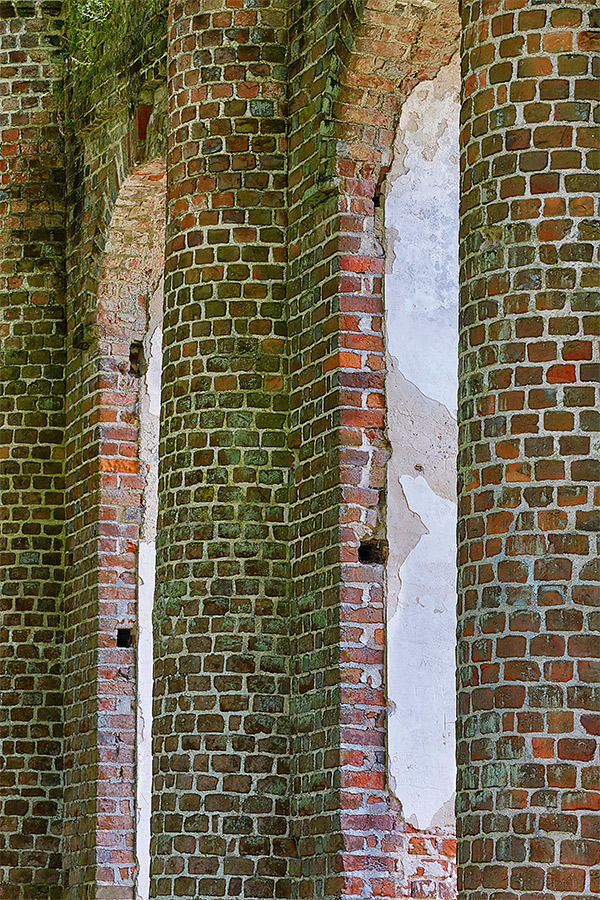
|
|
This 3-frame in-camera HDR Art Vivid image was created at a derelict church south of Charleston, SC with the tripod-mounted Canon EF 70-200mm f/2.8L IS II USM lens (at 150mm) and the Canon EOS 5D Mark III. ISO 400. Evaluative metering at zero yielded a base exposure of 1/15 sec. at f/22 in Av mode. Adjust dynamic range was set to 0. Being on a tripod I made sure to disable the Auto align feature. AWB.
Center AF point (Manual selection)/AI Servo Expand/Rear Focus AF on the center of the nearest column and recompose. Click here to see the latest version of the Rear Focus Tutorial.
Brick Columns
|
The 5D Mark III
Note that when reach is not a factor my first choice camera body is the Canon EOS 5D Mark III as it produces larger image files than the 7D II and, as it is a full frame body, allows you to work wider.
The Brick Columns
We arrived at the location hoping to do some wide angle stuff of the whole structure but a wedding was about to begin…. We stayed respectfully out of sight behind the remains of the old building. That’s when I saw the possibilities of a nicely designed image of the columns. I loved the contrast of the algae growing on the rear columns with the cleaner bricks in the foreground column. The exposed white plaster set things off nicely. Choosing my perspective carefully and then fine-tuning the framing were instrumental in the success of this image. I used my standard slow shutter speed flower technique to ensure a sharp image: Live View with 2-second timer.
As I usually do when creating Art Vivid HDRs I reduced the Saturation of both the YELLOW and GREEN channels. Being on a tripod ensures pretty good image quality when doing in-camera HDRs.
|

|
|
In 2015, we are offering a 3-DAY IPT before Thanksgiving and a 4-DAY IPT after the holiday. You can attend either and spend Thanksgiving Day with your family. Sign up for both and we will be glad to apply a $100 discount to your balance. We know that there are lots of less costly workshops being offered these days. Many of them are downright cheap. Please remember that you get exactly what you pay for. With us you will have two full time pros there for you every minute we are in the field. Together they have more than 28 seasons of experience at the refuge. If you want the finest in photographic instruction and want to be assured of being in the right spot at exactly the right time every day, do join us.
|
Bosque del Apache 2015 BIRDS AS ART/A Creative Adventure Instructional Photo-Tour (IPT). 3-FULL DAY IPT: NOV 22-24, 2015. $1149. Two great leaders: Denise Ippolito and Arthur Morris. Meet and greet and introductory slide program after dinner on your own at 7:00pm on SAT NOV 21.
Tens of thousands of Snow Geese, 10,000 Sandhill Cranes, ducks, amazing sunrises, sunsets, and blast-offs. Live, eat, and breathe photography with two of the world’s premier photographic educators at one of their very favorite photography locations on the planet. Top-notch in-the-field and Photoshop instruction. This will make 21 consecutive Novembers at Bosque for artie. This will be denise’s 7th workshop at the refuge. Nobody knows the place better than artie does. Join us to learn to think like a pro, to recognize situations and to anticipate them based on the weather, especially the sky conditions, the light, and the wind direction. Every time we make a move we will let you know why. When you head home being able to apply what you’ve learned on your home turf will prove to be invaluable.
This workshop includes 3 morning and 3 afternoon photography sessions, an inspirational introductory slide program after dinner on your own on Saturday, 11/21, all lunches, and after-lunch digital workflow, Photoshop, and image critiquing sessions.
There is never a strict itinerary on a Bosque IPT as each day is tailored to the local conditions at the time and to the weather. We are totally flexible in order to maximize both the photographic and learning opportunities. We are up early each day leaving the hotel by 5:30 am to be in position for sunrise. We usually photograph until about 10:30am. Then it is back to Socorro for lunch and then a classroom session with the group most days. We head back to the refuge at about 3:30pm each day and photograph until sunset. We will be photographing lots of Snow Geese and lots of Sandhill Cranes with the emphasis on expanding both your technical skills and your creativity.
A $449 non-refundable deposit is required to hold your slot for this IPT. Your balance, payable only by check, will be due on 7/25/2015. If you cancel and the trip fills, we will be glad to apply a credit applicable to a future IPT for the full amount less a $100 processing fee. If we do not receive your check for the balance on or before the due date we will try to fill your spot from the waiting list. Whether or not your spot is filled, you will lose your deposit. If not, you can secure your spot by paying your balance.
Please print, complete, and sign the form that is linked to here and shoot it to us along with your deposit check (made out to “Arthur Morris.”) You can also leave your deposit with a credit card by calling the office at 863-692-0906. If you register by phone, please print, complete and sign the form as noted above and either mail it to us or e-mail the scan. If you have any questions, please feel free to contact me via e-mail.
|

|
|
In 2015, we are offering a 3-DAY IPT before Thanksgiving and a 4-DAY IPT after the holiday. You can attend either and spend Thanksgiving Day with your family. Sign up for both and we will be glad to apply a $100 discount to your balance.
We know that there are lots of less costly workshops being offered these days. Please remember that you get exactly what you pay for. If you want the finest in photographic instruction and want to be assured of being in the right spot at exactly the right time, do join us.
|
Bosque del Apache 2015 BIRDS AS ART/A Creative Adventure Instructional Photo-Tour (IPT). 4-DAY IPT: (three full and two 1/2 DAYS) NOV 28-DEC 2, 2015. $1499. Two great leaders: Denise Ippolito and Arthur Morris. Meet and greet at 3pm on SAT NOV 28 followed by an afternoon photo session at the crane pools and the introductory slide program after dinner on your own.
Tens of thousands of Snow Geese, 10,000 Sandhill Cranes, ducks, amazing sunrises, sunsets, and blast-offs. Live, eat, and breathe photography with two of the world’s premier photographic educators at one of their very favorite photography locations on the planet. Top-notch in-the-field and Photoshop instruction. This will make 21 consecutive Novembers at Bosque for artie. This will be denise’s 7th workshop at the refuge. Nobody knows the place better than artie does. Join us to learn to think like a pro, to recognize situations and to anticipate them based on the weather, especially the sky conditions, the light, and the wind direction. Every time we make a move we will let you know why. When you head home being able to apply what you’ve learned on your home turf will prove to be invaluable.
This workshop includes 4 afternoon (11/28through 12/1), 4 morning (11/29 to 12/2) photography sessions, an inspirational introductory slide program after dinner on your own on Saturday, 11/28, all lunches, and after-lunch digital workflow, Photoshop, and image critiquing sessions.
There is never a strict itinerary on a Bosque IPT as each day is tailored to the local conditions at the time and to the weather. We are totally flexible in order to maximize both the photographic and learning opportunities. We are up early each day leaving the hotel by 5:30 am to be in position for sunrise. We usually photograph until about 10:30am. Then it is back to Socorro for lunch and then a classroom session with the group most days. We head back to the refuge at about 3:30pm each day and photograph until sunset. We will be photographing lots of Snow Geese and lots of Sandhill Cranes with the emphasis on expanding both your technical skills and your creativity.
A $599 non-refundable deposit is required to hold your slot for this IPT. Your balance, payable only by check, will be due on 7/25/2015. If you cancel and the trip fills, we will be glad to apply a credit applicable to a future IPT for the full amount less a $100 processing fee. If we do not receive your check for the balance on or before the due date we will try to fill your spot from the waiting list. Whether or not your spot is filled, you will lose your deposit. If not, you can secure your spot by paying your balance.
Please print, complete, and sign the form that is linked to here and shoot it to us along with your deposit check (made out to “Arthur Morris.”) You can also leave your deposit with a credit card by calling the office at 863-692-0906. If you register by phone, please print, complete and sign the form as noted above and either mail it to us or e-mail the scan. If you have any questions, please feel free to contact me via e-mail.
Facebook
Be sure to like and follow BAA on Facebook by clicking on the logo link upper right. Tanks a stack!
Support the BAA Blog. Support the BAA Bulletins: Shop B&H here!
We want and need to keep providing you with the latest free information, photography and Photoshop lessons, and all manner of related information. Show your appreciation by making your purchases immediately after clicking on any of our B&H or Amazon Affiliate links in this blog post. Remember, B&H ain’t just photography!
…..
Amazon.com
Those who prefer to support BAA by shopping with Amazon may use this link:
Amazon Canada
Many kind folks from north of the border, eh, have e-mailed stating that they would love to help us out by using one of our affiliate links but that living in Canada and doing so presents numerous problems. Now, they can help us out by using our Amazon Canada affiliate link by starting their searches by clicking here. Many thanks to those who have written.
Typos
In all blog posts and Bulletins, feel free to e-mail or to leave a comment regarding any typos or errors. Just be right :).
May 17th, 2015 Stuff
I left my home at 3:15pm on Friday afternoon and made it to just below Savannah, GA by 9:30 where I grabbed a cheap motel room and hit the sack. I awoke ten minutes before the alarm at 5:20 and was headed to Charleston by 5:45. I met Denise Ippolto and her friend Pam Cohen at denise’s hotel and we headed out to do some scouting.
This blog post, the 129th in a row took about 1 1/2 hours to prepare. It was published automatically at 4:00am on Sunday morning.
|
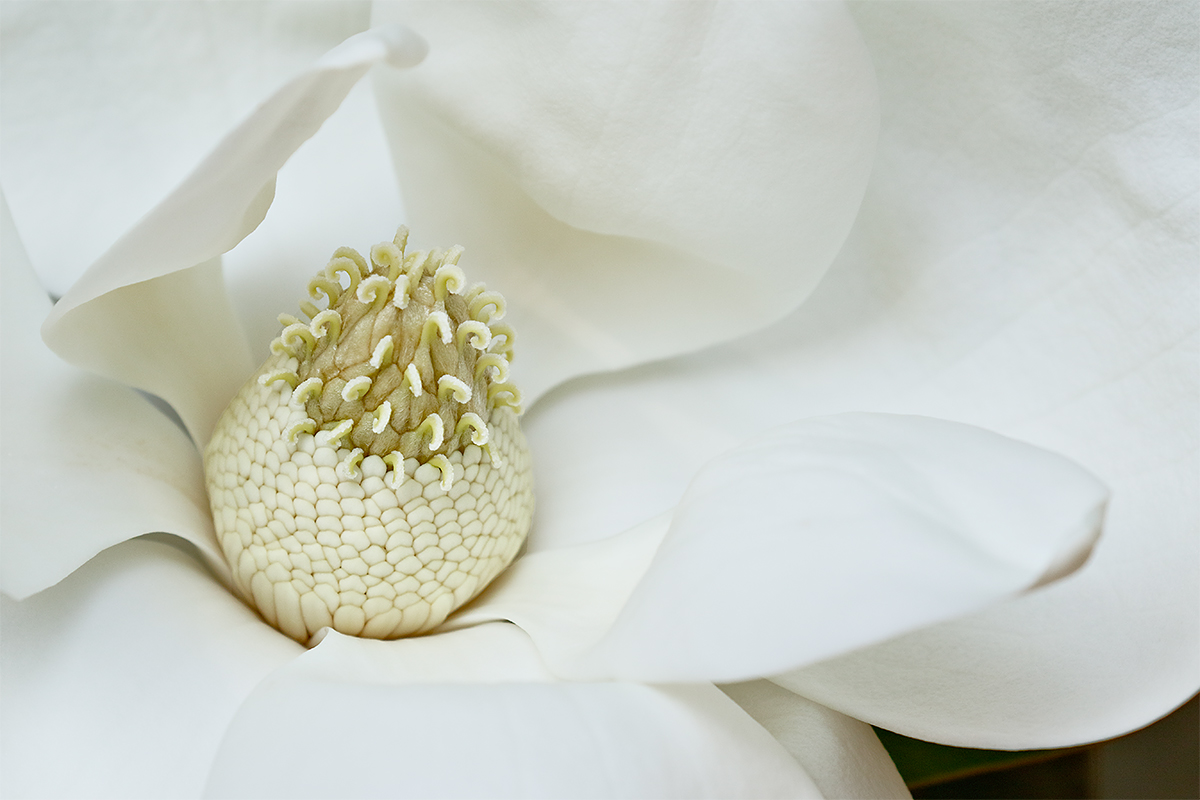
|
|
This image was created at a cemetery in North Charleston, SC with the tripod-mounted Canon EF 100-400mm f/4.5-5.6L IS II USM lens (at 340mm) and the Canon EOS 7D Mark II. ISO 400. Evaluative metering +2/3 stop: 1/500 sec. at f/8 was a small under-exposure.
Center AF point/AI Servo Surround/Rear Focus AF on the edge where the un-opened carpels meet the opened carpels and re-compose. Click here to see the latest version of the Rear Focus Tutorial. Click on the image to see a larger version.
Magnolia, fresh blossom
|
Canon 100-400mm L IS II/7D Mark II Versatility; Part 8: Charleston’s Iconic Flower
Magnolia is a large, ancient genus of flowering plants that appeared before bees did. Many are pollinated by beetles thus the carpels are extremely tough. The genus was named after the French botanist, Pierre Mangol. If anyone knows how to pronounce that name, please let us know. A web search on the came up empty. Magnolias are closely associated with all southern US states, not just South Carolina, but they sure are prolific around Charleston.
Thanks to Denise Ippolito for finding the perfect down low blossom. In the shade no less.
Facebook
Be sure to like and follow BAA on Facebook by clicking on the logo link upper right. Tanks a stack!
Support the BAA Blog. Support the BAA Bulletins: Shop B&H here!
We want and need to keep providing you with the latest free information, photography and Photoshop lessons, and all manner of related information. Show your appreciation by making your purchases immediately after clicking on any of our B&H or Amazon Affiliate links in this blog post. Remember, B&H ain’t just photography!
…..
Amazon.com
Those who prefer to support BAA by shopping with Amazon may use this link:
Amazon Canada
Many kind folks from north of the border, eh, have e-mailed stating that they would love to help us out by using one of our affiliate links but that living in Canada and doing so presents numerous problems. Now, they can help us out by using our Amazon Canada affiliate link by starting their searches by clicking here. Many thanks to those who have written.
Typos
In all blog posts and Bulletins, feel free to e-mail or to leave a comment regarding any typos or errors. Just be right :).
May 16th, 2015 Stuff
I am driving up to Charleston, SC early on Saturday morning to do some photography with Denise Ippolito who is doing additional scouting in the area for future workshops.
This blog post, the 128th in a row took about 2 hours to prepare. It was published automatically at 5:00am on Saturday morning. Enjoy denise’s great images and learn.
|
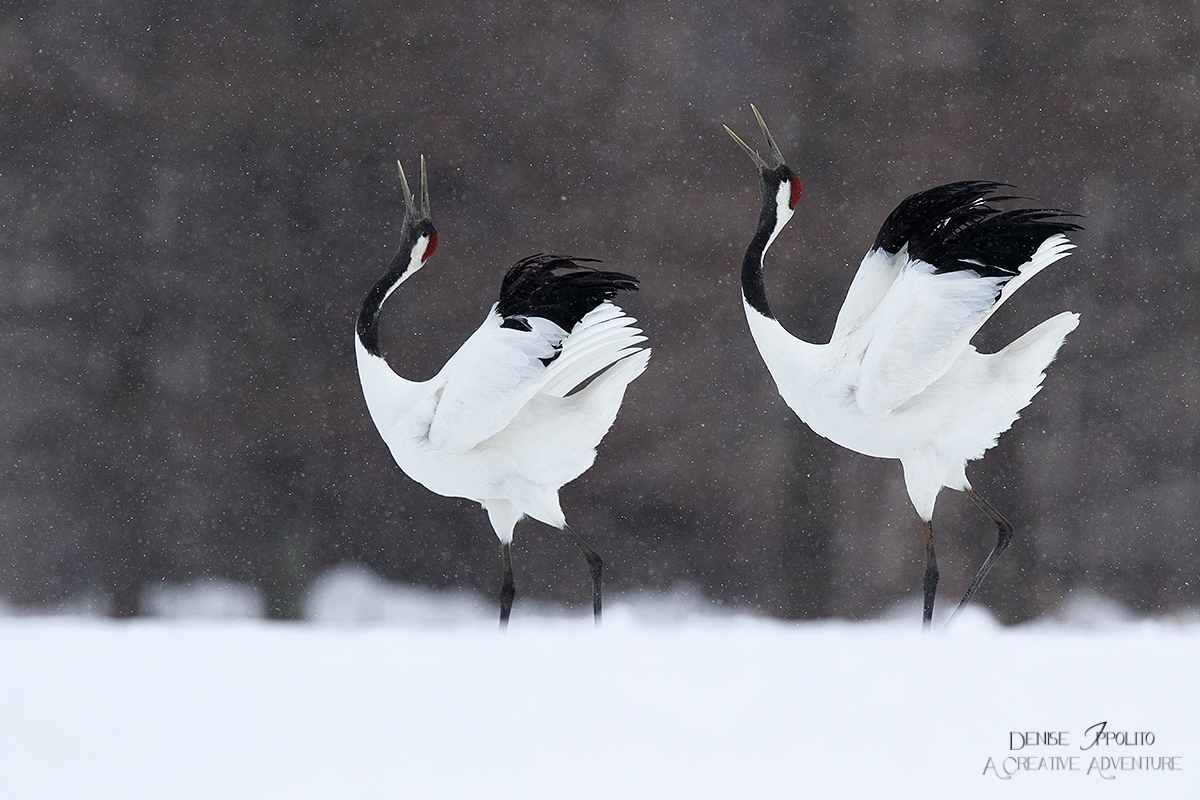
|
|
This image was created at Hokkaido, Japan this past winter by Denise Ippolito with the tripod-mounted Canon EF 600mm f/4L IS II USM lens and the Canon EOS 7D Mark II. ISO 800: 1/1600 sec. at f/6.3.
Image #1: Red-crowned Cranes, Hokkaido Japan.
Courtship calling display with woods-in-winter background.
Image courtesy of and copyright 2015 Denise Ippolito/A Creative Adventure
|
Even Denise Ippolito is Doin’ It!
Even Denise Ippolito is Doin’ What?
Even Denise Ippolito is loving her 7D Mark II whenever she needs additional reach. Can you say “bird photography?” Please remember that denise has discerning tastes when it comes to image quality and noise….
|
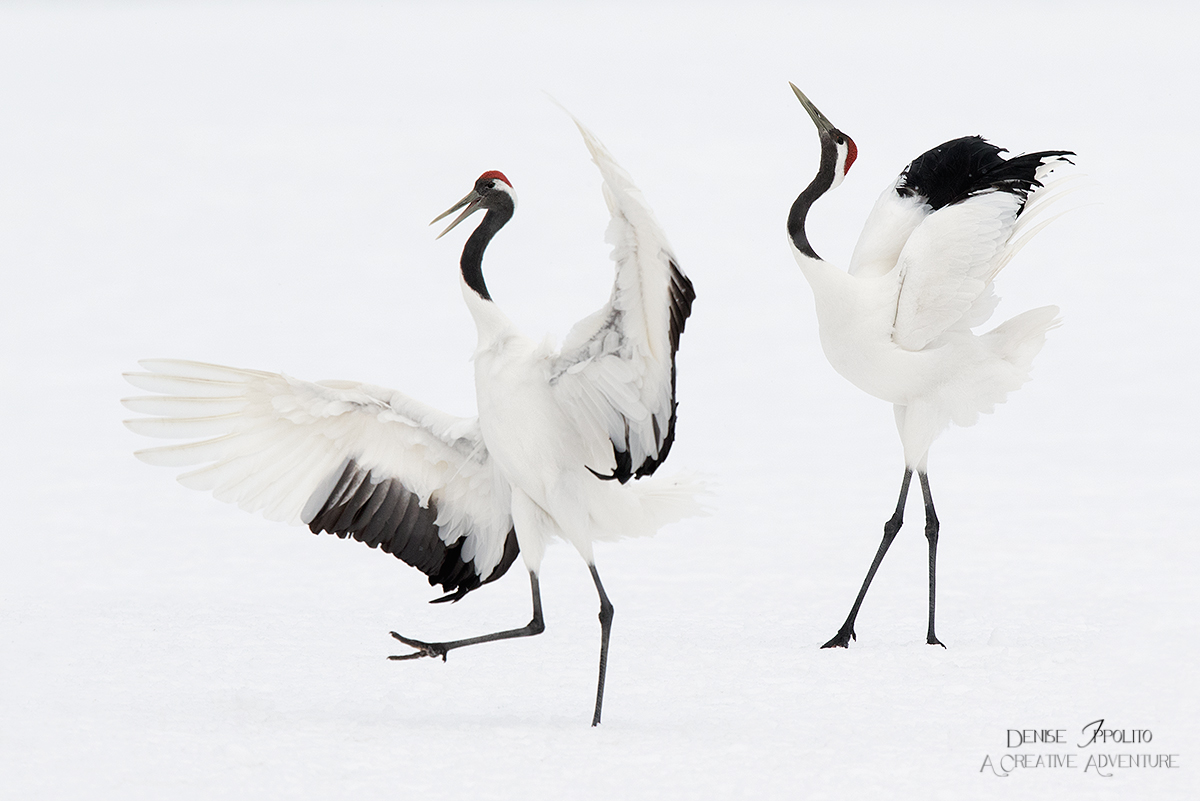
|
|
This image was created at Hokkaido, Japan this past winter by Denise Ippolito with the tripod-mounted Canon EF 600mm f/4L IS II USM lens and the Canon EOS 7D Mark II. ISO 500: 1/1250 sec. at f/7.1.
Image #2: Red-crowned Cranes, Hokkaido Japan.
Courtship Dance.
Image courtesy of and copyright 2015 Denise Ippolito/A Creative Adventure
|
Denise and the Original 7D
To put it mildly, denise did not like the original Canon 7D. She hated the small pixels and she hated the high ISO noise. I liked the camera when the sun was out and made some fine images with it, especially in San Diego where the sun is almost always shining. Except at night.
Be sure to see some of the images that top BPN Avian Forum Moderator Dan Cadieux created with his original 7D (and and the “old” 100-400) by clicking here.
BPN: Bird Photographer’s.Net: Honest critiques done gently. It ain’t just birds!
|
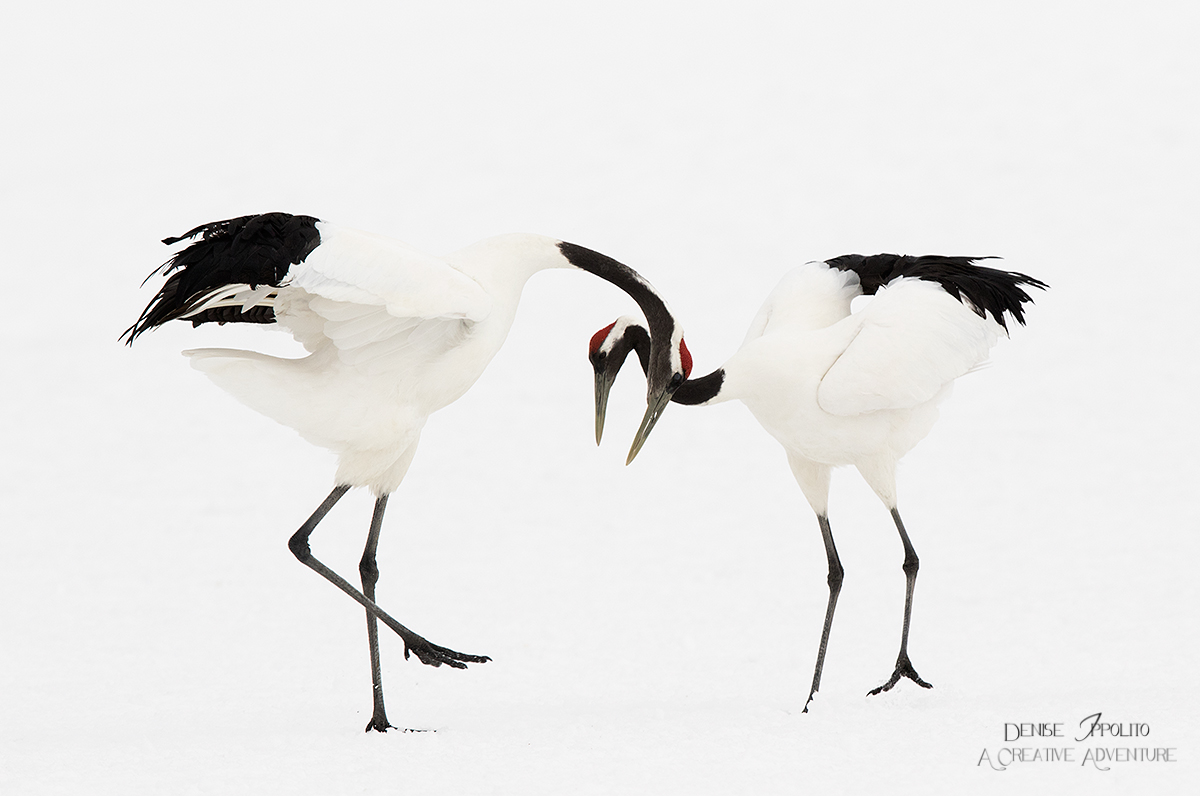
|
|
This image was created at Hokkaido, Japan this past winter by Denise Ippolito with the tripod-mounted Canon EF 600mm f/4L IS II USM lens and the Canon EOS 7D Mark II. ISO 500: 1/1250 sec. at f/8.
Image #3: Red-crowned Cranes, Hokkaido Japan.
Crossed necks courtship display.
Image courtesy of and copyright 2015 Denise Ippolito/A Creative Adventure
|
Denise on the 7D Mark II
I committed to using the 7D Mark II for nearly all of my photos in Japan this year. If I did not need the reach I opted for the Canon EOS 5D Mark III . After using my new 7D Mark II extensively on my Florida Everglades I felt 100% confident that the 7D II would perform to my standards. The sharpness and noise issues that I was initially concerned with turned out to be non-existent. The sharpness, color, noise control, and almost everything else was great.
|
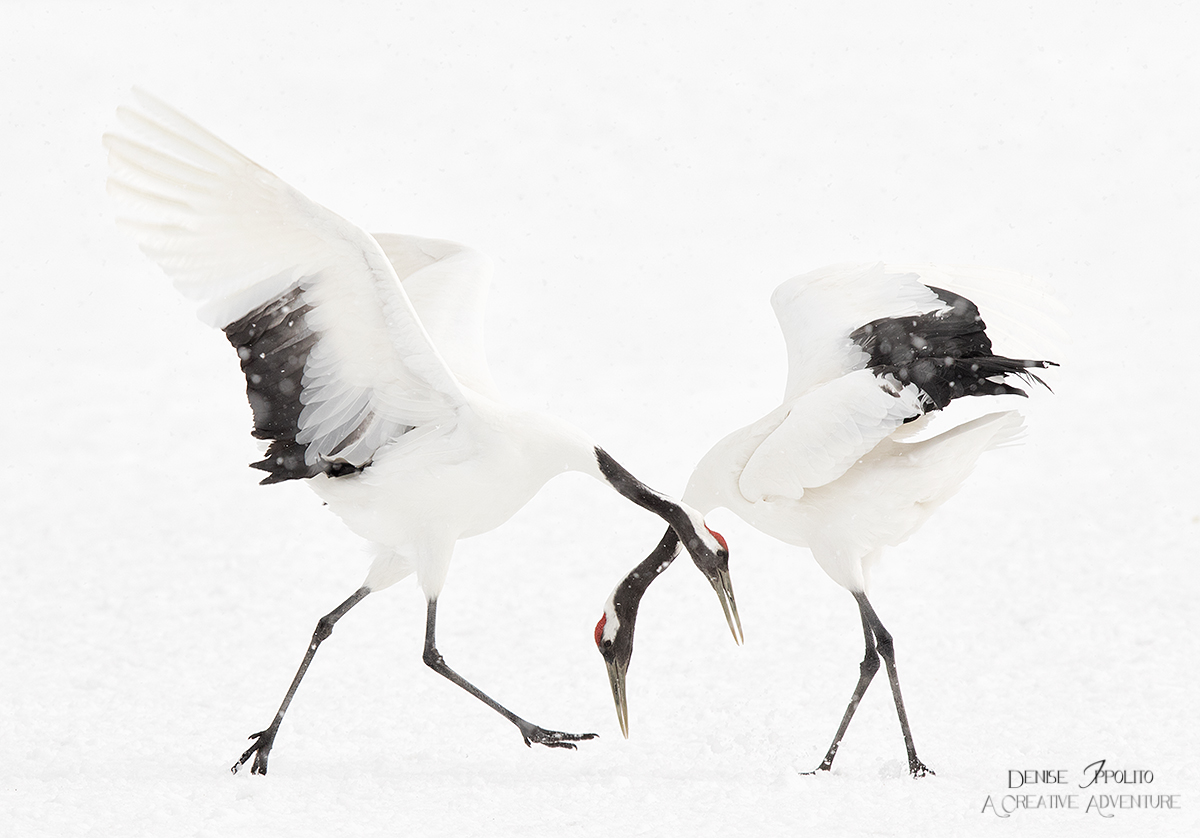
|
|
This image was created at Hokkaido, Japan this past winter by Denise Ippolito with the tripod-mounted Canon EF 600mm f/4L IS II USM lens and the Canon EOS 7D Mark II. ISO 500: 1/1250 sec. at f/8.
Image #4: Red-crowned Cranes, Hokkaido Japan.
Crossed necks courtship display/one bird with wings raised.
Image courtesy of and copyright 2015 Denise Ippolito/A Creative Adventure
|
Japan 2017 A Creative Adventure/BIRDS AS ART Instructional Photo Tour: February, 2017.
Two Great Leaders: Denise Ippolito and Arthur Morris
The Japan 2016 A Creative Adventure/BIRDS AS ART Instructional Photo Tour has been sold out with a waiting list for more than a year. We will be planning our Japan 2017 A Creative Adventure/BIRDS AS ART IPT on our visit next February. The dates will be announced upon our return. In the meantime, if you want us to save you a spot please shoot me an e-mail.


The 7D Mark II
If what you read here today and in the past has inspired you to finally purchase this great camera it would be greatly appreciated if you use my B&H logo link above.
|
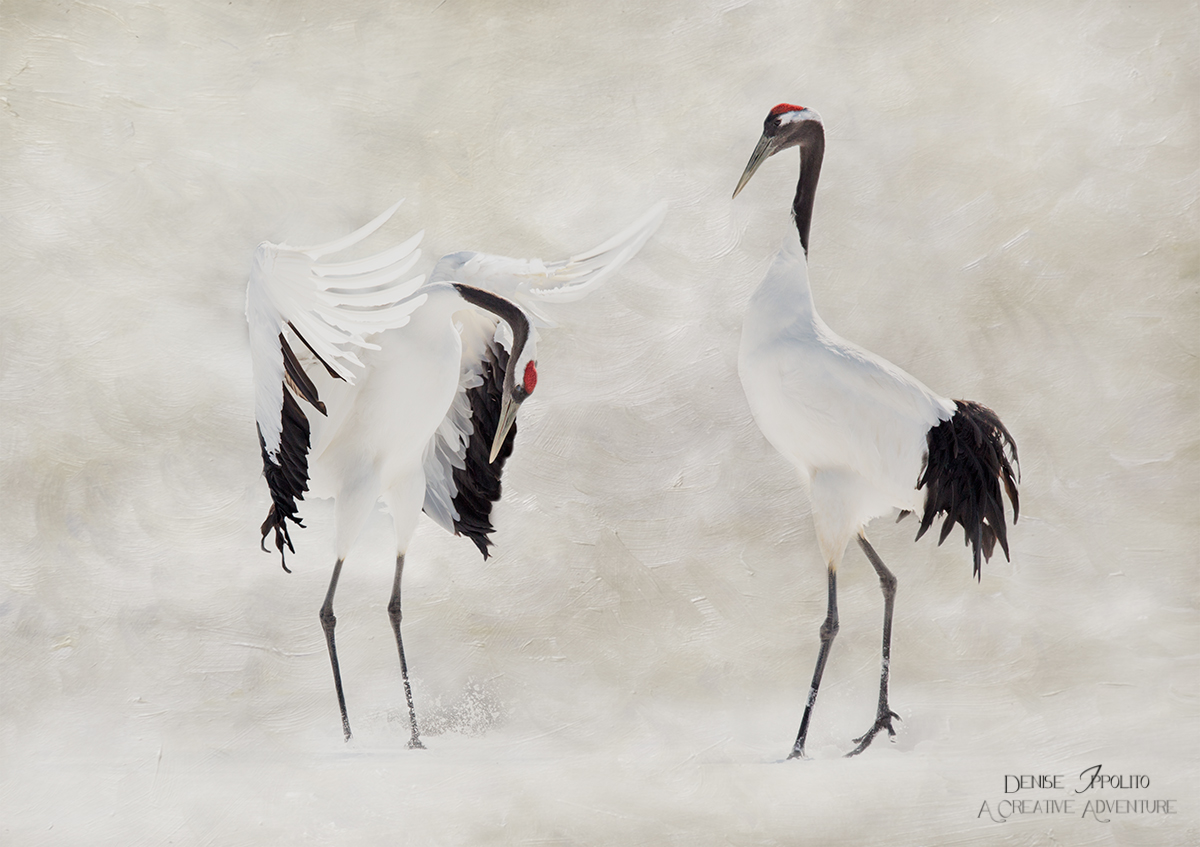
|
|
This image was created at Hokkaido, Japan this past winter by Denise Ippolito with the tripod-mounted Canon EF 600mm f/4L IS II USM lens and the Canon EOS 7D Mark II. ISO 500: 1/1600 sec. at f/6.3.
Image #5: Red-crowned Cranes.
Bowing display with Texture Overlay. Hokkaido Japan.
Image courtesy of and copyright 2015 Denise Ippolito/A Creative Adventure
|
Denise’s Photo Philosophy
I love to photograph action, flight and intimate moments. Lots of my inspiration comes from just watching my subjects as they go about their business. I look for patterns in behavior so that I can get set up and prepare for the repeats. I also look for anything out of the ordinary like a bird that is more active than the others. I also search out backgrounds; I keep my eye on those especially pleasing backgrounds and wait for my subjects to move in front of them. I am often monitoring several good situations at once so that I can switch gears at a moments notice when something materializes.
Denise’s Creativity
Simply put, denise’s creativity is unmatched.
|
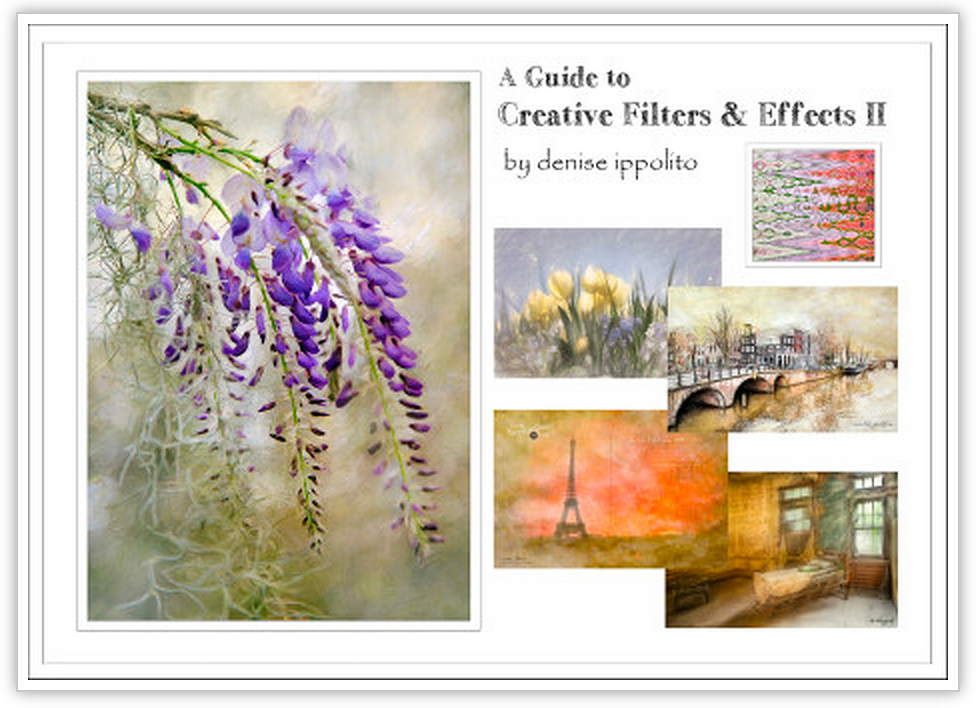
|
A Guide to Creative Filters and Effects II/a new eBook by Denise Ippolito
|
New: A Guide to Creative Filters and Effects II
In her new eBook, “A Guide to Creative Filters & Effects II,” denise shares her techniques and her amazing creative vision with you. She covers the use of texture overlays, a variety of Photoshop and plug-in filters and effects, making targeted adjustments, blending modes, layer masks, inverting color, creating black and white images, the warp tool, adding borders, flipping, pinch twirls, zoom blurs, Topaz, Snap Art, and more. Denise will expand the horizon for all creative photographers.
You can order your copy here.
|
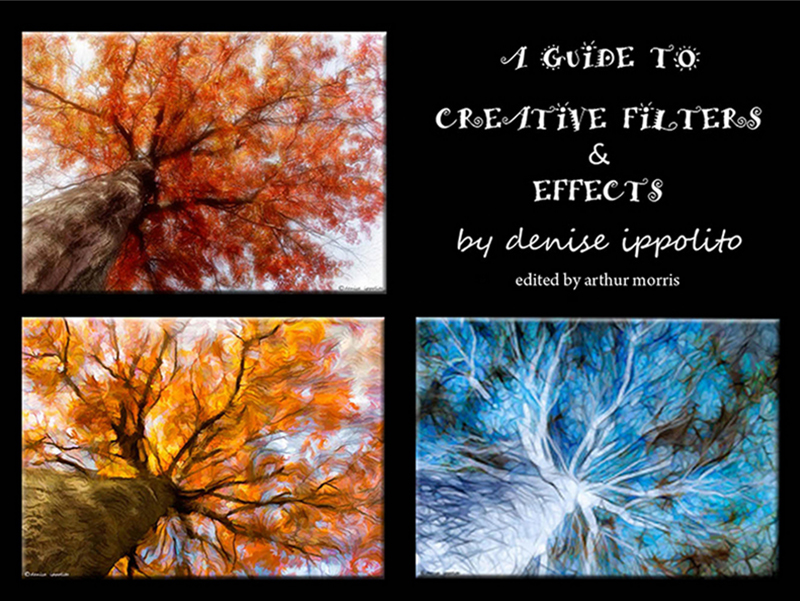
|
The Original Guide to Creative Filter’s and Effects by Denise Ippolito
|
The Original Guide to Creative Filter’s and Effects by Denise Ippolito
With the introduction of the new guide, denise’s original “A Guide to Filter’s and Effects” is on sale for $16. You can order your copy here.
Facebook
Be sure to like and follow BAA on Facebook by clicking on the logo link upper right. Tanks a stack!
Support the BAA Blog. Support the BAA Bulletins: Shop B&H here!
We want and need to keep providing you with the latest free information, photography and Photoshop lessons, and all manner of related information. Show your appreciation by making your purchases immediately after clicking on any of our B&H or Amazon Affiliate links in this blog post. Remember, B&H ain’t just photography!
…..
Amazon.com
Those who prefer to support BAA by shopping with Amazon may use this link:
Amazon Canada
Many kind folks from north of the border, eh, have e-mailed stating that they would love to help us out by using one of our affiliate links but that living in Canada and doing so presents numerous problems. Now, they can help us out by using our Amazon Canada affiliate link by starting their searches by clicking here. Many thanks to those who have written.
Typos
In all blog posts and Bulletins, feel free to e-mail or to leave a comment regarding any typos or errors. Just be right :).
May 15th, 2015 Stuff
With the shoulder healing there will be no swimming for a while but I did enjoy my ice bath. Yesterday I got five optimized hi-res files on the way to the folks at The Nat, the San Diego Natural History Museum to be used for advanced publicity for my solo exhibit. It will feature 60 of my very favorite images from the past 33 years, will be opening next January, and hang for three months. I got lots more done on Thursday including working on a few writing projects.
This blog post, the 127th in a row took about 1 1/2 hours to prepare. It was published at about 5:30am on Friday morning. Enjoy and learn.
New Used Photo Gear Listing
You can see the complete Used Photography Gear For Sale listings here.
Canon EF 100-400mm f/4.5-5.6L IS USM
Lowest-ever price on this item; this one should sell instantly!
Owen Peller is offering a used Canon EF 100-400mm f/4.5-5.6L IS USM lens excellent plus condition for $799.00. The sale includes the front and rear lenses caps, the tripod collar, the original box, the original case with strap, and insured shipping to US addresses. You can call Owen at at 954-882-1480 (eastern time) or shoot him an e-mail. Your item will not ship until your check clears unless other arrangements are made.
I owned and used this great lens for well more than a decade and created hundreds of published images with it. Denise Ippolito owned and loved hers for years.


Canon’s Huge Megapixel Bodies
Many of you have read about the two new Canon 50+ megapixel bodies, the Canon EOS 5DS DSLR and the Canon EOS 5DS R DSLR. The two cameras look, sound, and pretty much are quite similar. I have withheld commenting until now because I did not have a good–heck, I did not have any–understanding of the single difference between the two bodies, that being the Low-Pass Filter Effect Cancellation.
If you missed the hugely popular “Canon’s Two New 50+ Megapixel Camera Bodies/You Must Read This Before You Buy,” you can click here to catch up and learn a ton to boot.
Please Remember to use our Affiliate Links 🙂
To show your appreciation for my continuing efforts here, we ask, as always, that you use our the B&H and Amazon affiliate links on the right side of the blog for all of your purchases. B&H is recommended for you major photography gear purchases, Amazon for your household, entertainment, and general purpose stuff. Please check the availability of all photographic accessories in the BIRDS AS ART Online Store, especially the Mongoose M3.6 tripod heads, Gitzo tripods, Wimberley heads and plates, LensCoats and accessories, and the like. We sell only what I have used, have tested, and can depend on. We will not sell you junk. We know what you need to make creating great images easy and fun. And we are always glad to answer your gear questions via e-mail. I just learned that my account was suspended during my absence; it should be up and running by Monday at the latest.
I would of course appreciate your using our B&H affiliate links for all of your major gear, video, and electronic purchases. For the photographic stuff mentioned in the paragraph above we, meaning BAA, would of course greatly appreciate your business. Here is a huge thank you to the many who have been using our links on a regular basis and visiting the BAA Online store as well.
|
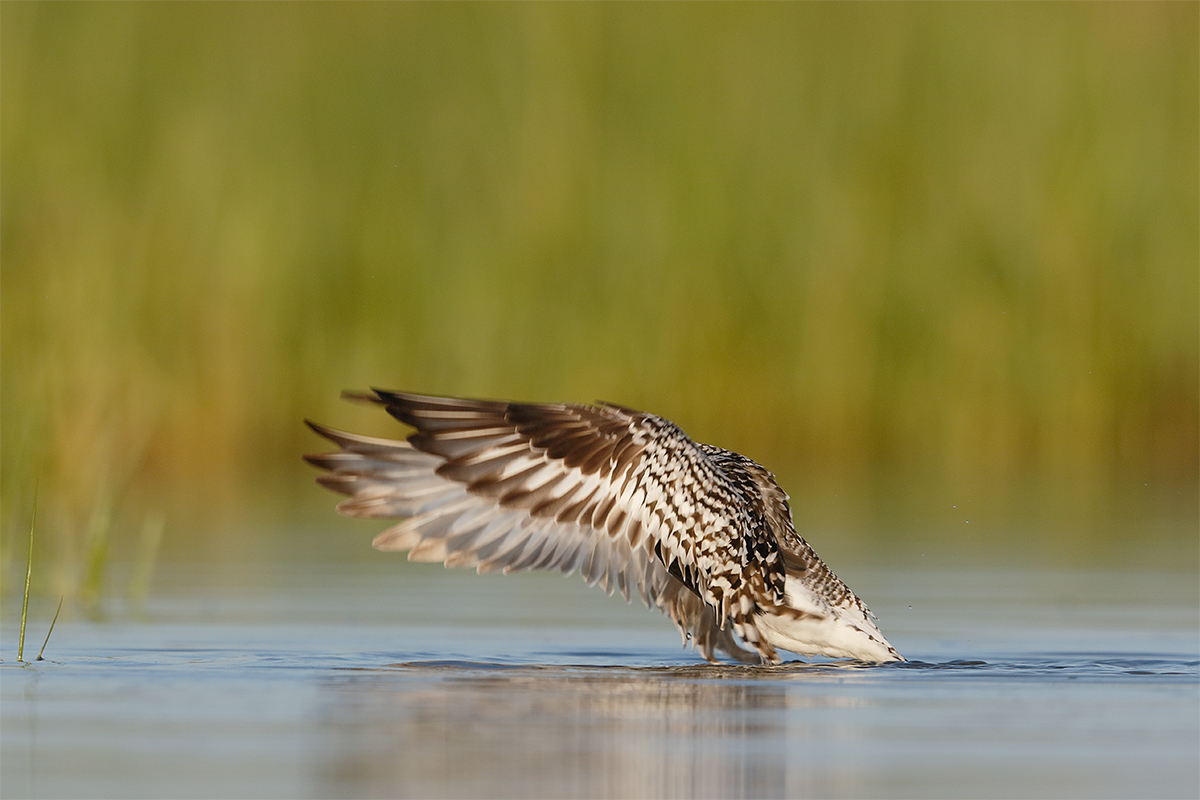
|
|
This image was created with the tripod-mounted Canon EF 600mm f/4L IS II USM lens, Canon Extender EF 1.4X III, and the Canon EOS 7D Mark II. ISO 400. Evaluative metering +1/3 stop: 1/1600 sec. at f/6.3 in Manual mode.
One AF point below the center AF point/AI Servo Surround/Rear Focus AF as originally framed was active at the moment of exposure. The selected AF point was on the lower center of the bird’s near wing. Click here to see the latest version of the Rear Focus Tutorial. Click on the image to see a larger version.
Image #1: Black-bellied Plover in breeding plumage “Look Ma, No Head”
|
Happiness Is
For me, happiness is the next breath. But when I am sitting behind my lowered tripod in a foot of water–lots more on that soon and how I fried a 1D X–on a calm morning with several shorebirds right down sun angle set against a pleasing distant, background, I am in what for me is bird photographer’s heaven. And it is exactly why I had the alarm set for 3:00am on Wednesday morning.
Bathing Bird Realizations
I am realizing more and more that when attempting to capture the after-bath flapping action that being a bit too far away is a lot better than being a bit too close. Too close and you almost always wind up clipping wings. In today’s two images we see the great advantage of being well back from the subject: you can get the whole bird in the frame on the front flap and on the overhead flap. And though I did not get it on this sequence, the same holds true for the wings-swept-all-the-way-back flap.
Exposure Fine Point Question
For the most part I was photographing Marbled Godwits and Short-billed Dowitchers in the sweet early morning light. With those two species I went with Evaluative metering +2/3 stop; that worked out to be 1/1250 sec. at 6.3. Why did I go 1/3 stop darker with the breeding plumage black-bellieds?
|
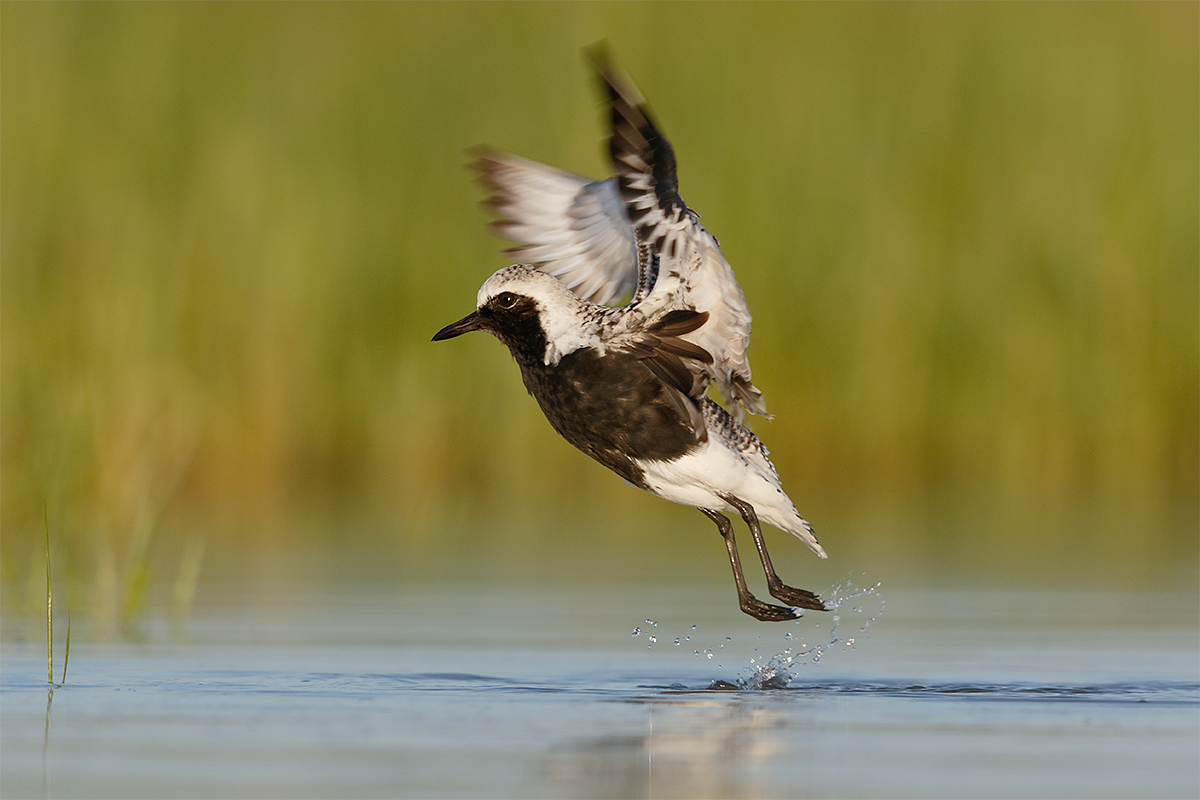
|
|
This image was created with the tripod-mounted Canon EF 600mm f/4L IS II USM lens, Canon Extender EF 1.4X III, and the Canon EOS 7D Mark II. ISO 400. Evaluative metering +1/3 stop: 1/1600 sec. at f/6.3 in Manual mode.
One AF point below the center AF point/AI Servo Surround/Rear Focus AF as originally framed was active at the moment of exposure. The selected AF point was just below the bird’s rear belly; the three assist point directly above the selected point surely helped maintain accurate focus. Click here to see the latest version of the Rear Focus Tutorial. Click on the image to see a larger version.
Image #2: Black-bellied Plover in breeding plumage “Ballet
|
Image Questions…
Which Came First?
Which image was created first in this two-frame sequence? How do you know? Please be specific.
Did I Move the Lens?
Did I move the lens when creating this two-frame sequence? How do you know? Please be specific.
The Fort DeSoto Site Guide
Though the sandbars at Fort DeSoto change every season with storms, the basics remain the same. The best spots are still the best spots and they are all covered in detail in the great Fort DeSoto Site Guide. Why spend days when visiting a new location when you can quickly learn when and where to be on what tide in what lighting conditions and on what winds? And if you are familiar with the basics at DeSoto you will find that the site guide shares lots of little tidbits that will make the purchase price well worthwhile.
You can check and see if there is a BAA Site Guide for your next photographic destination by clicking here.
Facebook
Be sure to like and follow BAA on Facebook by clicking on the logo link upper right. Tanks a stack!
Support the BAA Blog. Support the BAA Bulletins: Shop B&H here!
We want and need to keep providing you with the latest free information, photography and Photoshop lessons, and all manner of related information. Show your appreciation by making your purchases immediately after clicking on any of our B&H or Amazon Affiliate links in this blog post. Remember, B&H ain’t just photography!
…..
Amazon.com
Those who prefer to support BAA by shopping with Amazon may use this link:
Amazon Canada
Many kind folks from north of the border, eh, have e-mailed stating that they would love to help us out by using one of our affiliate links but that living in Canada and doing so presents numerous problems. Now, they can help us out by using our Amazon Canada affiliate link by starting their searches by clicking here. Many thanks to those who have written.
Typos
In all blog posts and Bulletins, feel free to e-mail or to leave a comment regarding any typos or errors. Just be right :).
May 14th, 2015 Stuff
The alarm was set for 3:00am yesterday but I woke at 2:25 and started getting things together for our Fort DeSoto/Dr. Rucker outing. Jim woke at 3:30am and we were on our way at 4:02. We arrived at North Beach at 6:30. There was not much going on at my favorite morning spot but I stuck it out. I started with some nice Marbled Godwit sunrise silhouettes. After that, the few birds that were present flew off as the tide advanced. I found a preening Wilson’s Plover and worked that for a while. Next was a single Marbled Godwit who was soon joined by a few more shorebird friends. On the way out I stumbled across two Wilson’s Plover chicks and got a few frames. Then it was off to Bradenton to get multiple injections. Those hurt a bit but overall everything went well. I did look at the images last night and was a bit disappointed; I got a new 1.4X TC and it it obvious that it needs to be micro-adjusted with the 600 II and my 7D II….
On the Way Home
Next we stopped for some good Thai food in Bradenton. It is almost 3pm as I am typing. Jim is driving. God bless him. Having left my great new Delkin USB 3.0 High Speed Dual Slot Card Reader at home I will not get to see my images for a while. But I am sure that I got a few good ones that I will be sharing with you here soon.
This blog post, the 126th in a row, took about 1 1/2 hours to prepare. It was published automatically at 5:00am on Thursday morning.
By e-mail from Jim Robellard
Artie:
I can’t thank you enough for the great learning experience in St Augustine. As I look over the pictures from the IPT I can see the progress and increases in quality and possibilities from day to day. I wanted to really learn the camera and the flash and as I told a friend, I learned more about the 7D Mark II from you in a few days than I have in years of working with various cameras. It is one thing to read the Canon Instruction Manual, your great 7D Mark II User’s Guide, and the Canon autofocus manual, but to have you point out things to help me understand the camera to make it really sings for each scenario was and is amazing. I still love the flash-as-main light photos we did and the fill flash as well, but as someone who has gone to many a studio shoot for work, I’m thinking “This really looks like we posed Mrs. Egret in the studio.” it was truly amazing.
All the best and thanks again for sharing your knowledge with us both daily on the blog and on your IPTs. If you ever want to come down our way to shoot Tigertail or Corkscrew, Judy and I want to extend you an invitation to stay at the house here on Marco Island. I know your travel schedule is brutal and we travel as well but let’s keep in touch. PS: Judy’s a great cook and is just learning to deal with her diabetes. Good health and safe travels.
Jim
Quasi-Flash as Main Light
I call the technique used to create today’s featured image “quasi-flash as main light” because it combines elements of fill flash (work in Manual mode and get the ambient exposure right) with elements of flash as main light (use enough flash to completely and correctly illuminate the subject). Add a white sky background and you will wind up with a gorgeous studio look.
How did I determine the two correct exposures? For the ambient I went with +3 stops off the white sky. No surprise there. Then I simply varied the flash settings while looking at the image on the rear LCD. The only time that I want folks judging the look of an image on the rear LCD is when they need to determine the effectiveness of the flash…. For all the rest, get in the habit of using both your luminance and RGB histograms.
Coming Soon
I will be doing an illustrated blog post soon showing exactly why you need to have your flash on a flash bracket when using a super-telephoto lens. The picture will be worth a thousand words…. Check out the various flash bracket options here or shoot me an e-mail with questions. More soon on flash brackets as well.
Facebook
Be sure to like and follow BAA on Facebook by clicking on the logo link upper right. Tanks a stack!
Support the BAA Blog. Support the BAA Bulletins: Shop B&H here!
We want and need to keep providing you with the latest free information, photography and Photoshop lessons, and all manner of related information. Show your appreciation by making your purchases immediately after clicking on any of our B&H or Amazon Affiliate links in this blog post. Remember, B&H ain’t just photography!
…..
Amazon.com
Those who prefer to support BAA by shopping with Amazon may use this link:
Amazon Canada
Many kind folks from north of the border, eh, have e-mailed stating that they would love to help us out by using one of our affiliate links but that living in Canada and doing so presents numerous problems. Now, they can help us out by using our Amazon Canada affiliate link by starting their searches by clicking here. Many thanks to those who have written.
Typos
In all blog posts and Bulletins, feel free to e-mail or to leave a comment regarding any typos or errors. Just be right :).
May 13th, 2015 Stuff
I sent more than a hundred e-mails in a 24 hour period from Monday into Tuesday. Par for the course. I had a nice swim and enjoyed my ice bath. I had a phone conference with the folks at The Nat, the San Diego Natural History Museum. It is looking very much as if there will be a solo exhibit with 60 of my very favorite images from the past 33 years opening next January and hanging for three months. Nice :).
Jim and I are headed to Fort DeSoto this morning for a short busman’s holiday and then driving down to Bradenton for another series of PRP, Stem Cell, and Prolozone injections on my right shoulder and right middle (trigger finger). Two of my three existing trigger fingers were healed completely with the last set of injections and the right middle is 90% better. The shoulder was doing great for about a year until I tweaked it about 2 months ago….
This blog post, the 125th in a row took about 1 1/2 hours to prepare. It was published automatically at 5:00am on Wednesday morning.
|
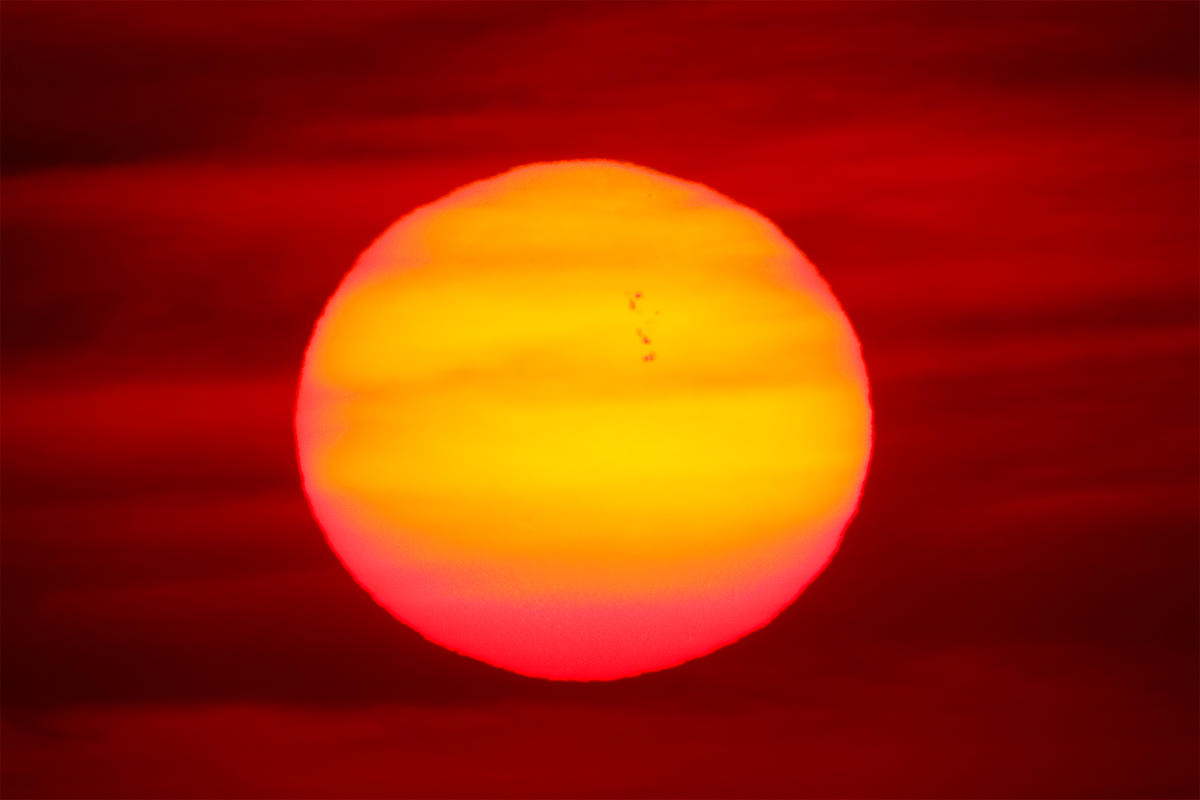
|
|
This image was created down by the lake near my home as part of my Sunset Addiction project. I used the tripod-mounted Canon EF 600mm f/4L IS II USM lens, the Canon Extender EF 2X III, and the amazing Canon EOS 7D Mark II. ISO 400. Evaluative metering at zero: 1/1250 sec. at f/11.
Center AF point (by necessity)/AI Servo Expand/Rear Focus AF on the edge of the sun and and re-compose. There are no worries on that when you are on a tripod (as opposed to when you are working from the car on a BLUBB. Click here to see the latest version of the Rear Focus Tutorial. Click on the image to see a larger version.
Sun at 7:57pm on May 9, 2015 at Indian Lake Estates, FL
|
Mega-Sun Fun
I like getting up and out very early. And I like staying in the field until well after sunset. Whenever I see a well muted sun I just cannot resist going long and created large-in-the-frame images of the orb that is our celestial light source. Every sunset is slightly different with different color tones and different skies. At times, the patterns of clouds can add drama to such images. And with the 7D II it is no longer necessary to stack extenders; a 600mm lens with a 2X III teleconverter and a 7D Mark II will produce a huge sun straight up. Remember that it is important that the sun be well muted, covered by a thin layer of clouds or fog, lest you risk damaging your retina. On clear mornings or evening the sun can damage our eyes even when it is touching the horizon.
Exposure Notes
If you need to underexpose more than a stop to prevent blinkies on a huge in the frame sun, you probably should not be looking through your lens at it. In this image the sun was so well muted that zero was fine. I could have even gone to +1/3. The big advantage in situations like this is that the sky does not go black.
Worthless or Worthwhile?
Many a stock agent has shown great interest in my huge suns. (I have been creating them for several decades even in the prehistoric days of film.) The truth however, is that I can barely recall ever selling one. Has it been worth it? For me, of course. No sales does not mean no fun: I love creating this type of image and will keep making them until I can no longer lift a big lens.
Sunspots
Are the small dark marks on the face of the sun sunspots? If not, what are they? If yes, can anyone shed some light as to what causes them? (Please pardon the sun pun.)
|

|
|
All of the images in the bear boat card above were created in Katmai National Park during the month of September.
|
Bear Boat/Bears Catching Salmon IPT: September 1-8, 2015 from Kodiak, AK/6 FULL & 2 1/2 DAYS: $6699. Happy campers only! Maximum 8/Openings: 3. Plus the leader: Arthur Morris.
This trip is a go.
Join me in Katmai National Park, AK for seven days of photographing Coastal Brown Bears (grizzlies) catching salmon, fattening up for the long winter. Other subjects will include Mew and Glaucous-winged Gulls in flight and dip-feeding on salmon roe. Did I mention that we live on a boat and that the food is great? Most of our photography will be done in a variety of famed locations: Geographic Harbor, Kinak Bay, and Kukak Bay. We once had 39 bears fishing the creek at Kukak….
It is mandatory that you be in Kodiak no later than the late afternoon of August 31, 2015 September to avoid missing the float planes to the boat on the morning of September 1. With air travel in AK being what it is, with the chance of fog or other bad weather–being on Kodiak on August 30 is an even better plan). I will be on Kodiak on August 30 to avoid any potential disaster. That said in my nearly a dozen bear boat trips I was delayed only once but since I was day early as noted above there was no harm, no foul.
We will take one or more float planes to the boat mid-morning on September 1. We will photograph bears fishing that afternoon and every day for the next six days (weather permitting of course). We should have bears catching salmon every day. In addition, we will get some nice stuff on Mew Gull and Glaucous-winged Gulls dining on roe and the remains of predated salmon. We may–depending on where the concentrations of bears are–get to photograph Harbor seals and some hauled out Steller’s Sea Lions (an endangered species). Halibut fishing (license required) is optional. On September 8, our last morning on the boat, those who would like to enjoy one last photo session will do so. The group returns to Kodiak via float plane midday. Most folks will fly to Anchorage and then continue on red-eye flights to their home cities.
The eight days will consist of six full days (Sept 2, 3, 4, 5, 6, & 7) of photography featuring lots of Coastal Brown Bears catching salmon as above plus a variety of other natural history subjects plus some nice scenic photography that I forgot to mention above. Plus the first afternoon and the last morning.
What’s included? 8 DAYS/7 NIGHTS on the boat as above. All meals on the boat. (The food is quite excellent.) National Park fees. One night’s double occupancy lodging on Kodiak; arrive: Sept 1/depart: Sept 2. The thank-you-in-advance dinner on Sept 1. In-the-field photo tips, instruction, and guidance. An insight into the mind of a top professional; I will constantly let you know what I am thinking, what I am doing, and why I am doing it. Small group image review, image sharing, and Photoshop instruction on the boat.
What’s not included: Your round trip airfare to and from Kodiak, AK (almost surely through Anchorage). All necessary lodging other than the cost of your double occupancy room on the night of August 31 should you opt to arrive early–we can arrange that in advance for you. We will let you know the cost of a single supplement for the one night if so desired. The cost of the round-trip float plane to the boat on September 2 and back to Kodiak on September 9. The cost of a round trip this year was $500. The suggested crew tip of $210.
Is this an expensive trip? Yes, of course. But with 6 full and two half days, a wealth of great subjects, and the fact that you will be walking with the bears just yards away (or less….) it will be one of the great natural history experiences of your life. Most folks who take part in a Bear Boat IPT wind up coming back for more.
A $2,000 per person non-refundable deposit by check only made out to “Arthur Morris” is required to hold your spot. Please click here to read our cancellation policy. Then please print, read, and sign the necessary paperwork here and send it to us.
Your deposit is due immediately. That will leave a balance of $4699. The next payment of $2699 will be due on February 15, 2015. The final payment of $2000 is due on May 1, 2015.
I hope that you can join us for this wondrously exciting trip.
By e-mail from Bill Keown, veteran of three bear boat trips!
Hi Artie, What a great trip! With the exception of the one bright sunny day it was just great. Very different from my first trip in June where we only had the bears clamming; the fishing bears were amazing! As always I learned a lot and enjoyed the group immensely. All the Best, Bill
Facebook
Be sure to like and follow BAA on Facebook by clicking on the logo link upper right. Tanks a stack!
Support the BAA Blog. Support the BAA Bulletins: Shop B&H here!
We want and need to keep providing you with the latest free information, photography and Photoshop lessons, and all manner of related information. Show your appreciation by making your purchases immediately after clicking on any of our B&H or Amazon Affiliate links in this blog post. Remember, B&H ain’t just photography!
…..
Amazon.com
Those who prefer to support BAA by shopping with Amazon may use this link:
Amazon Canada
Many kind folks from north of the border, eh, have e-mailed stating that they would love to help us out by using one of our affiliate links but that living in Canada and doing so presents numerous problems. Now, they can help us out by using our Amazon Canada affiliate link by starting their searches by clicking here. Many thanks to those who have written.
Typos
In all blog posts and Bulletins, feel free to e-mail or to leave a comment regarding any typos or errors. Just be right :).
May 12th, 2015 Stuff
I spent much of Monday answering e-mails and planning the January 2016 San Diego IPT (dates TBA soon). I enjoyed a nice 60-lengths of the pool swim and an ice bath. I watched Rickie Fowler’s incredible 8 under par on the last ten holes playoff victory at the Player’s Championship and the NY Rangers amazing, heart-stopping, game-seven-forcing victory over the Washington Capitals, both on Tivo. In the evening I helped Denise Ippolito edit a great Warp Tool tutorial she is posting today on her blog and caught up on some NBA playoff games; right now LeBron James and the Cavaliers are in deep trouble against the Chicago Bulls….
This blog post, the 124th in a row, took about 2 1/2 hours to prepare. It was published automatically at 4:00am on Tuesday morning.
|
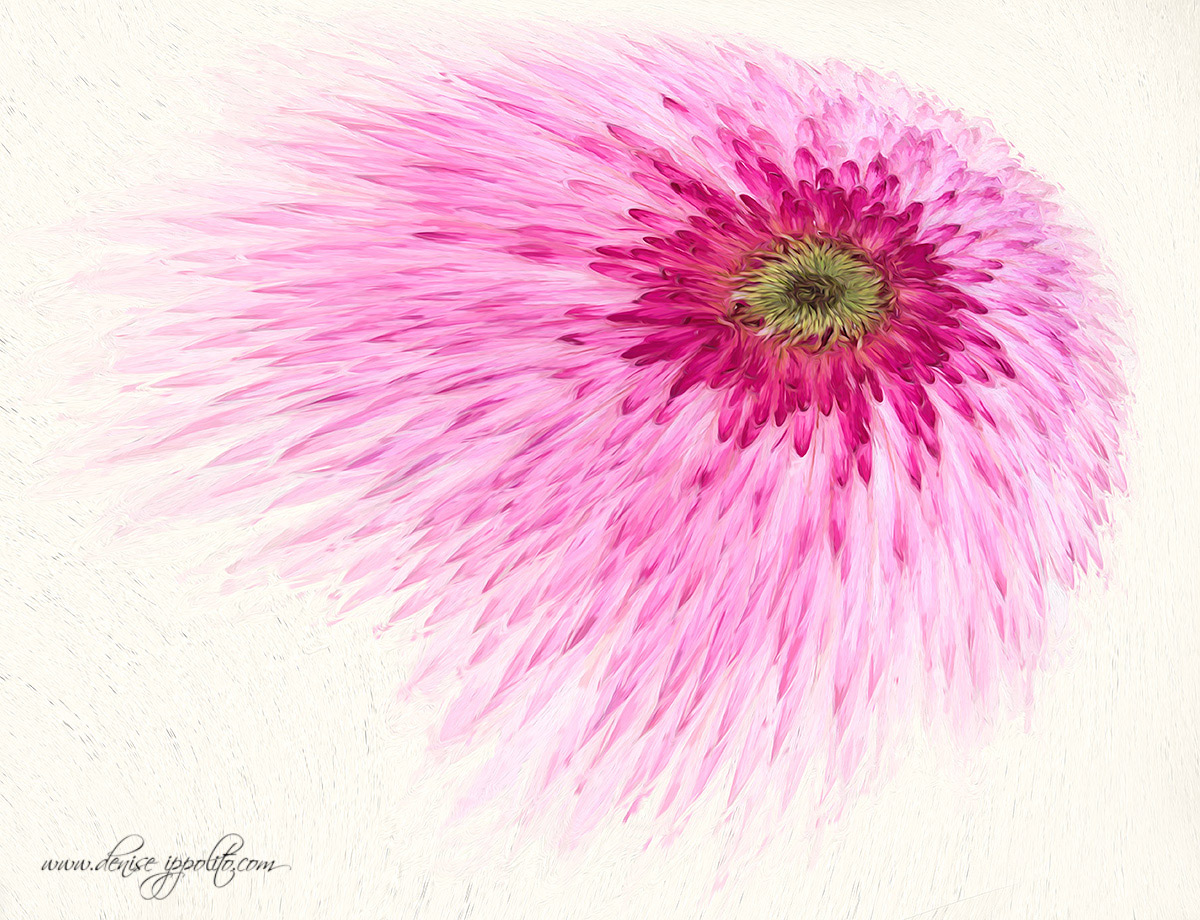
|
Gerbera Daisy Warp Tool Creation: Image courtesy of and copyright 2015: Denise Ippolito/A Creative Adventure
|
Warp Tool Tutorial
You can check out denise’s Warp Tool tutorial here.
Important Notes
I responded to all the comments on the Extreme Focal Length/High Contrast Chicks blog post here.
In addition, I responded to all the comments in the Flash Not Possible for the Two Chicks in the Nest Image blog post here. In answer to the question about why I chose my perspective so carefully David Peake of New Zealand nailed it when he wrote, It’s all about getting the chicks in front of that dark background.
Do understand that reading, studying, and checking back on the comments can heighten your learning experience.
New Used Photo Gear Listing
You can see the complete Used Photography Gear For Sale listings here.
Canon EF 100-400mm f/4.5-5.6L IS USM
Lowest-ever price on this item; this one should sell instantly!
Owen Peller is offering a used Canon EF 100-400mm f/4.5-5.6L IS USM lens excellent plus condition for $799.00. The sale includes the front and rear lenses caps, the tripod collar, the original box, the original case with strap, and insured shipping to US addresses. You can call Owen at at 954-882-1480 (eastern time) or shoot him an e-mail. Your item will not ship until your check clears unless other arrangements are made.
I owned and used this great lens for well more than a decade and created hundreds of published images with it. Denise Ippolito owned and loved hers for years.


Canon’s Huge Megapixel Bodies
Many of you have read about the two new Canon 50+ megapixel bodies, the Canon EOS 5DS DSLR and the Canon EOS 5DS R DSLR. The two cameras look, sound, and pretty much are quite similar. I have withheld commenting until now because I did not have a good–heck, I did not have any–understanding of the single difference between the two bodies, that being the Low-Pass Filter Effect Cancellation.
If you missed the hugely popular “Canon’s Two New 50+ Megapixel Camera Bodies/You Must Read This Before You Buy,” you can click here to catch up and learn a ton to boot.
Please Remember to use our Affiliate Links 🙂
To show your appreciation for my continuing efforts here, we ask, as always, that you use our the B&H and Amazon affiliate links on the right side of the blog for all of your purchases. B&H is recommended for you major photography gear purchases, Amazon for your household, entertainment, and general purpose stuff. Please check the availability of all photographic accessories in the BIRDS AS ART Online Store, especially the Mongoose M3.6 tripod heads, Gitzo tripods, Wimberley heads and plates, LensCoats and accessories, and the like. We sell only what I have used, have tested, and can depend on. We will not sell you junk. We know what you need to make creating great images easy and fun. And we are always glad to answer your gear questions via e-mail. I just learned that my account was suspended during my absence; it should be up and running by Monday at the latest.
I would of course appreciate your using our B&H affiliate links for all of your major gear, video, and electronic purchases. For the photographic stuff mentioned in the paragraph above we, meaning BAA, would of course greatly appreciate your business. Here is a huge thank you to the many who have been using our links on a regular basis and visiting the BAA Online store as well.
|
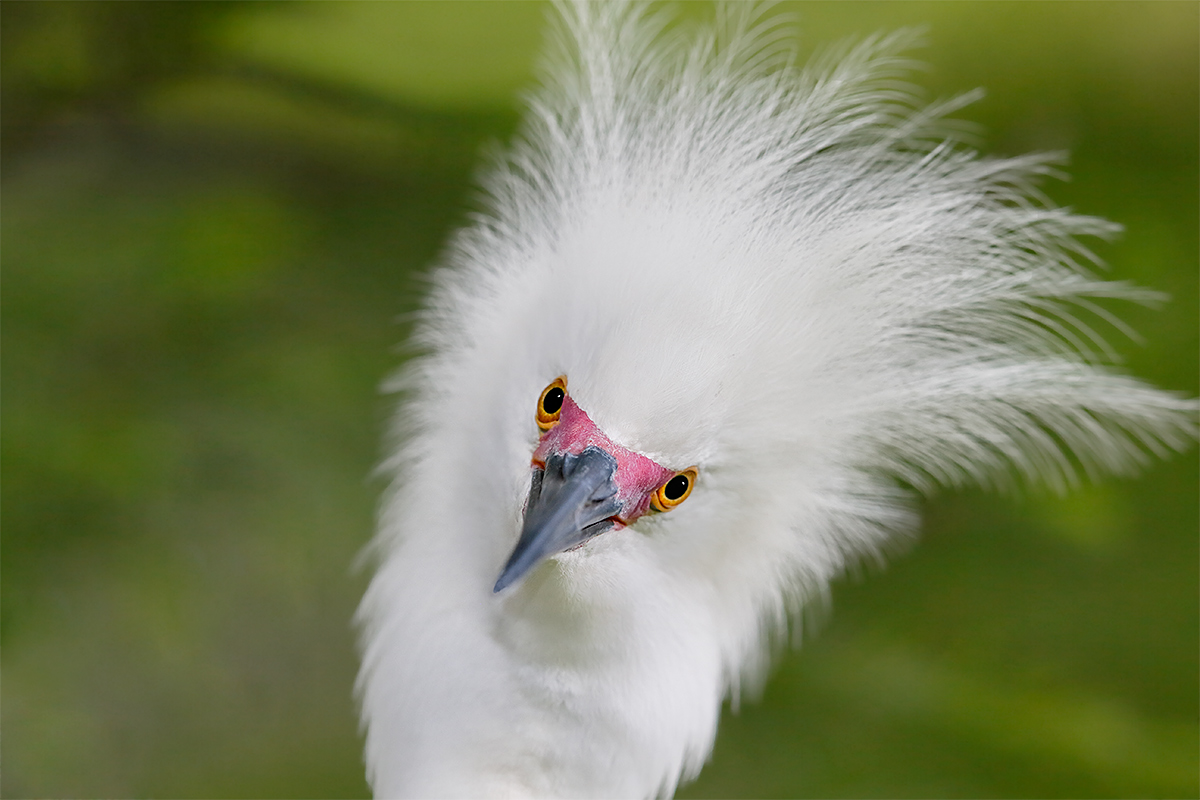
|
|
This image was created with the tripod-mounted Canon EF 600mm f/4L IS II USM lens, Canon Extender EF 1.4X III, and the Canon EOS-1D X . ISO 800: 1/160 sec. at f/8 (was more than a one stop underexposure; not sure how that happened….)
Fill flash at -3 stops with a Better Beamer on the Canon Speedlite 600EX-RT.
One AF point to the right of and one row below the center AF point/AI Servo Surround/Rear Focus AF as framed was active at the moment of exposure. The selected AF point was just above the bird’s right eye; the AF point just below that one was surely assisting as it fell squarely on the bird’s eye. Click here to see the latest version of the Rear Focus Tutorial. Click on the image to see a larger version.
Snowy Egret in full breeding plumage displaying in a shady spot
|
My #1 Tip for Photographing Birds in Bright Sun
On the recently concluded IPT there were dozens of folks (not on the IPT) who spent whole mornings photographing 90 degrees off sun angle from 8:30 to 10:30am for two reasons:
#1: They liked being close to lots of birds.
#2: They did not know any better. See my #1 tip for photographing birds in bright sun immediately below.
My #1 tip for photographing birds in bright sun is to point your shadow at the bird. That means that the sun should be coming right over the top of your head. Working no more than 15 degrees off sun angle can be effective if you are careful about how the sunlight hits the bird’s face. And that has everything to do with opening your eyes with regards to head angle.
My #2 Tip for Photographing Birds in Bright Sun
My #2 tip when facing the prospect of photographing birds in bright sun is to look for subjects in the shade.
And that is just what we were doing when we found the gorgeous male Snowy Egret that is the subject in today’s featured image.
Facebook
Be sure to like and follow BAA on Facebook by clicking on the logo link upper right. Tanks a stack!
Support the BAA Blog. Support the BAA Bulletins: Shop B&H here!
We want and need to keep providing you with the latest free information, photography and Photoshop lessons, and all manner of related information. Show your appreciation by making your purchases immediately after clicking on any of our B&H or Amazon Affiliate links in this blog post. Remember, B&H ain’t just photography!
…..
Amazon.com
Those who prefer to support BAA by shopping with Amazon may use this link:
Amazon Canada
Many kind folks from north of the border, eh, have e-mailed stating that they would love to help us out by using one of our affiliate links but that living in Canada and doing so presents numerous problems. Now, they can help us out by using our Amazon Canada affiliate link by starting their searches by clicking here. Many thanks to those who have written.
Typos
In all blog posts and Bulletins, feel free to e-mail or to leave a comment regarding any typos or errors. Just be right :).
May 11th, 2015 Stuff
I spent most of Sunday getting the images and captions for my San Diego article to Helen Longest Saccone at Nature Photographer Magazine after my Friday efforts failed: Apple Mail downsized the photo attachments 🙁
This blog post, the 123rd in a row, took about 2 1/2 hours to prepare. It was published at 6:53 am on Monday morning.
Used Photography Gear/New Listings Below
You can see the complete Used Photography Gear For Sale listings here.
Canon EF 100-400mm f/4.5-5.6L IS USM
Barbara Garmon is offering a used Canon EF 100-400mm f/4.5-5.6L IS USM lens in like-new condition for $899.00. The lens is cosmetically and operationally perfect. The sale includes the original box, the front and rear lens caps, the original box, the ET-83C lens hood, the LZ1324 lens case, and insured shipping to US addresses. You can call Barbara on her cell at 641-777-2578 (eastern time zone) or reach her via e-mail.
I owned and used this great lens for well more than a decade and created hundreds of published images with it. Denise Ippolito owned and loved hers for many years.
Canon EOS 7D DSLR Digital Camera Body (with battery grip)
Barbara Garmon is also offering a used Canon EOS 7D DSLR Digital Camera Body and the Canon BG-E7 Battery Grip in like-new condition for $579.00 (with lots of extras). There are no scratches or dings on the body that is in perfect operating condition.
The sale includes two (used) LP-E6 Rechargeable Lithium-Ion Battery Packs (7.2V, 1800mAh) and the the original box along with everything that came in it: one LC-E6 Charger, the IFC-200U USB Interface Cable – 6/9” (1.9m), the front body cap, the Stereo A/V Cable AVC-DC400S, the Wide Neck Strap EW-EOS7D, the Eyecup Eg, the Software CD-ROM, and the Instruction Manual. The sale also includes several items purchased separately: the official Canon E1 hand strap (only third party straps are available now), an OPTECH Super Pro Strap “B,” and the aforementioned Canon BG-E7 Battery Grip (with storage pouch). All that plus insured shipping to US addresses. You can call Barbara on her cell at 641-777-2578 (eastern time zone) or reach her via e-mail.
A used 7D makes a great entry level DSLR. Be sure to see the great images that Dan Cadieux created with his original 7D (and and the “old” 100-400) here.
Used Canon EF 100-400 f 4.5-5.6 L IS Lens
Price reduced $150 on 5/11/2015!
Multiple IPT veteran Jack Panzeca is offering a used Canon EF 100-400 f 4.5-5.6 L IS lens in very good + condition for $849 including insured shipping via UPS Ground to US addresses only. The tripod collar has one small scratch. The sale includes the original tough fabric case, the original box, the front and rear caps, the lens hood, and the strap. Your gear will be shipped only after your check clears.
Please contact Jack via e-mail or by phone at 817 819 1756. Central Time Zone.
The 100-400 is a versatile intermediate telephoto zoom lens with 1,000+ uses. It makes a great starter lens especially for folks who do general nature and wildlife in addition to birds. I’ve sold 100s of images made with a 1-4 and denise loved hers for many years forsaking it only recently for the Canon EF 70-200mm f/2.8L IS II USM lens. Jack’s 100-400 is priced to sell. artie
|
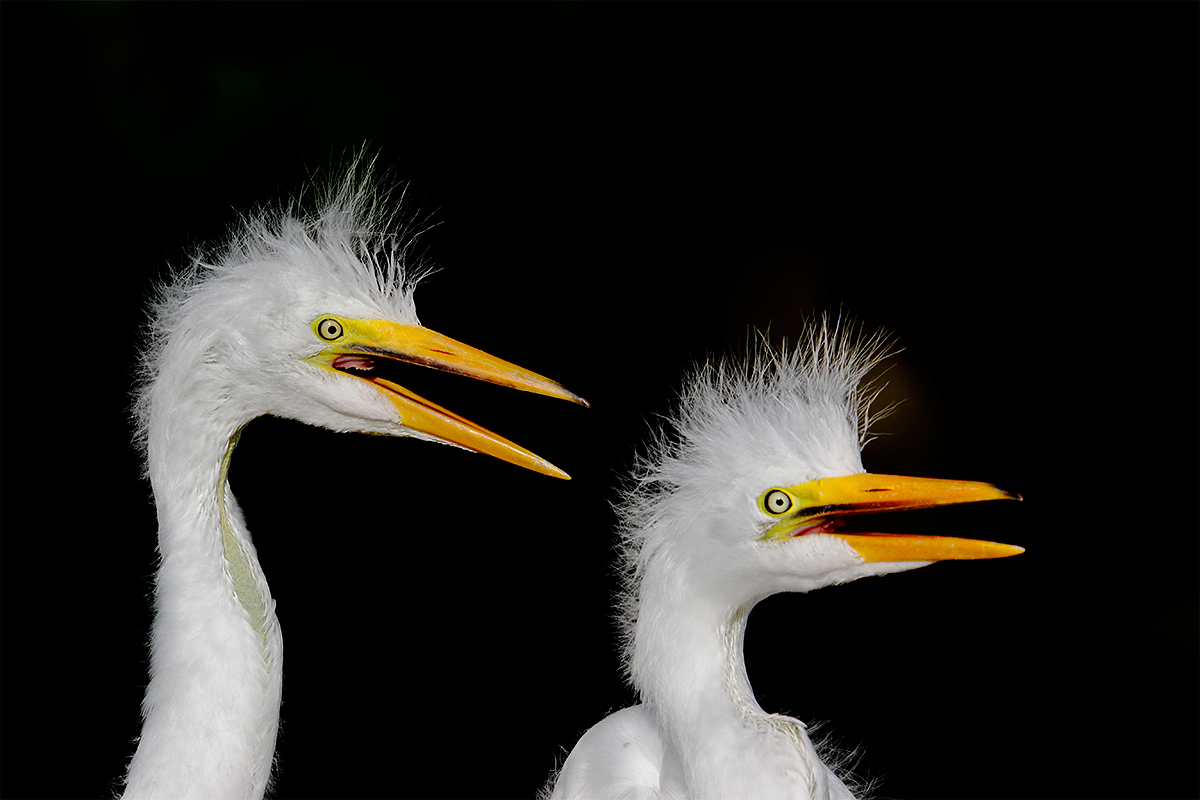
|
|
This image was created on the current IPT with the Canon EF 600mm f/4L IS II USM lens, the Canon Extender EF 2X III, and the amazing Canon EOS 7D Mark II. ISO 400. Evaluative metering -2/3 stop: 1/1000 sec. at f/11.
Center AF point (by necessity)/AI Servo Expand/Rear Focus AF as framed on the chick on the left, say a prayer, and re-compose. Click here to see the latest version of the Rear Focus Tutorial. Click on the image to see a larger version.
Great Egret chicks in the nest begging
|
Flash or No Flash?
In the “Extreme Focal Length/High Contrast Chicks” blog post here, I posted:
Image Question
Do you think that flash was used in the creation of this image? If yes, flash as main light or flash as fill? Why? If not, can you describe a situation that might have resulted in the black background?
I should have asked (more correctly): “Do you think that flash was used effectively in the creation of this image with it’s black background effect?” Read on.
No Flash, No Way!
Lots of folks left comments. About half thought that the image was created using flash-as-main-light techniques. About half thought that there was no flash used. Nearly all of those thought that the background was shaded while the chicks were in bright sun.
With a shutter speed of 1/1000 sec., it is necessary to have High Speed Synch set on the flash. The synch speed of the 7D II is 1/250 sec. When you are in High Speed Synch, the illumination provided by the flash (the guide number) drops as the shutter speed is increased. At very high shutter speeds like 1/1000 sec., the illumination from the flash is reduced greatly and thus the effective range of the flash is also reduced greatly. In addition, since the flash has to produce multiple rapid low power bursts when you are using High Speed Synch, the power of the flash is further reduced.
With an effective focal length of 1920mm, it is obvious that I was quite far from the nest–I would guess about 100 feet across the gator moat. With the flash power greatly reduced and the birds relatively far away, it would be impossible to light the chicks with the flash even if you are working with Manual Flash set to 1:1 (maximum flash power) with a Better Beamer.
Thus, no flash. Note: even fill flash would not have had any visible effect on the image in this bright sun situation. In extremely low light, the flash would have surely messed up the bird’s eyes….
The Actual Situation
Those who stated that the subjects were in the sun while the background was in deep shade were correct. I was, however, working right on sun angle; the relatively distant background behind the nest was shaded by trees that were near the nest but above it, thus shading the background well behind the nest.
There were a few lighter blotches in the background that I thought I would need to darken in Photoshop, but I tried simply moving the Shadow Slider to the left to -5. Bingo: solid black.
Image Question
For this image placing the tripod was a major factor; an inch or two either way made a big difference. Why was I so careful when choosing my perspective?
Natural Light Tips
#1: Point your shadow at (or within 15 degrees at most) the subject.
#2: For years I have been saying that subject in shade, background in sun, is one of my favorite situations. Now I can state that white or light-toned subjects in sun with the background in deep shade is another favorite.
Learning About Flash
The best way to learn about using your flash properly is to study the “Flash Simplified” section in The Art of Bird Photography II, the digital follow-up to the original classic soft cover The Art of Bird Photography. ABP II: 916 pages, 900+ images on CD only. The ABP II PDFs will synch to your i-Pad. The “Flash Simplified” section includes info on setting up for telephoto and super-telephoto photography, using a Better Beamer, using flash as fill, the principles of flash as main light, and using Manual flash as main light. Several multiple image series show the effect of varying both the ambient and flash exposures on the subject and the background.
Purchase ABP and ABP II together and save $10 here.
There will be lots more on flash here on the blog in the coming weeks.
ABP II Free Excerpts
Facebook
Be sure to like and follow BAA on Facebook by clicking on the logo link upper right. Tanks a stack!
Support the BAA Blog. Support the BAA Bulletins: Shop B&H here!
We want and need to keep providing you with the latest free information, photography and Photoshop lessons, and all manner of related information. Show your appreciation by making your purchases immediately after clicking on any of our B&H or Amazon Affiliate links in this blog post. Remember, B&H ain’t just photography!
…..
Amazon.com
Those who prefer to support BAA by shopping with Amazon may use this link:
Amazon Canada
Many kind folks from north of the border, eh, have e-mailed stating that they would love to help us out by using one of our affiliate links but that living in Canada and doing so presents numerous problems. Now, they can help us out by using our Amazon Canada affiliate link by starting their searches by clicking here. Many thanks to those who have written.
Typos
In all blog posts and Bulletins, feel free to e-mail or to leave a comment regarding any typos or errors. Just be right :).
May 10th, 2015
Happy Mother’s Day
Be sure to wish all the mom’s in your life a wonderful day today, especially the one who brought you into the world (if you are lucky enough to have her around).
Dear Mom,
Happy Mother’s Day. I love you muchly.
your son, arthur
May 9th, 2015 Stuff
I finally finished my San Diego article for Nature Photographer Magazine. I sent the text and the images with captions to Helen Longest Saccone, the editor and founder on Friday afternoon. Next I need to get my ad with a photo to her.
This blog post, the 121st in a row, took about 1 1/4 hours to prepare. It is scheduled to be published automatically at 5am on Saturday morning.
Used Photography Gear/New Listing
Canon EF 100-400mm f/4.5-5.6L IS USM
Michael Zajac is offering a used Canon EF 100-400mm f/4.5-5.6L IS USM lens excellent condition for $949.99. The sale includes the original box, the front and rear lenses caps, the original box, and free insured shipping to US addresses. You can call Michael at 732-979-6644 (eastern time zone) or shoot him an e-mail.
I owned and used this great lens for well more than a decade and created hundreds of published images with it. Denise Ippolito owned and loved hers for years. Best news? Michael takes a lot better care of his gear than I do….
Huge Price Reduction
Used EOS-1D Mark IV Digital Camera Body
Price reduced an additional $900 on 5/9/2015!
Marc Lombardi is offering a used EOS-1D Mark IV digital camera body in excellent condition with 57800 actuations for $1300. The body has one minor cosmetic scratch on top. The sale includes the charger and two batteries, a RRS plate, and insured ground shipping to US addresses only. Your camera will be shipped only after your check clears unless other arrangements are made.
Please contact Marc via e-mail or by phone at 610-585-3500 (Eastern time).
Two Mark IVs served as my workhorse bodies for more than three years. artie
You can see the complete Used Photography Gear For Sale listings here.


Canon’s Huge Megapixel Bodies
Many of you have read about the two new Canon 50+ megapixel bodies, the Canon EOS 5DS DSLR and the Canon EOS 5DS R DSLR. The two cameras look, sound, and pretty much are quite similar. I have withheld commenting until now because I did not have a good–heck, I did not have any–understanding of the single difference between the two bodies, that being the Low-Pass Filter Effect Cancellation.
If you missed the hugely popular “Canon’s Two New 50+ Megapixel Camera Bodies/You Must Read This Before You Buy,” you can click here to catch up and learn a ton to boot.
Please Remember to use our Affiliate Links 🙂
To show your appreciation for my continuing efforts here, we ask, as always, that you use our the B&H and Amazon affiliate links on the right side of the blog for all of your purchases. B&H is recommended for you major photography gear purchases, Amazon for your household, entertainment, and general purpose stuff. Please check the availability of all photographic accessories in the BIRDS AS ART Online Store, especially the Mongoose M3.6 tripod heads, Gitzo tripods, Wimberley heads and plates, LensCoats and accessories, and the like. We sell only what I have used, have tested, and can depend on. We will not sell you junk. We know what you need to make creating great images easy and fun. And we are always glad to answer your gear questions via e-mail. I just learned that my account was suspended during my absence; it should be up and running by Monday at the latest.
I would of course appreciate your using our B&H affiliate links for all of your major gear, video, and electronic purchases. For the photographic stuff mentioned in the paragraph above we, meaning BAA, would of course greatly appreciate your business. Here is a huge thank you to the many who have been using our links on a regular basis and visiting the BAA Online store as well.
|
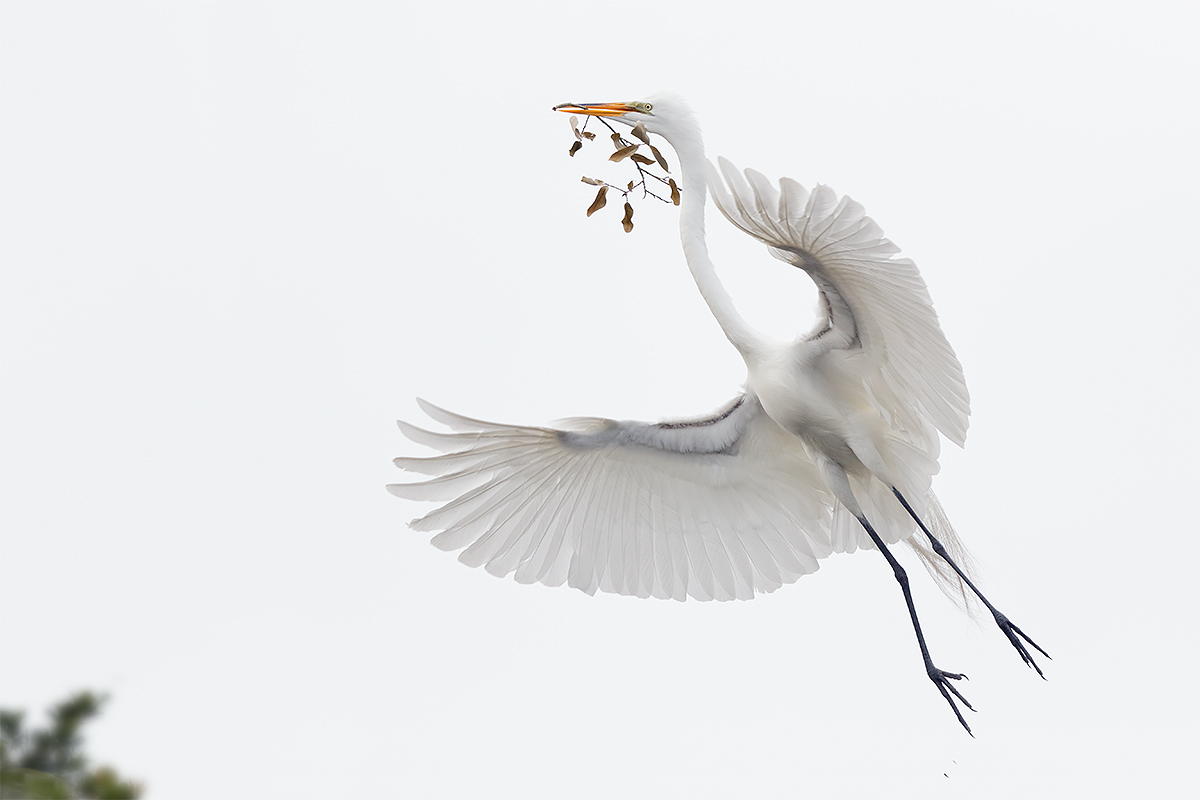
|
|
This image was created on May 5 on the recently concluded IPT with the hand held Canon EF 300mm f/2.8L IS II USM lens and the Canon EOS 7D Mark II. ISO 400. Evaluative metering +3 stops off the sky: 1/3200 sec. at f/2.8 in Manual mode. Cloudy WB.
Center AF point/AI Servo-Surround/Expand Button AF (on the bird’s neck) as originally framed was active at the moment of exposure as is always best for flight photography and is always best when hand holding. Click on the image to see a larger version.
Great Egret landing with sprig for nest
|
f/2.8 for Flight…
Working wide open when doing flight photography lets you go with a low ISO and achieve the fastest possible shutter speed while adding enough light in low light situations to come up with a perfect histogram. This image is un-cropped. Note that there was enough depth-of-field to cover the subject from wingtip to wingtip.
For complete coverage of this subject see the “An Important But Basic Bird Photography Principle: Use Wide Apertures in Low Light…” blog post here.
Exposure Question
I metered the light sky, added 3 full stops, and set that exposure (1/3200 sec. at f/2.8) manually. As framed, the meter would have indicated about +2 stops. Why?
Whaddya Think?
What is the single negative in the image above?
|
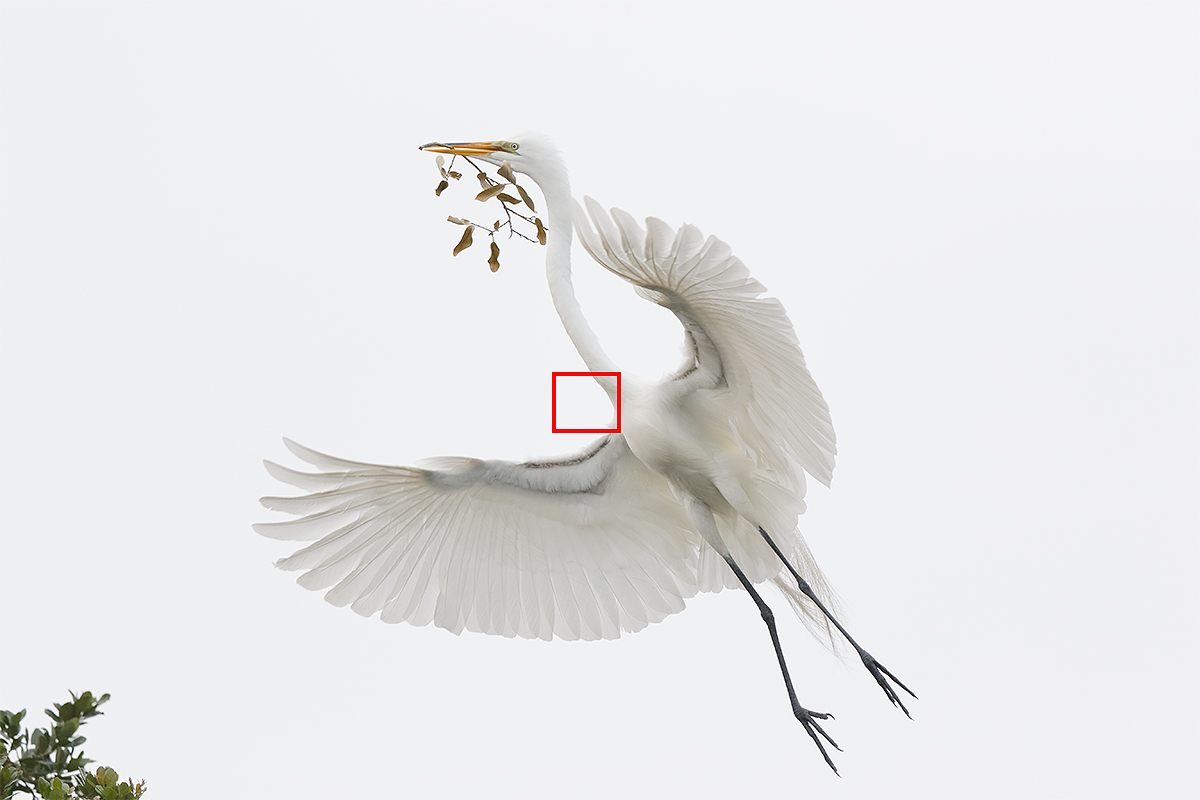
|
|
This JPEG represents the TIFF after conversion in DPP 4. I added the red square in Photoshop with the Pencil Tool. Tip: hold down the Shift key to keep your lines dead straight while creating the box.
|
The Image Optimization
After converting the image in DPP 4, I brought the image into Photoshop. First, I moved the bird up and back in the frame using techniques detailed in APTATS II. I selected the bird using the Quick Selection Tool and placed the selection on its own layer. Next I applied my NIK Color Efex Pro 50-50 recipe and reduced the opacity to 66%. Next I selected the bill, the lores, and the eye, again with the Quick Selection Tool and applied a Contrast Mask (Unsharp Mask at 15/65/0). Lastly I painted a Quick Mask of the leaves in the lower right and applied a 50 pixel Gaussian Blur to soften them up.
Digital Basics
Everything that I did to optimize today’s image is covered in detail in my Digital Basics File–written in my easy-to-follow, easy-to-understand style. Are you tired of making your images look worse in Photoshop? Digital Basics File is an instructional PDF that is sent via e-mail. It includes my complete digital workflow, dozens of great Photoshop tips, details on using all of my image clean-up tools, the use of Contrast Masks, several different ways of expanding and filling in canvas, all of my time-saving Keyboard Shortcuts, Quick Masking, Layer Masking, and NIK Color Efex Pro basics, Contrast Masks, Digital Eye Doctor techniques, using Gaussian Blurs, Tim Grey Dodge and Burn, a variety of ways to make selections, how to create time-saving actions, the Surface Blur (background noise reduction) settings, and tons more.
APTATS I & II
Learn the details of advanced Quick Masking techniques in APTATS I. Learn Advanced Layer Masking Techniques in APTATS II. Mention this blog post and apply a $5 discount to either with phone orders only. Buy both APTATS I and APTATS II and we will be glad to apply at $15 discount either with phone orders or here in the BAA Online Store. For phone orders, call Jim or Jennifer at 863-692-0906 weekdays.
|
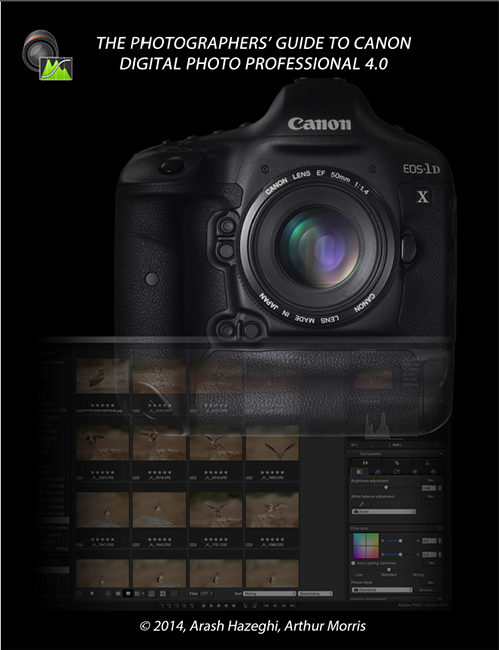
|
|
You can order your copy of “The Photographers’ Guide to Canon Digital Photo Professional 4.0” (aka the DPP 4 Raw Conversion eGuide) by Arash Hazeghi and Arthur Morris by clicking here.
|
The DPP 4 eGuide (PDF)
Learn how and why I and many other discerning photographers choose and use only DPP 4 to convert their Canon RAW files in the DPP 4 RAW Conversion Guide by Arash Hazeghi and yours truly. The latest version supports all of the newer Canon camera bodies and several older models including the EOS-7D and the EOS-1D Mark IV. A free update that will cover most of the newly added cameras will be sent as soon as I get it from Arash.
Facebook
Be sure to like and follow BAA on Facebook by clicking on the logo link upper right. Tanks a stack!
Support the BAA Blog. Support the BAA Bulletins: Shop B&H here!
We want and need to keep providing you with the latest free information, photography and Photoshop lessons, and all manner of related information. Show your appreciation by making your purchases immediately after clicking on any of our B&H or Amazon Affiliate links in this blog post. Remember, B&H ain’t just photography!
…..
Amazon.com
Those who prefer to support BAA by shopping with Amazon may use this link:
Amazon Canada
Many kind folks from north of the border, eh, have e-mailed stating that they would love to help us out by using one of our affiliate links but that living in Canada and doing so presents numerous problems. Now, they can help us out by using our Amazon Canada affiliate link by starting their searches by clicking here. Many thanks to those who have written.
Typos
In all blog posts and Bulletins, feel free to e-mail or to leave a comment regarding any typos or errors. Just be right :).
May 8th, 2015 Stuff
On Thursday morning the IPT group learned first hand that clouds were indeed way better than sun when photographing at a rookery…. While we concentrated on finding backlit and shaded subjects the vast majority of the 30 or so photographers were working 90 degrees to the bright sun…. Not good. The sun was somewhat of a blessing for me as we split at 10am due to the harsh light and I was on the road to Lake Wales and ILE by 10:30am. After a few errands I arrived home at 3:15 and enjoyed a well-deserved nap, one of the greatest human naps in the history of the planet.
This blog post, the 120th in a row, took about an hour to prepare. It is scheduled to be published automatically at 4am on Friday morning. I will be home with lots to do until I leave for the two Palouse IPTs on 27 May. That begins what will be six months of insane and wonderful travel. In other words, par for the course.
Used Photography Gear
Featured Listings
You can see the complete list of used gear here.
Canon EF 70-200mm f/2.8L IS II USM Lens
Multiple IPT veteran Carl Zanoni is offering a used Canon EF 70-200mm f/2.8L IS II USM lens in like new condition for the record low price of $1649.00. The sale includes front lens cover and rear lens cap, the ET-82 lens hood,the LZ 1324 Lens Bag, the tripod mount ring (collar), the original box, and insured shipping via UPS Ground to US addresses. Your item will not ship until your check clears unless other arrangements are made.
Please contact Carl by e-mail or by phone at 860 306 9651 (eastern time).
I have owned and used the 70-200 II since its release. It is an incredibly versatile lens. I use it (alone or with either the 1.4X III or the 2X III TCs) for both birds and for wildlife. It is a valuable tool at the gator rookeries. In addition, I use it for flower fields, flocks of birds in flight (especially geese at Bosque and skimmers at Nickerson Beach), for tree and scenic photography, and for pan blurs both hand held and on a tripod. And for tons more. As I said, “versatile.” Priced so low, this one should sell immediately.
Canon EF 180mm f/3.5L USM Macro Lens
Multiple IPT veteran Carl Zanoni is also offering a used Canon EF 180mm f/3.5 USM macro lens in like new condition for $1175. The sale includes the E-72 II 72mm (front) lens cap, the (rear) lens dust cap E, the ET-78 II lens hood, Tripod Mount Ring B (tripod collar), the LZ1324 lens case, the original box, and insured shipping via UPS Ground to US addresses. Your item will not ship until your check clears unless other arrangements are made.
Please contact Carl by e-mail or by phone at 860 306 9651 (eastern time).
I have owned and used the 180 macro for more than 10 years. It is the primo telephoto macro lens. It is sharp with and without a 1.4X TC. It offers a narrow field of view that goes a long way to eliminating back distracting background element. It is great for flowers and all sorts of bugs, butterflies, and dragonflies as well as for frogs and toads.
Canon EF 24-70 f2.8L II USM Lens
Dave Bourgaize is offering a used Canon EF 24-70 f2.8L II USM lens in excellent condition for $1499.00. The sale includes front lens cover and rear lens cap, EW-88C lens hood, original Canon bag, and insured shipping via UPS Ground to US addresses. Your item will not ship until your check clears unless other arrangements are made. Please contact Dave by e-mail or by phone at (310) 748-9547 (pacific time zone).
I own and use the 24-70II. It is much sharper edge to edge than the lighter, more versatile Canon EF 24-105mm f/4L IS USM lens. I consider the 24-70II a must for serious landscape photographers. As it sells new for $1899 Dave’s price is lower than any I have seen for this lens in excellent condition. It should sell immediately.
|
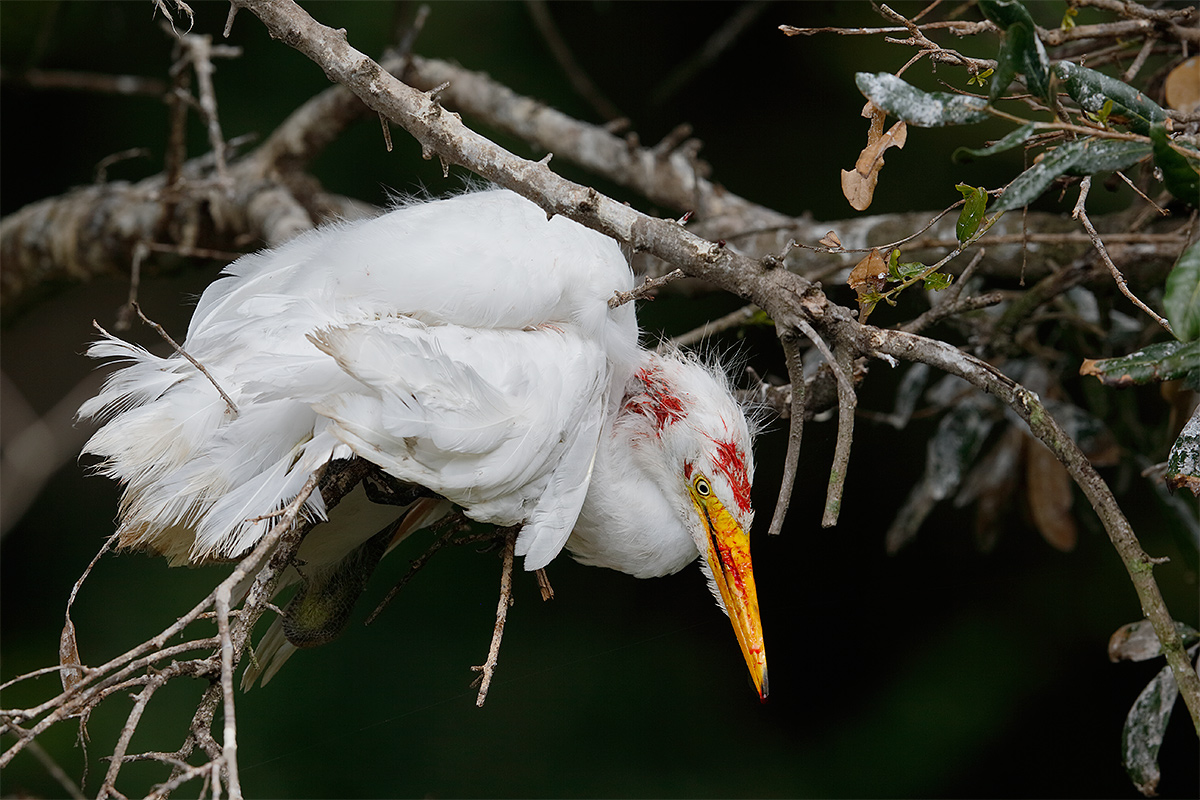
|
|
This image was created on Wednesday of the recently concluded IPT with the tripod-mounted Canon EF 600mm f/4L IS II USM lens, the Canon Extender EF 1.4X III, and the Canon EOS-1D X . ISO 400: 1/250 sec. at f/9 confirmed by histogram check.
Center AF point/AI Servo Expand/Rear Focus AF just behind the bird’s head was active at the moment of exposure. Click here to see the latest version of the Rear Focus Tutorial. Click on the image to see a larger version.
Great Egret/large chick after repeated beatings by adult
|
The Mystery
On Wednesday morning we noticed a large Great Egret chick in a nest battling with an adult. More accurately the adult was trying to kill the nearly fledged chick by stabbing it repeatedly with it powerful bill. The youngster was trying to defend itself by stabbing back but was no match at all for the powerful parent bird. Several of us tried to photograph the beating but with the youngster well obscured by vegetation we were not successful; I wound up deleting every image.
After photographing a drop dead gorgeous breeding plumage Snowy Egret in full breeding plumage for about an hour we returned to the scene of the crime to learn that the adult had beaten the large chick nearly to death and that the chick had been evicted from the nest. It was tangled rather hopelessly in the branches of a small tree, its head bloodied. At this point I created a series of images to depict the bird’s plight.
Referring to the adult, most folks used the term “murderess.”
Several asked me, “Why does stuff like that happen with a parent bird trying to kill its own chick?” I replied, “That happens only rarely. It is very possible that the large chick had been orphaned and climbed into a nest other than its own in an effort to get fed.” In fact, I had seen that exact behavior at a nest in Everglades National Park when an orphaned young Anhinga climbed into a nest with the three chicks that belonged there. The other chicks were fine with the intruder but the mother bird, to say the least, was not. It struck the interloper repeatedly with its saber-like bill and drove it into the water where it was instantly grabbed by a gator.
The next morning the mystery was unraveled when two tiny white heads peeked over the rim of the nest. The large chick had indeed been orphaned. The murderess had simply been protecting its newly hatched chicks…. Folks started referring to her as “protector.”
The large chick, perched in the same tree, was looking a lot better on Thursday morning but without getting fed it is pretty much doomed to become gator food at some point.
|

|
|
In 2015, we are offering a 3-DAY IPT before Thanksgiving and a 4-DAY IPT after the holiday. You can attend either and spend Thanksgiving Day with your family. Sign up for both and we will be glad to apply a $100 discount to your balance. We know that there are lots of less costly workshops being offered these days. Many of them are downright cheap. Please remember that you get exactly what you pay for. With us you will have two full time pros there for you every minute we are in the field. Together they have more than 28 seasons of experience at the refuge. If you want the finest in photographic instruction and want to be assured of being in the right spot at exactly the right time every day, do join us.
|
Bosque del Apache 2015 BIRDS AS ART/A Creative Adventure Instructional Photo-Tour (IPT). 3-FULL DAY IPT: NOV 22-24, 2015. $1149. Two great leaders: Denise Ippolito and Arthur Morris. Meet and greet and introductory slide program after dinner on your own at 7:00pm on SAT NOV 21.
Tens of thousands of Snow Geese, 10,000 Sandhill Cranes, ducks, amazing sunrises, sunsets, and blast-offs. Live, eat, and breathe photography with two of the world’s premier photographic educators at one of their very favorite photography locations on the planet. Top-notch in-the-field and Photoshop instruction. This will make 21 consecutive Novembers at Bosque for artie. This will be denise’s 7th workshop at the refuge. Nobody knows the place better than artie does. Join us to learn to think like a pro, to recognize situations and to anticipate them based on the weather, especially the sky conditions, the light, and the wind direction. Every time we make a move we will let you know why. When you head home being able to apply what you’ve learned on your home turf will prove to be invaluable.
This workshop includes 3 morning and 3 afternoon photography sessions, an inspirational introductory slide program after dinner on your own on Saturday, 11/21, all lunches, and after-lunch digital workflow, Photoshop, and image critiquing sessions.
There is never a strict itinerary on a Bosque IPT as each day is tailored to the local conditions at the time and to the weather. We are totally flexible in order to maximize both the photographic and learning opportunities. We are up early each day leaving the hotel by 5:30 am to be in position for sunrise. We usually photograph until about 10:30am. Then it is back to Socorro for lunch and then a classroom session with the group most days. We head back to the refuge at about 3:30pm each day and photograph until sunset. We will be photographing lots of Snow Geese and lots of Sandhill Cranes with the emphasis on expanding both your technical skills and your creativity.
A $449 non-refundable deposit is required to hold your slot for this IPT. Your balance, payable only by check, will be due on 7/25/2015. If you cancel and the trip fills, we will be glad to apply a credit applicable to a future IPT for the full amount less a $100 processing fee. If we do not receive your check for the balance on or before the due date we will try to fill your spot from the waiting list. Whether or not your spot is filled, you will lose your deposit. If not, you can secure your spot by paying your balance.
Please print, complete, and sign the form that is linked to here and shoot it to us along with your deposit check (made out to “Arthur Morris.”) You can also leave your deposit with a credit card by calling the office at 863-692-0906. If you register by phone, please print, complete and sign the form as noted above and either mail it to us or e-mail the scan. If you have any questions, please feel free to contact me via e-mail.
|

|
|
In 2015, we are offering a 3-DAY IPT before Thanksgiving and a 4-DAY IPT after the holiday. You can attend either and spend Thanksgiving Day with your family. Sign up for both and we will be glad to apply a $100 discount to your balance.
We know that there are lots of less costly workshops being offered these days. Please remember that you get exactly what you pay for. If you want the finest in photographic instruction and want to be assured of being in the right spot at exactly the right time, do join us.
|
Bosque del Apache 2015 BIRDS AS ART/A Creative Adventure Instructional Photo-Tour (IPT). 4-DAY IPT: (three full and two 1/2 DAYS) NOV 28-DEC 2, 2015. $1499. Two great leaders: Denise Ippolito and Arthur Morris. Meet and greet at 3pm on SAT NOV 28 followed by an afternoon photo session at the crane pools and the introductory slide program after dinner on your own.
Tens of thousands of Snow Geese, 10,000 Sandhill Cranes, ducks, amazing sunrises, sunsets, and blast-offs. Live, eat, and breathe photography with two of the world’s premier photographic educators at one of their very favorite photography locations on the planet. Top-notch in-the-field and Photoshop instruction. This will make 21 consecutive Novembers at Bosque for artie. This will be denise’s 7th workshop at the refuge. Nobody knows the place better than artie does. Join us to learn to think like a pro, to recognize situations and to anticipate them based on the weather, especially the sky conditions, the light, and the wind direction. Every time we make a move we will let you know why. When you head home being able to apply what you’ve learned on your home turf will prove to be invaluable.
This workshop includes 4 afternoon (11/28through 12/1), 4 morning (11/29 to 12/2) photography sessions, an inspirational introductory slide program after dinner on your own on Saturday, 11/28, all lunches, and after-lunch digital workflow, Photoshop, and image critiquing sessions.
There is never a strict itinerary on a Bosque IPT as each day is tailored to the local conditions at the time and to the weather. We are totally flexible in order to maximize both the photographic and learning opportunities. We are up early each day leaving the hotel by 5:30 am to be in position for sunrise. We usually photograph until about 10:30am. Then it is back to Socorro for lunch and then a classroom session with the group most days. We head back to the refuge at about 3:30pm each day and photograph until sunset. We will be photographing lots of Snow Geese and lots of Sandhill Cranes with the emphasis on expanding both your technical skills and your creativity.
A $599 non-refundable deposit is required to hold your slot for this IPT. Your balance, payable only by check, will be due on 7/25/2015. If you cancel and the trip fills, we will be glad to apply a credit applicable to a future IPT for the full amount less a $100 processing fee. If we do not receive your check for the balance on or before the due date we will try to fill your spot from the waiting list. Whether or not your spot is filled, you will lose your deposit. If not, you can secure your spot by paying your balance.
Please print, complete, and sign the form that is linked to here and shoot it to us along with your deposit check (made out to “Arthur Morris.”) You can also leave your deposit with a credit card by calling the office at 863-692-0906. If you register by phone, please print, complete and sign the form as noted above and either mail it to us or e-mail the scan. If you have any questions, please feel free to contact me via e-mail.
Facebook
Be sure to like and follow BAA on Facebook by clicking on the logo link upper right. Tanks a stack!
Support the BAA Blog. Support the BAA Bulletins: Shop B&H here!
We want and need to keep providing you with the latest free information, photography and Photoshop lessons, and all manner of related information. Show your appreciation by making your purchases immediately after clicking on any of our B&H or Amazon Affiliate links in this blog post. Remember, B&H ain’t just photography!
…..
Amazon.com
Those who prefer to support BAA by shopping with Amazon may use this link:
Amazon Canada
Many kind folks from north of the border, eh, have e-mailed stating that they would love to help us out by using one of our affiliate links but that living in Canada and doing so presents numerous problems. Now, they can help us out by using our Amazon Canada affiliate link by starting their searches by clicking here. Many thanks to those who have written.
Typos
In all blog posts and Bulletins, feel free to e-mail or to leave a comment regarding any typos or errors. Just be right :).
May 7th, 2015 Stuff
The second full day of the current IPT was a great one. The clouds and heavy overcast allowed us to photograph until 11:30am. everyone loved the lunch at my favorite local eatery, Gypsy Cab Company. Our afternoon session began with full sun but almost as soon as we arrived the cloud cover did the same. We spent lots of time working with flash. First-timer Jim Robbelard of Naples, FL was thrilled to learn to create high key flash-as-main-light images of Great Egrets that looked as if they were created in a studio.
This blog post, the 119th in a row, took about an hour to prepare. It is scheduled to be published automatically at 1am on Thursday morning. I head home after tomorrow morning’s session.


Canon’s Huge Megapixel Bodies
Many of you have read about the two new Canon 50+ megapixel bodies, the Canon EOS 5DS DSLR and the Canon EOS 5DS R DSLR. The two cameras look, sound, and pretty much are quite similar. I have withheld commenting until now because I did not have a good–heck, I did not have any–understanding of the single difference between the two bodies, that being the Low-Pass Filter Effect Cancellation.
If you missed the hugely popular “Canon’s Two New 50+ Megapixel Camera Bodies/You Must Read This Before You Buy,” you can click here to catch up and learn a ton to boot.
Please Remember to use our Affiliate Links 🙂
To show your appreciation for my continuing efforts here, we ask, as always, that you use our the B&H and Amazon affiliate links on the right side of the blog for all of your purchases. B&H is recommended for you major photography gear purchases, Amazon for your household, entertainment, and general purpose stuff. Please check the availability of all photographic accessories in the BIRDS AS ART Online Store, especially the Mongoose M3.6 tripod heads, Gitzo tripods, Wimberley heads and plates, LensCoats and accessories, and the like. We sell only what I have used, have tested, and can depend on. We will not sell you junk. We know what you need to make creating great images easy and fun. And we are always glad to answer your gear questions via e-mail. I just learned that my account was suspended during my absence; it should be up and running by Monday at the latest.
I would of course appreciate your using our B&H affiliate links for all of your major gear, video, and electronic purchases. For the photographic stuff mentioned in the paragraph above we, meaning BAA, would of course greatly appreciate your business. Here is a huge thank you to the many who have been using our links on a regular basis and visiting the BAA Online store as well.
|

|
|
This image was created on the current IPT with the Canon EF 600mm f/4L IS II USM lens, the Canon Extender EF 2X III, and the amazing Canon EOS 7D Mark II. ISO 400. Evaluative metering -2/3 stop: 1/1000 sec. at f/11.
Center AF point (by necessity)/AI Servo Expand/Rear Focus AF as framed on the chick on the left, say a prayer, and re-compose. Click here to see the latest version of the Rear Focus Tutorial. Click on the image to see a larger version.
Great Egret chicks in the nest begging
|
Extreme Focal Length/High Contrast Great Egret Chicks
600 II X 2X III X 1.6 crop factor of the 7D II = 1920mm or approximately 38.2 X magnification…. Best advice even at relatively high shutter speeds: be sure to hold your rig still. Note that the exposure is the equivalent of the standard ISO 400 bright WHITEs in full sun exposure of 1/2000 sec. at f/8 (for folks who are using DPP 4 with Highlight Tone Priority set). If not the latter, try 1/2500 sec. at f/8. Remember that you are always responsible for checking the histogram to see that you have at least some data in the highlight (right-most) box of the histogram and in the same vein that you are always responsible for checking for blinkies.
Image Question
Do you think that flash was used in the creation of this image? If yes, flash as main light or flash as fill? Why? If not, can you describe a situation that might have resulted in the black background?
|
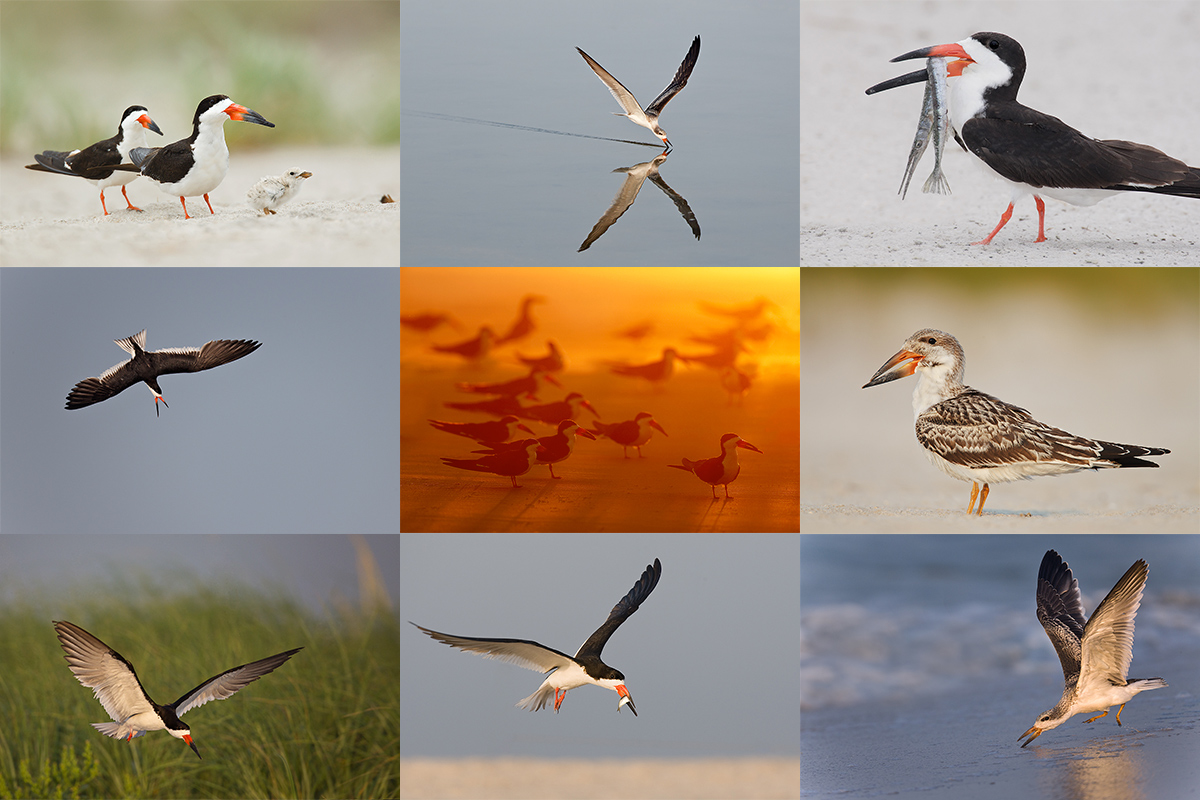
|
|
The strange thing is that when I lived in New York, I never knew about this amazing and consistently productive location.
|
Nickerson Beach/JBWR (possibly…)/Black Skimmer/Oystercatcher/migrant shorebird IPT: August 13-16, 2015. 3 1/2 DAYS: $1399.
Meet and greet on the evening of WED August 12. Limit 10/Openings 5.
Most of our seven photo sessions will be spent at Nickerson beach photographing the nesting Black Skimmers. In flight, sometimes battling. Carrying fish. Chicks of varying sizes from a very few just-hatched to lots of fledglings. It is likely that we will get to see some Great Black-backed Gulls preying on the juvenile skimmers. They swallow them whole. There will be lots of gulls to photograph as well as some Common Terns. Locally breeding shorebird species include American Oystercatcher–pretty much guaranteed, Willet, which is likely, and Piping Plover, which is probable but we need to get lucky with those to get close….
Save a space by calling Jim or Jen at the office and arranging to leave your deposit of $499. I hope to see you there.
JBWR?
If local conditions are ideal we may visit Jamaica Bay Wildlife Refuge to photograph southbound migrant shorebirds on one or possibly two mornings. Even if we do not visit JBWR we should get some good chances with the migrant shorebirds at the beach, especially Sanderling and Semipalmated Plover. Red Knot and others are possible.
|
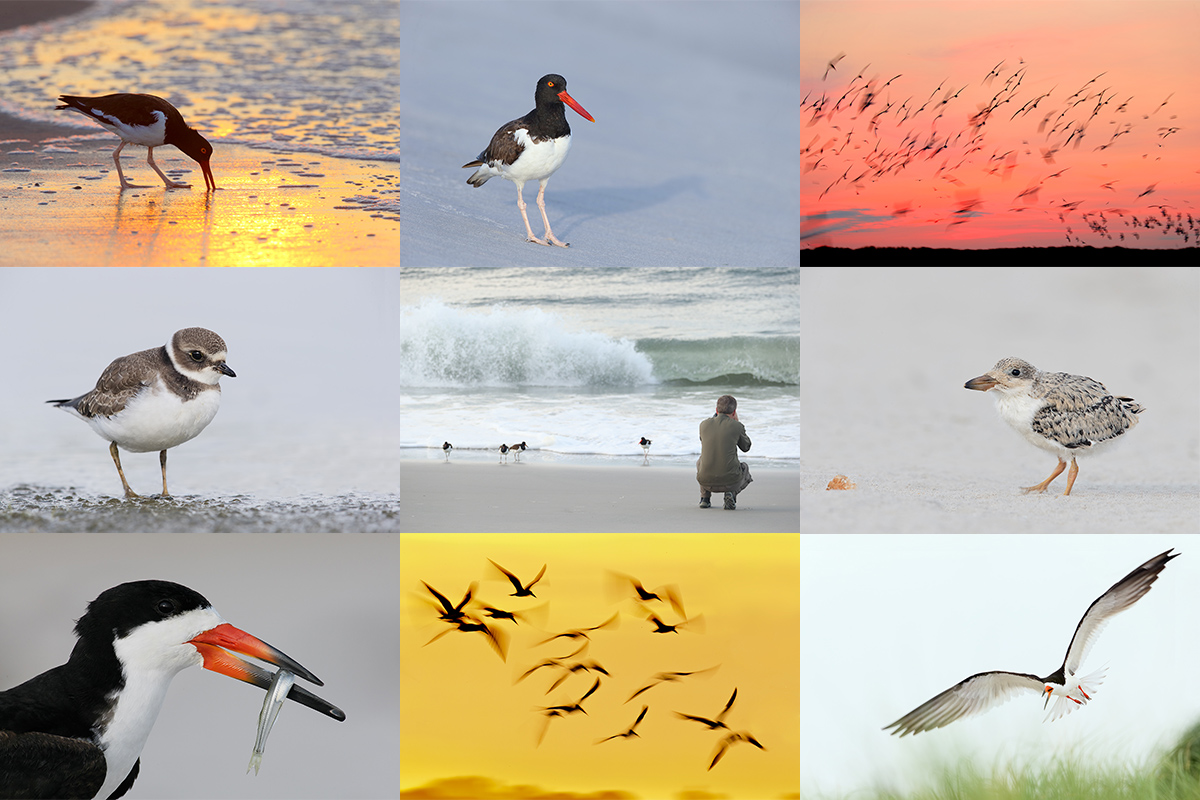
|
|
As you can see, the oystercatchers are quite tame at Nickerson. And we will get you up early and we will stay out late.
|
Jamaica Bay Wildlife Refuge In-the-field Instructional Photo Workshop/Scouting Session. August 12, 2015. Morning only: $250. Cheap!
The tide will be pretty good at the East Pond…. If I learn that conditions there are un-photographable we will do Nickerson Beach as a back-up. This will work either as an add-on for out of town folks coming for the IPT above or as a stand alone session. Either way, you will, as always, learn a ton. And we might even get some good images.
Facebook
Be sure to like and follow BAA on Facebook by clicking on the logo link upper right. Tanks a stack!
Support the BAA Blog. Support the BAA Bulletins: Shop B&H here!
We want and need to keep providing you with the latest free information, photography and Photoshop lessons, and all manner of related information. Show your appreciation by making your purchases immediately after clicking on any of our B&H or Amazon Affiliate links in this blog post. Remember, B&H ain’t just photography!
…..
Amazon.com
Those who prefer to support BAA by shopping with Amazon may use this link:
Amazon Canada
Many kind folks from north of the border, eh, have e-mailed stating that they would love to help us out by using one of our affiliate links but that living in Canada and doing so presents numerous problems. Now, they can help us out by using our Amazon Canada affiliate link by starting their searches by clicking here. Many thanks to those who have written.
Typos
In all blog posts and Bulletins, feel free to e-mail or to leave a comment regarding any typos or errors. Just be right :).
May 6th, 2015 Stuff
We enjoyed a cloudy, drizzly morning on the first full day of the current IPT. With occasional deluges. All in all it was a great but wet morning and I got to use my flash quite a bit. Flash images and stories coming soon.
This blog post, the 118th in a row, took about an hour to prepare. It is scheduled to be published automatically at 2am on Wednesday morning.
|
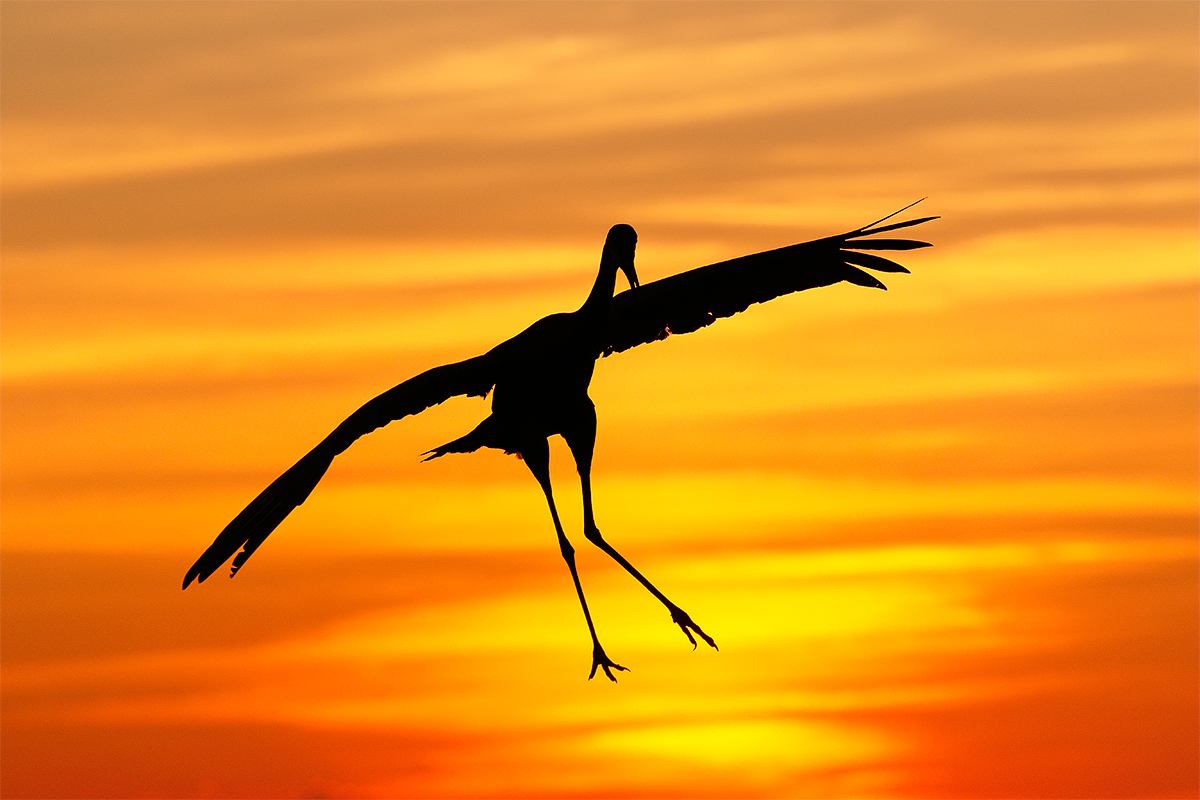
|
|
This image was created at Indian Lake Estates late on Sunday with the hand held Canon EF 100-400mm f/4.5-5.6L IS II USM lens (at 227mm) and the amazing Canon EOS 7D Mark II. ISO 400. Evaluative metering -1 stop: 1/2000 sec. at f/5.6 in Av mode. K8000.
Center AF point AI Servo/Surround/Shutter Button AF as framed was active at the moment of exposure (as is always best when hand holding and for flight photography). The AF system selected a single AF point two AF points above and one to the left of the center AF point. See the DPP 4 screen capture below to see how Zone AF performed.
Sandhill Crane turning to land
|
Never Hesitate
I was creating more head and head and shoulders crane silhouettes down by the lake on Sunday evening past when I noticed a crane flying right at me and right into the rather significant color. Rather than thinking of changing the exposure I finally learned the lesson I have been teaching for decades: shoot now, ask questions later. I had thought that -1 would be less than ideal but it turned out be prefect as the RED RGB numbers were in the high 240s. If I had taken even a half second to try to fix the exposure I would have missed the opportunity.
Exposure Question
Why do you think I was at -1 stop EC in the first place?
Image Critiquing Questions
What are the positives? What are the negatives? How do you feel about this image overall?
|

|
|
In 2015, we are offering a 3-DAY IPT before Thanksgiving and a 4-DAY IPT after the holiday. You can attend either and spend Thanksgiving Day with your family. Sign up for both and we will be glad to apply a $100 discount to your balance. We know that there are lots of less costly workshops being offered these days. Many of them are downright cheap. Please remember that you get exactly what you pay for. With us you will have two full time pros there for you every minute we are in the field. Together they have more than 28 seasons of experience at the refuge. If you want the finest in photographic instruction and want to be assured of being in the right spot at exactly the right time every day, do join us.
|
Bosque del Apache 2015 BIRDS AS ART/A Creative Adventure Instructional Photo-Tour (IPT). 3-FULL DAY IPT: NOV 22-24, 2015. $1149. Two great leaders: Denise Ippolito and Arthur Morris. Meet and greet and introductory slide program after dinner on your own at 7:00pm on SAT NOV 21.
Tens of thousands of Snow Geese, 10,000 Sandhill Cranes, ducks, amazing sunrises, sunsets, and blast-offs. Live, eat, and breathe photography with two of the world’s premier photographic educators at one of their very favorite photography locations on the planet. Top-notch in-the-field and Photoshop instruction. This will make 21 consecutive Novembers at Bosque for artie. This will be denise’s 7th workshop at the refuge. Nobody knows the place better than artie does. Join us to learn to think like a pro, to recognize situations and to anticipate them based on the weather, especially the sky conditions, the light, and the wind direction. Every time we make a move we will let you know why. When you head home being able to apply what you’ve learned on your home turf will prove to be invaluable.
This workshop includes 3 morning and 3 afternoon photography sessions, an inspirational introductory slide program after dinner on your own on Saturday, 11/21, all lunches, and after-lunch digital workflow, Photoshop, and image critiquing sessions.
There is never a strict itinerary on a Bosque IPT as each day is tailored to the local conditions at the time and to the weather. We are totally flexible in order to maximize both the photographic and learning opportunities. We are up early each day leaving the hotel by 5:30 am to be in position for sunrise. We usually photograph until about 10:30am. Then it is back to Socorro for lunch and then a classroom session with the group most days. We head back to the refuge at about 3:30pm each day and photograph until sunset. We will be photographing lots of Snow Geese and lots of Sandhill Cranes with the emphasis on expanding both your technical skills and your creativity.
A $449 non-refundable deposit is required to hold your slot for this IPT. Your balance, payable only by check, will be due on 7/25/2015. If you cancel and the trip fills, we will be glad to apply a credit applicable to a future IPT for the full amount less a $100 processing fee. If we do not receive your check for the balance on or before the due date we will try to fill your spot from the waiting list. Whether or not your spot is filled, you will lose your deposit. If not, you can secure your spot by paying your balance.
Please print, complete, and sign the form that is linked to here and shoot it to us along with your deposit check (made out to “Arthur Morris.”) You can also leave your deposit with a credit card by calling the office at 863-692-0906. If you register by phone, please print, complete and sign the form as noted above and either mail it to us or e-mail the scan. If you have any questions, please feel free to contact me via e-mail.
|

|
|
In 2015, we are offering a 3-DAY IPT before Thanksgiving and a 4-DAY IPT after the holiday. You can attend either and spend Thanksgiving Day with your family. Sign up for both and we will be glad to apply a $100 discount to your balance.
We know that there are lots of less costly workshops being offered these days. Please remember that you get exactly what you pay for. If you want the finest in photographic instruction and want to be assured of being in the right spot at exactly the right time, do join us.
|
Bosque del Apache 2015 BIRDS AS ART/A Creative Adventure Instructional Photo-Tour (IPT). 4-DAY IPT: (three full and two 1/2 DAYS) NOV 28-DEC 2, 2015. $1499. Two great leaders: Denise Ippolito and Arthur Morris. Meet and greet at 3pm on SAT NOV 28 followed by an afternoon photo session at the crane pools and the introductory slide program after dinner on your own.
Tens of thousands of Snow Geese, 10,000 Sandhill Cranes, ducks, amazing sunrises, sunsets, and blast-offs. Live, eat, and breathe photography with two of the world’s premier photographic educators at one of their very favorite photography locations on the planet. Top-notch in-the-field and Photoshop instruction. This will make 21 consecutive Novembers at Bosque for artie. This will be denise’s 7th workshop at the refuge. Nobody knows the place better than artie does. Join us to learn to think like a pro, to recognize situations and to anticipate them based on the weather, especially the sky conditions, the light, and the wind direction. Every time we make a move we will let you know why. When you head home being able to apply what you’ve learned on your home turf will prove to be invaluable.
This workshop includes 4 afternoon (11/28through 12/1), 4 morning (11/29 to 12/2) photography sessions, an inspirational introductory slide program after dinner on your own on Saturday, 11/28, all lunches, and after-lunch digital workflow, Photoshop, and image critiquing sessions.
There is never a strict itinerary on a Bosque IPT as each day is tailored to the local conditions at the time and to the weather. We are totally flexible in order to maximize both the photographic and learning opportunities. We are up early each day leaving the hotel by 5:30 am to be in position for sunrise. We usually photograph until about 10:30am. Then it is back to Socorro for lunch and then a classroom session with the group most days. We head back to the refuge at about 3:30pm each day and photograph until sunset. We will be photographing lots of Snow Geese and lots of Sandhill Cranes with the emphasis on expanding both your technical skills and your creativity.
A $599 non-refundable deposit is required to hold your slot for this IPT. Your balance, payable only by check, will be due on 7/25/2015. If you cancel and the trip fills, we will be glad to apply a credit applicable to a future IPT for the full amount less a $100 processing fee. If we do not receive your check for the balance on or before the due date we will try to fill your spot from the waiting list. Whether or not your spot is filled, you will lose your deposit. If not, you can secure your spot by paying your balance.
Please print, complete, and sign the form that is linked to here and shoot it to us along with your deposit check (made out to “Arthur Morris.”) You can also leave your deposit with a credit card by calling the office at 863-692-0906. If you register by phone, please print, complete and sign the form as noted above and either mail it to us or e-mail the scan. If you have any questions, please feel free to contact me via e-mail.
Facebook
Be sure to like and follow BAA on Facebook by clicking on the logo link upper right. Tanks a stack!
Support the BAA Blog. Support the BAA Bulletins: Shop B&H here!
We want and need to keep providing you with the latest free information, photography and Photoshop lessons, and all manner of related information. Show your appreciation by making your purchases immediately after clicking on any of our B&H or Amazon Affiliate links in this blog post. Remember, B&H ain’t just photography!
…..
Amazon.com
Those who prefer to support BAA by shopping with Amazon may use this link:
Amazon Canada
Many kind folks from north of the border, eh, have e-mailed stating that they would love to help us out by using one of our affiliate links but that living in Canada and doing so presents numerous problems. Now, they can help us out by using our Amazon Canada affiliate link by starting their searches by clicking here. Many thanks to those who have written.
Typos
In all blog posts and Bulletins, feel free to e-mail or to leave a comment regarding any typos or errors. Just be right :).
May 5th, 2015 Stuff
Monday was packing and travel day. I left before lunch and made it to the motel in St. Augustine just after 3pm. The 4 hour drive went by very quickly. I met my small group for a brief orientation and then headed to the Alligator Farm where conditions are looking quite excellent.
This blog post, the 117th in a row, took about 1 1/2 hours to prepare. It is scheduled to be published automatically at 1am on Tuesday morning. Tomorrow is the first full day of the IPT.
|
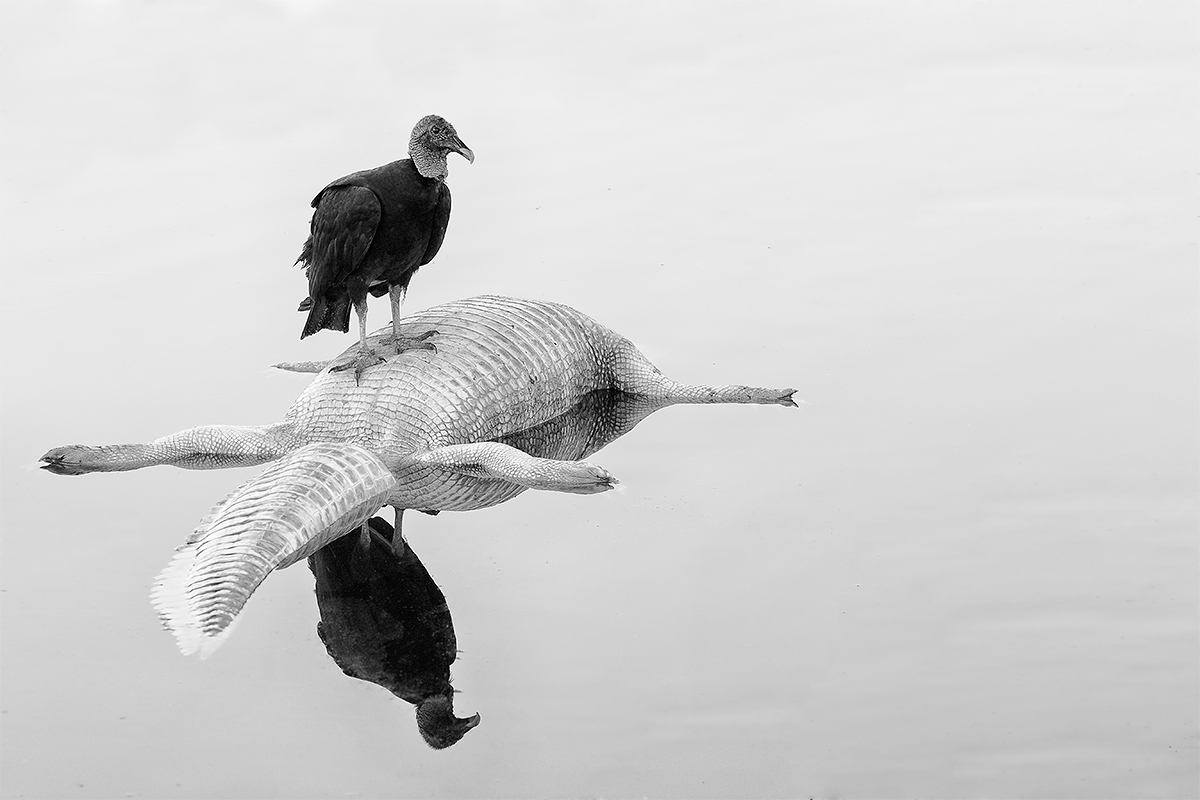
|
|
This image was created at Indian Lake Estates on Sunday morning with the hand held Canon EF 100-400mm f/4.5-5.6L IS II USM lens (at 124mm) and the amazing Canon EOS 7D Mark II. ISO 400. Evaluative metering +1 1/3 stops: 1/400 sec. at f/5.6 was still a significant underexposure of at least 1/2 stop, that despite blinkies on the water at 1/320 sec at f/5.6…. AWB. SHADE would have been a lot better.
One AF point above and two to the left of the center AF point/AI Servo Expand/Shutter Button AF as framed was active at the moment of exposure (as is always best when hand holding). The active AF point was on the vulture’s right foot conveniently on the same plane as the eye.
Black Vulture on rotting American Alligator carcass/NIK Silver Efex Pro High Structure Smooth B&W
|
I had been seeing a big group of Black Vultures every day in the same spot by the dead end corner of a canal. I drove up slowly to find out what the attraction was. I smelled it before I saw it, the bloated, rotting carcass of about a six foot gator. At first I tried working from the car but that did not work out well. When I got out, most of the vultures flew the coop. But the one on the gator was very much at peace with me and I was able to maneuver for the best backgrounds as long as I moved slowly. From the moment I started working the scene I knew that there was a really good black and white image there for the taking.
The funny thing is that when this or that vulture jumped onto the gator to join my friend the floating carcass would change position. I could not have placed the gator in a better spot myself….
After converting the image in DPP 4 at K 8200, I brought it into Photoshop and did some extensive cleanup of the surface of the water. Then my NIK 50-50 recipe at about 60% opacity. I saved a color version (below) and then went to NIK Silver Efex Pro and tried all of my favorites. High Structure Smooth was the winner by miles.
|
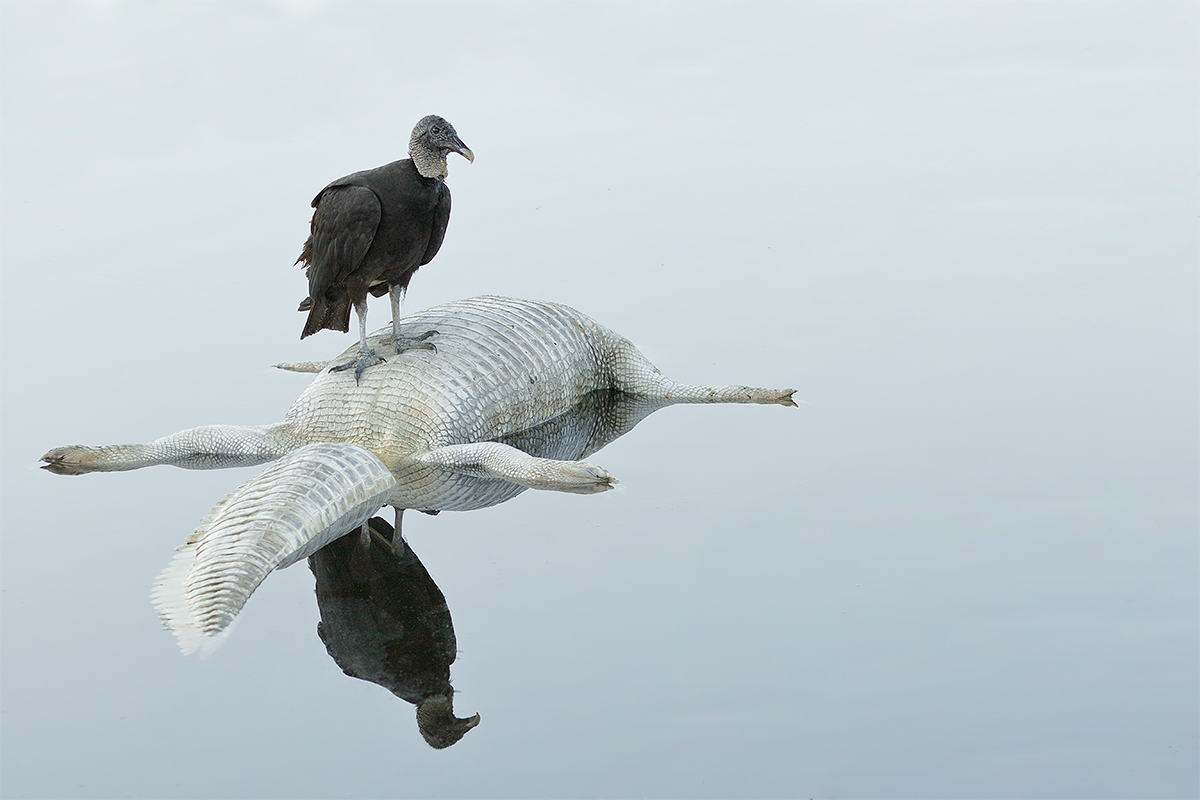
|
|
This image was created at Indian Lake Estates on Sunday morning with the hand held Canon EF 100-400mm f/4.5-5.6L IS II USM lens (at 124mm) and the amazing Canon EOS 7D Mark II. ISO 400. Evaluative metering +1 1/3 stops: 1/400 sec. at f/5.6 was still a significant underexposure of at least 1/2 stop, that despite blinkies on the water at 1/320 sec at f/5.6…. AWB should have been SHADE.
One AF point above and two to the left of the center AF point/AI Servo Expand/Shutter Button AF as framed was active at the moment of exposure (as is always best when hand holding). The active AF point was on the vulture’s right foot conveniently on the same plane as the eye.
Black Vulture on rotting American Alligator carcass
|
VULTURES AS ART?
Which version do you like best, color or B&W? Please let us know why.
Image Question
Do you see a reason to start from scratch and re-convert this image?
|

|
|
The strange thing is that when I lived in New York, I never knew about this amazing and consistently productive location.
|
Nickerson Beach/JBWR (possibly…)/Black Skimmer/Oystercatcher/migrant shorebird IPT: August 13-16, 2015. 3 1/2 DAYS: $1399.
Meet and greet on the evening of WED August 12. Limit 10/Openings 5.
Most of our seven photo sessions will be spent at Nickerson beach photographing the nesting Black Skimmers. In flight, sometimes battling. Carrying fish. Chicks of varying sizes from a very few just-hatched to lots of fledglings. It is likely that we will get to see some Great Black-backed Gulls preying on the juvenile skimmers. They swallow them whole. There will be lots of gulls to photograph as well as some Common Terns. Locally breeding shorebird species include American Oystercatcher–pretty much guaranteed, Willet, which is likely, and Piping Plover, which is probable but we need to get lucky with those to get close….
Save a space by calling Jim or Jen at the office and arranging to leave your deposit of $499. I hope to see you there.
JBWR?
If local conditions are ideal we may visit Jamaica Bay Wildlife Refuge to photograph southbound migrant shorebirds on one or possibly two mornings. Even if we do not visit JBWR we should get some good chances with the migrant shorebirds at the beach, especially Sanderling and Semipalmated Plover. Red Knot and others are possible.
|

|
|
As you can see, the oystercatchers are quite tame at Nickerson. And we will get you up early and we will stay out late.
|
Jamaica Bay Wildlife Refuge In-the-field Instructional Photo Workshop/Scouting Session. August 12, 2015. Morning only: $250. Cheap!
The tide will be pretty good at the East Pond…. If I learn that conditions there are un-photographable we will do Nickerson Beach as a back-up. This will work either as an add-on for out of town folks coming for the IPT above or as a stand alone session. Either way, you will, as always, learn a ton. And we might even get some good images.
Facebook
Be sure to like and follow BAA on Facebook by clicking on the logo link upper right. Tanks a stack!
Support the BAA Blog. Support the BAA Bulletins: Shop B&H here!
We want and need to keep providing you with the latest free information, photography and Photoshop lessons, and all manner of related information. Show your appreciation by making your purchases immediately after clicking on any of our B&H or Amazon Affiliate links in this blog post. Remember, B&H ain’t just photography!
…..
Amazon.com
Those who prefer to support BAA by shopping with Amazon may use this link:
Amazon Canada
Many kind folks from north of the border, eh, have e-mailed stating that they would love to help us out by using one of our affiliate links but that living in Canada and doing so presents numerous problems. Now, they can help us out by using our Amazon Canada affiliate link by starting their searches by clicking here. Many thanks to those who have written.
Typos
In all blog posts and Bulletins, feel free to e-mail or to leave a comment regarding any typos or errors. Just be right :).
|
|

